Better Sailing
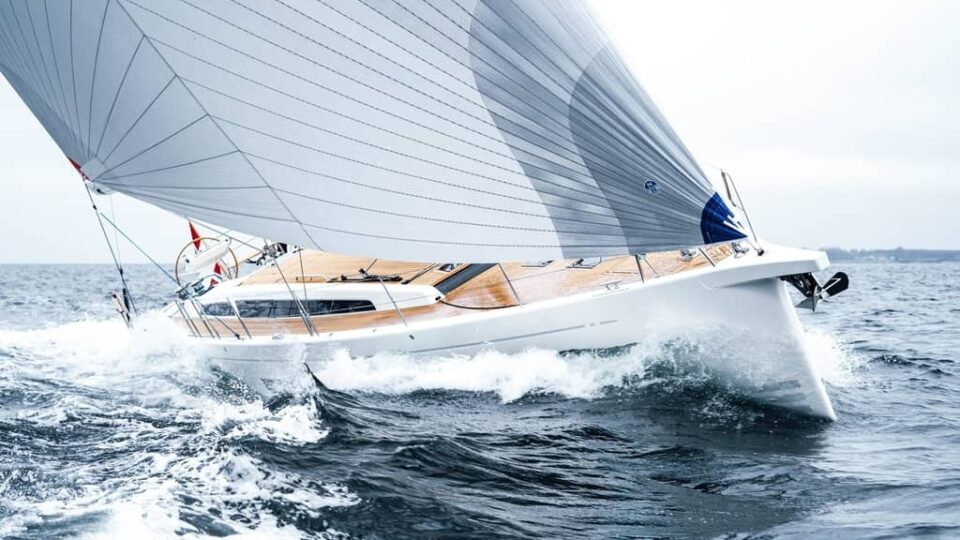

Names of Sails on a Sailboat
Are you a beginner sailor and want to get acquainted with the names of the sails? Are you an experienced sailor and want to learn more details about the sails on a sailboat? Then this article is written for you! Sails form a crucial part of the sailboat because without them, there’s no starting up. For that reason, there are many details about different types of sails concerning their utility, functionality, fabrication materials, and performance. Simply put, each sail serves different purposes when out on the water. Since the sail is the engine of your sailboat, in terms of it being the basic source of propulsion, it’s important to know when best to use either type of sail and why.
Types of Sails on a Sailboat
So, in order to better explain the types of sails, let’s look at their characteristics. The first important distinction between sails is their placement. Generally, the mainsail is placed aft of the mast , which means behind. On the contrary, the headsail is in front of the mast. There are also other sorts of sails that are used for specific conditions. These can be the spinnakers or balloon-shaped sails for downwind use. The second important distinction for the sails is their functionality. The specialized sails have different functionalities and are used in different sailing circumstances and weather conditions. A rule about sails is that large sails are appropriate for downwind use, whereas small sails are good for upwind use. Moreover, large sails perform better on weak winds while small sails are good for strong winds.
The Parts of a Sail and its Shapes
- Head: This is the top of the sail.
- Luff: The forward edge of the sail.
- Leech: Back edge of the sail.
- Tack: The lower front corner of the sail.
- Clew: The bottom back corner of the sail.
- Foot: Bottom of the sail.
There are two sail shapes, the fore-and-aft rigged sails, and square-rigged sails. Nowadays, fore-and-aft sails are more popular, have better performance and maneuverability. To grasp the idea square sails are the ones that Vikings had on their ships and are good at sailing downwind because they run from side to side. But they’re not suitable at all when sailing upwind. On the other hand, a fore-and-aft sail is tied from the front of the mast to the stern and is much better at sailing upwind.
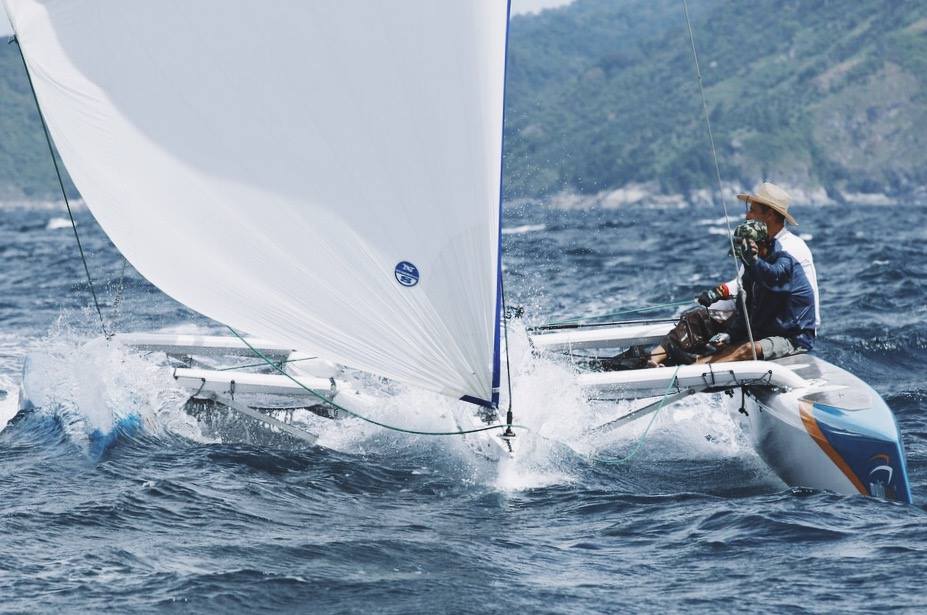
Also Read: What is Sailboat Rigging?
Types and Names of Sails
There are a lot of reasons why you’d want to put one sail over another, but the most important thing to remember has to do with the point of your sail and the wind strength. These points help you understand how your sailboat generates wind power. These points of sail include: into the wind (in irons), beam-reaching, broad-reaching, close-hauled, close-reaching, and running. They all go from windward to leeward and are symmetric from port to starboard . So, let’s get to the point and see the names and explanation of each sail:
- Mainsail : The large sail behind the mast which is attached to the mast and the boom, is called the mainsail. Mainsails cover a lot of surface area concerning incoming winds and by doing that they don’t need very strong winds to provide forward propulsion on a sailboat.
- Headsail or Jib : The small sail placed in front of the mast, attached to the mast and forestay (ie. jib or genoa), is called the headsail. Headsails are smaller than mainsails, thus their surface area is smaller. As a result, they can’t catch the same wind as a mainsail does. However, this is important because in case that the current wind is strong and the mainsail has been enough trimmed, being able to remove the mainsail and depend on the headsail alone, is a good strategy in order to reduce speed.
- Genoa : A genoa is like a large jib and it’s attached to the front of the forestay, like a headsail. When you use a genoa sail then you are expecting light to medium winds. Also, your sailboat would be somehow in a rush point of sail, meaning that the wind comes directly from the rear. Moreover, the surface area of a genoa sail is quite large, so it’s important to use it when winds are relatively low.
- Spinnaker : These downwind sails are symmetrical which makes them more sensitive to the reaching points of the sail and therefore more suitable for the running point of sail. Spinakkers are lighter than other types of jibs, and they don’t cover the mast like a genoa sail. Moreover, they remain unattached to the forestay and stretch out toward and past the bow of a sailboat.
- Gennaker : Gennakers are a mixture of genoa and spinnaker sails. There are small and big gennakers and both are downwind sails. They aren’t as symmetric as a spinnaker and aren’t attached to the forestay like a headsail. Furthermore, the gennaker sail is able to take on a more flexible point of sail while taking advantage of softer winds.
- Drifter Reacher : A drifter is a light air sail, and it’s basically a larger genoa for use in light winds. Its extra sail area offers better downwind performance than a genoa. It’s mostly made from lightweight nylon.
- Code Zero Reacher : This sail is a type of spinnaker, but it looks like a large genoa. However, code zero is designed for better reaching which makes it much flatter than the spinnaker.
- Windseeker : This sail is small, and it’s designed to guide light air onto the lee side of the mainsail. Moreover, it’s tall and thin and ensures a smoother flow of air.
Sail and Mast Configurations
Now that you got an idea of the different types of sails on a sailboat, it would also be an advantage to know how these types of sails are related to the configuration of a sailboat’s mast. There are numerous combinations when it comes to sails and mast configurations, let’s see some of them!
- Cat: A cat is similar to a dinghy and has one mast and one sail. The mast is located at the bow of the sailboat.
- Sloop: The sloop has the classic single mast and a double sail setup. The headsail can be different kinds of jibs, is connected with the forestay on the mast, and runs all the way up to the mast.
- Fractional Rig Sloop: A fractional rig sloop is different from the sloop because its forestay doesn’t reach the top of the mast. Its headsail is restricted to a fractional amount of space and this means that less wind can be captured, therefore the speed of the sailboat is reduced.
- Cutter: Having two forestays on the mast and cutters that are able to house two headsails this setup allows easy cruising because it offers a wide combination of points of sail for different strengths of wind.
- Ketch: Just like a sloop the ketch has a mast that enables the mainsail and headsail to a full range forestay. However, it also has a smaller mast between the mainmast and the stern of the sailboat.
- Schooner: A schooner is when a sailboat has two or more masts but it has a couple of sails to manage. A schooner’s aft mast is taller than the forward mast and sometimes a schooner can have up to six masts.
Names of Sails on a Sailboat – Summary
So, how many types of sails are there? In general, sailboats have one mainsail and one headsail. The rigging also affects the types of sails you can use. As we’ve explained before, the mainsail is a fore-and-aft Bermuda rig. Then, for a headsail, we use a jib or genoa. Most experienced sailors use extra sails to ensure better performance for their sailboat. For example, the spinnaker (a common downwind sail), the gennaker, the code zero (for upwind use), and the storm sail. Keep in mind that every sail has its own use and performance. Want to go downwind fast? Use a spinnaker. Don’t just raise any sail you think suits you best and go for it! It’s of great importance to understand the functionality, use, and performance of each sail.
Peter is the editor of Better Sailing. He has sailed for countless hours and has maintained his own boats and sailboats for years. After years of trial and error, he decided to start this website to share the knowledge.
Related Posts

Lagoon Catamaran Review: Are Lagoon Catamarans Good?

Best Inboard Boat Engine Brands

Are O’Day Sailboats Good? A Closer Look at a Classic Brand

Why Do Sailboats Lean?
- Buyer's Guide
- Destinations
- Maintenance
- Sailing Info
Hit enter to search or ESC to close.
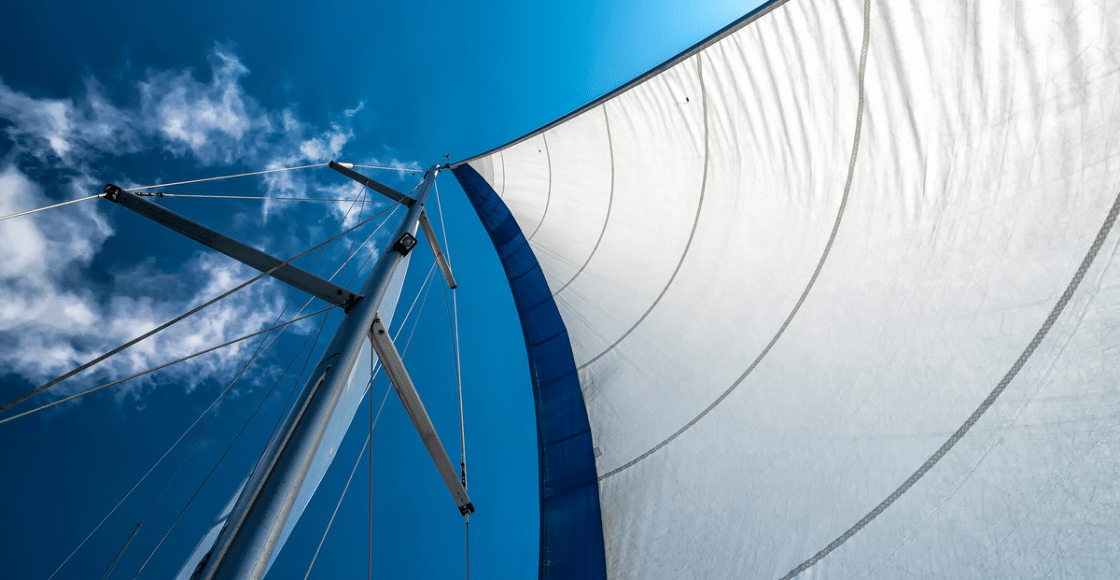
Type Of Sails: A Complete Guide

Table of Contents
Last Updated on September 29, 2023 by Boatsetter Team
If you are approaching sailing and sailboats from a very beginner’s perspective , then the concept of different kinds of sails can be a strange one. We often believe we see one kind of sailboat with one kind of sail, and our simple minds lead us to believe you are only meant to move them around, and you will get to where you need to go.
However, you would not have landed on this article if you did not suspect that there was more to sails and sailboats. So here, you can have a kind of in-depth, kind of summarized review of the different kinds of sails and the most popular sail and mast configurations out there.
It is also important to understand why there are so many different kinds of sails. When you are out on the water, different weather conditions can occur. Your sail acts as a motor of some sort, moving your sailboat forwards, but your sail is also highly dependent on the wind conditions around it. This is why having different kinds of sails can help you navigate your weather conditions and turn them to your own advantage while sailing.
Different sails also come with different danger levels in case of strong wind, so knowing what kinds you might need to watch out for is also extremely important. So, without further ado, let us get into it.
You may have heard of this one before or seen it portrayed in movies and TV shows. As the name suggests, the mainsail is the most popular kind of sail on any sailboat, and they are found behind the mast. They are also attached to the boom. Because they take up so much space on your sailboat, they are also one of the most important sails to take care of and keep an eye on.
Since the mainsail is such a large sail, it does not require too strong a wind to propel it forward , as its large surface area will easily catch a breeze. At the same time, the fact that it can be moved around by moving the boom makes it, so it is easy to steer. This makes it so that the mainsail is the most important sail on your sailboat.
Headsail/Jib
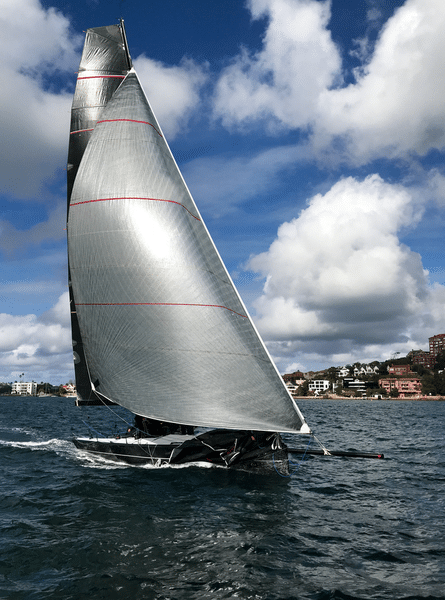
The headsail, or the jib, is likely the second most popular kind of sail found on sailboats. This is because it often accompanies the mainsail, the most popular kind. On all sailboats , the headsail is put at the front of the mast over the sailboat’s bow . It is always a smaller sail than the mainsail.
The fact that the headsail is smaller can be especially useful if you are caught in strong winds. In this situation, you likely do not want to use your mainsail (or trim it as much as possible) to move slower and not be thrown around by the winds. Smaller sails catch less wind, meaning they do not propel your boat as strongly as larger sails.
Having a good headsail can be an incredible safety measure, especially if the seas you are trying to sail are known to be wild and unpredictable.
You may have seen a genoa sail before if you have been around boats or have ever lived in a coastal town. This kind of sail is a large sail that you can attach to the front of the forestay (similarly to the headsail). This is a larger sail than the headsail and can even cover the mainsail either partially or completely. For this reason, the genoa also used to be called an “overlapping jib.”
You should use a genoa if you are sailing through either light or medium winds and if your sailboat is at a dead run point of sail (this means that the wind is coming directly from the rear. If you attempt to use a genoa sail in stronger winds , you might start going too fast and put yourself and your boat at risk since it is such a large sail. So, it is important to be careful .
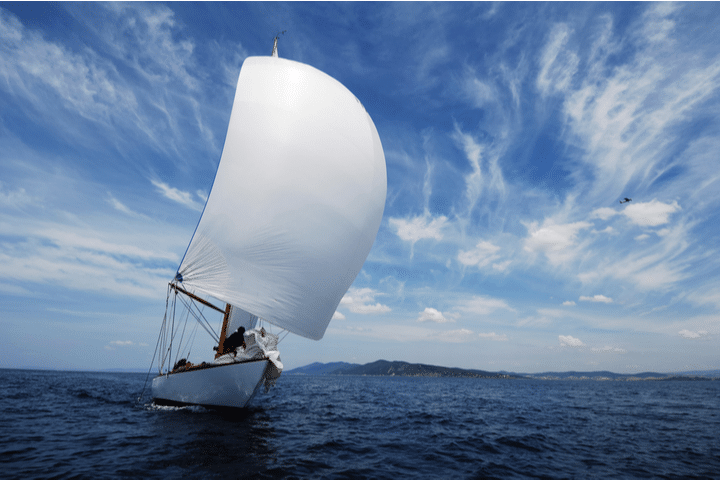
The spinnaker is the most whimsical kind of sail since it is a large and colorful kind. They are also often symmetrical, which means they are more appropriate for reaching different points of sail, such as the running point of sail. They are lighter sails, and they do not cover the mast as the genoa sail does. You do not attach a spinnaker to the forestay and instead let it stretch out past the boat’s bow.
The large surface area of the spinnaker means that you have to be even more careful than with others on the kind of conditions you choose to use this sail in. If the winds are too strong, you could be putting yourself and your passengers at serious risk using this sail, so you should choose to use it only at times when the wind is low or in seas that are known for their low winds and tranquility.
As the name suggests, the gennaker sail mixes the genoa sail and the spinnaker sail. These kinds of sails are more recent inventions. They are as large as the spinnaker sail, but they are not symmetrical. Unlike the genoa or the headsail, they are also not meant to be attached to the forestay, like the spinnaker sail.
The usefulness of this sail is that if the winds change from a pure dead run to a reaching point of sail, then sailors do not have to resort to using a spinnaker from a genoa, instead of being able to take advantage of different winds while still using the same sail as they were before. This kind of sail is still only meant for lighter and milder winds , but there is more flexibility with the gennaker than the genoa and the spinnaker sails.
Popular Sail and Mast Configurations
There are many different ways to place the sails we have learned about in the above section. We have compiled a list of some of the most popular ones so you can understand how these sails can be used to make a sailboat move through the oceans.
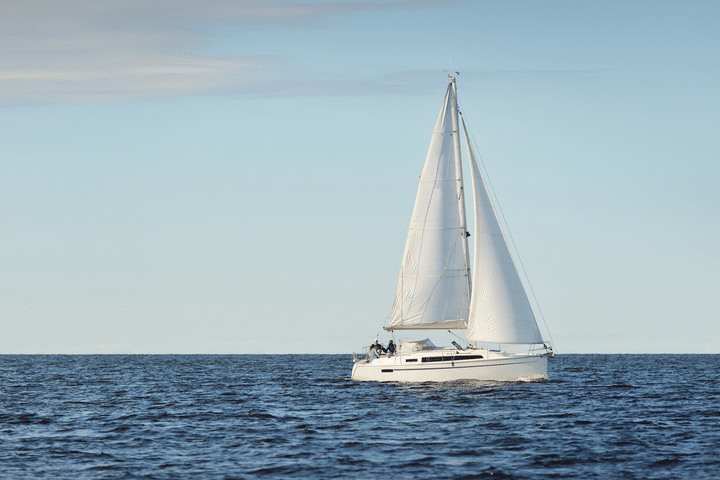
A sloop is by far the most popular configuration. It features a single mast, double sail (the mainsail and the headsail), and mast configuration. The headsail is located from the forestay on the mast to the top of it. The type of headsail used can also vary from a genoa, a spinnaker, or a gennaker sail.
Fractional Rig Sloop
A fractional rig sloop also features a single mast with a double sail setup similar to a sloop. However, what makes the fractional rig sloop different is that the forestay does not reach the top of the mast. This means the headsail is constricted to a smaller amount of surface than on a regular sloop, making it so that your sailboat captures less wind and moves slower .
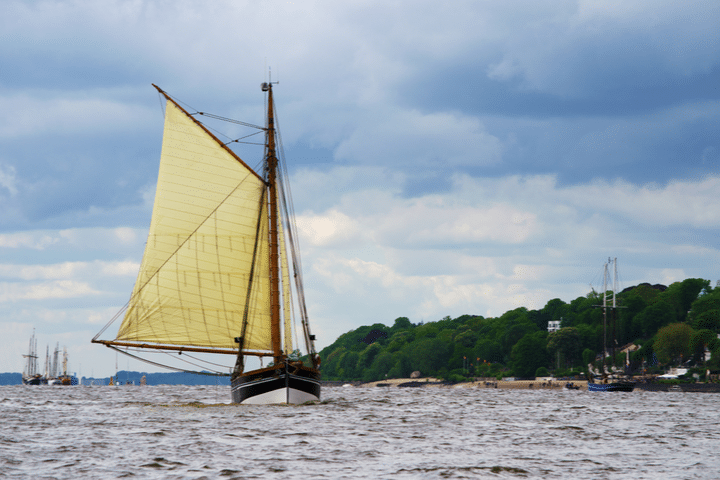
Cutters are interesting because they’re like a sloop but with a second forestay. This can be useful because it allows them to carry two headsails (a mainsail and one of the jibs). Cutters are good for cruising because they offer a range of wind options, giving you more time to get from place to place.
This is a less common mast configuration than previous others on this list. This is because a ketch features two masts. There is a larger mast fit for the mainsail and the headsail and a smaller mast between the mainmast and the stern (the rear) of the boat. This kind of mast configuration is more commonly found among Northern European freighters or fishing boats. This mast configuration is also called the mizzen mast.
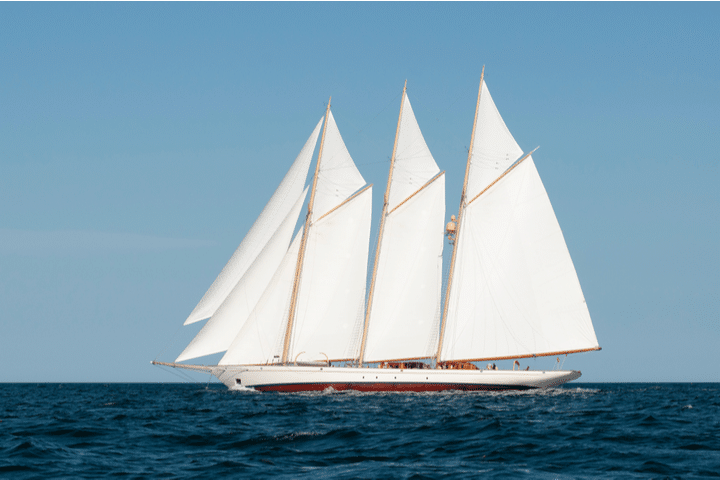
A schooner mast configuration features two or more masts. This is similar to the previous configuration, the ketch. It also features multiple sails. While a ketch’s aft mast (also known as the rear mast) is higher than the forward mast, a schooner’s aft mast is shorter than the forward mast. A schooner can also have up to six masts (although two are the most common). These are the main differences between the two.
This one is quite similar to a ketch mast configuration (mentioned above). The only real difference between them is that the mizzen mast is put directly behind the sailboat’s rudder post in a yawl.
A cat sail will have one mast and one sail. The mast is put at the bow of the sailboat. This kind of mast configuration is often found on smaller boats, more specifically on dingy boats. Boats with the cat mast configuration are also often called catboats.
Final Verdict
Having the appropriate kind of sail on your sailboat is incredibly important. At the same time, being aware of the kinds of sails that there are and the kind of sail and mast configuration can make you into a more well-rounded and informed sailor. With that in mind, we hope that you leave this article feeling more confident in your skills when you are out at sea.

Boatsetter empowers people to explore with confidence by showing them a world of possibility on the water. Rent a boat, list your boat, or become a Boatsetter captain today.
Browse by experience

Explore articles
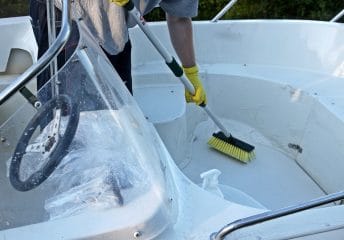
How to Make an Old Boat Look New
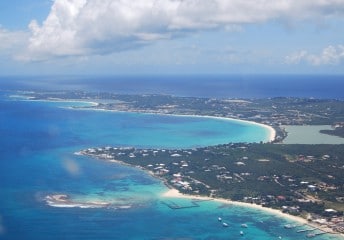
A Weekend in Anguilla: Your Perfect Two-Day Itinerary

Marinas on Lake Pleasant, Arizona
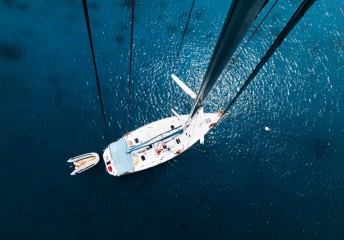
Guest Post: What sailing can teach you about saving for retirement
No products in the cart.
Sailing Ellidah is supported by our readers. Buying through our links may earn us an affiliate commission at no extra cost to you.
The Most Popular Types Of Sails On A Sailboat
A sloop-rigged sailboat typically features a mainsail, a headsail, and an additional light-wind sail, such as a spinnaker or Gennaker. The mainsail is rigged aft of the mast, while the headsail is attached to the forestay. The two most commonly used headsails are the Genoa and Jib.
The sails are vital parts of a sailboat since you obviously couldn’t sail without them! There are many different sails depending on the type of sailboat and its rig configuration, and we’ll walk through them together in this article.
The different types of sails on a sailboat
We can divide the selection of sails on a sailboat into three categories:
- Standard sails
Light-wind sails
- Storm sails
Each category serves different purposes depending on the vessel’s rig configuration and the sail’s functionality.
The standard sails
The standard sails usually form a sailboat’s basic sail plan and include :
- The Mainsail
- The Staysail
- The Mizzen sail
These sails are the ones that are used most frequently on sloop, ketch, and cutter-rigged sailboats and are usually set up to be ready to use quickly.
Headsails are often rolled up on a furler, while the main and mizzen sail are stored on the boom or furled into the mast.
The halyards and sheets are kept within easy reach, making these sails the primary choice in most situations. Let’s dive further into each of them.
The mainsail is a triangular sail that flies behind the mast on top of the boom . Although it may not always be the largest sail on the vessel, we commonly refer to it as “the main.”
It is a vital sail, and keeping the sail shape trimmed properly on every point of sail is crucial for the stability and performance of the boat.
A Jib sail is a headsail that does not overlap the mainsail. It is typically between 100% and 115% of the foretriangle but can also be smaller. The foretriangle is the triangular area formed by the mast, deck, and forestay. The Jib is often used with a self-tacking system involving a sheet traveler in front of the mast.
This sail is often seen on newer boats with fractional rigs, which typically have a larger mainsail area than the headsail area. However, the Jib is versatile and also used in other configurations.
People often mix the terms Genoa and Jib. Many refer to any headsail as a Jib, which is incorrect. I personally prefer to use the correct terms to avoid confusion .
A Genoa sail resembles a large Jib but extends past the mast and overlaps the mainsail. Genoas are usually larger than 115% of the foretriangle , with sizes ranging from 120% to 150%. They are often used on vessels with masthead rigs and smaller mainsails but are also common on fractional rigs.
The Staysail is typically found on cutter rigs and is set on the inner forestay or cutter stay. It can be combined with other sails, such as a Jib, Genoa, or Yankee, or on its own in stronger winds.
The Staysail is also useful when sailing downwind, as it can be paired with a headsail and extended to opposite sides of the boat using a pole.
The Yankee sail resembles a Genoa and Jib but has a high-cut clew. This shape allows for improved airflow when used with another headsail. The Yankee is often used on cutter-rigged boats in combination with a staysail and is known for its versatility in different wind conditions.
Mizzen Sail
A mizzen sail is similar to the mainsail, only smaller . It is set on the aft mast of a boat with multiple masts, such as a ketch rig. The mizzen sail is usually used to provide balance and stability to the vessel and provides additional power when sailing downwind.
Another handy usage is to fly the mizzen at anchor to keep the bow up against waves and swell.
The light-wind sails are large, made of thin nylon, and typically shaped like a half-balloon. They are a type of headsails that are great when the winds are too light to fill the standard headsail and are often used when sailing downwind.
The four most commonly used light-wind sails are:
- The Spinnaker
- The Gennaker
- The Code Zero
- The Parasailor
They all provide excellent forward propulsion on a sailboat but usually require some extra rigging to be set.
Experienced cruisers love to use light-wind sails in nice weather, but they have a critical weakness to be aware of. These sails easily get overpowered when the wind increases, and I strongly advise being careful and observant of the wind conditions when flying them.
(Yes, I have managed to rip mine on one occasion due to getting overpowered, but that’s a different story…)
Let’s continue and take a closer look at each of the light wind sails.
A Spinnaker sail is a large, lightweight downwind sail used at deep angles between 120 and 180 degrees. It is symmetrical in shape with two clews and is often brightly colored.
The Spinnaker is set by using a pole to extend the sail’s clew to the vessel’s side. Then, a sheet is attached to the other clew and led back to the stern of the boat.
A Gennaker sail combines the characteristics of the Genoa and Spinnaker. It is made of nylon like the Spinnaker but is asymmetrical like a Genoa and rigged slightly differently. The tack is attached to the bow, and the clew has a sheet led aft to the cockpit. The Gennaker can be equipped with a snuffer to make it even easier to set up and take down.
It is popular among cruisers because it is simpler to use than a spinnaker and it doesn’t require a pole. The sail is effective at angles between 90 degrees and almost all the way down to 180 degrees, making it versatile for various light-wind conditions.
A Parasailor is similar to the Spinnaker in many aspects but has some distinct differences. It has a double-layer wing that inflates as the sail is filled with air, creating a batten-like effect pushing the leech out while providing lift to the bow.
The wing also helps to prevent the rolling movements you get with a Spinnaker and the collapsing of the leech that can occur with a Gennaker at deep angles.
This makes the parasailor effective at sailing angles between 70 and 180 degrees dead downwind. Parasailors can be set like a Gennaker when reaching or with a pole like the Spinnaker for running downwind.
A Code Zero sail combines some elements of the Genoa and Gennaker. Unlike the Gennaker, the Code Zero has a different shape, allowing it to be used while sailing upwind.
Another benefit is that it can be used with a furler which makes it easy to roll in and out. However, it can’t replace the Gennaker or Spinnaker entirely, as it is not effective at sailing angles deeper than 120 degrees.
If you see a big yacht with three forestay’s, the forward one probably holds a code zero sail. A bow spirit allows the ability to fly additional light wind sails as well!
Storm Sails
The storm sails consist of a small Mainsail and Jib in heavy-duty materials designed for rough conditions. These sails enable us to maintain speed and stability in the boat in severe weather too strong for the standard sails.
Storm sails are often brightly colored , such as red, orange, or yellow, to make them more visible at sea.
Storm Mainsail
A storm mainsail is used when the reefing setup doesn’t allow the standard mainsail area to be reduced enough to prevent overpowering. The sail can handle rough conditions and is excellent for maintaining stability.
A storm Jib is used when the headsail has been furled to the point where it is no longer effective. It is especially useful for sailboats rigged with a Genoa, as the Genoa gets inefficient when heavily reefed. As the storm Jib is smaller than the standard headsail, it also lowers the center of gravity, making the vessel heel less and become more stable.
Explaining the terms for the parts of a sail
Let us talk some more about sails. The goal is to go sailing, right?
Identifying the different parts of the sails is crucial to understanding which lines go where.
Let’s zoom in on a sail and break down the terms :
The head is the top corner of the sail . Most mainsails have a headboard or plate where the halyard is connected, while headsails use a metal ring. A halyard is a line we use to raise and lower sails with.
The leech is the aft part of a sail , located between the clew and head. We use a combination of the outhaul, main sheet, and traveler to trim and adjust the leech on the mainsail.
The headsail’s leech is trimmed by adjusting sheet tension and angle according to the wind speed and direction. A traveler is a track with a movable car or pulley system for adjusting the position and angle of a sheet, and most sailboats have one main traveler for the mainsail and car tracks along the side decks for the headsail.
The luff of a sail is the front part of the sail between the tack and head. On a mainsail, the luff runs vertically along the mast and along or close to the forestay on a headsail. Headsails are often equipped with luff foam to help maintain their shape when partially reefed on a furler.
Battens are slats or tubes inserted into pockets on the mainsail to help the sail maintain its shape and increase its lifespan . A traditional sail hoisted and lowered on the boom typically has horizontal battens. Vessels with in-mast furling can use vertical battens instead of horizontal ones.
- A fully battened Mainsail has the battens run through the entire sail length from the luff to the leech.
- A standard battened main sail has the battens along the sail’s leech.
Telltales are small ropes, bands, or flags attached to a sail to give an indication of the airflow around the sail. They help us understand how the wind affects the sail and allow us to fine-tune the trim for optimal performance. Telltales are usually found on the mainsail’s leech and in the front of the headsail’s leech.
The clew of a sail is the lower aft corner and where the outhaul is connected on a mainsail. Headsails have sheets attached to their clew for controlling and trimming the shape and tension.
The tack is the lower, forward corner of a sail. On a traditional Mainsail, the tack is attached to the Gooseneck, a hinge in front of the boom attached to the mast.
With in-mast furling, the tack is connected to the furling mechanism. This mechanism is used to roll the sail into the mast.
The headsails tack is connected to a furler drum on the forestay on most sailboats. Vessels using traditional hank-on headsails connect the tack to a fixed point on the bow.
The foot of the mainsail is the bottom portion of the sail between the clew and the tack. It is trimmed using the outhaul, a line attached to the clew, and used to adjust the tension on the foot of the sail. Some mainsail are configured loose-footed, and others are attach-footed.
The foot of the headsail is trimmed by adjusting the tension and angle of the sheets, which are the lines used to control the headsail’s clew. We use cars, or pulleys, to adjust the angle of the sheets and thus the trim of the headsail.
Traditional and less commonly seen sails
We’ve now looked at the most commonly used sails and walked through the different parts of them. But what about the less common ones? The art of sailing has a rich history, with some unique sail designs that we rarely see today.
Read on if you want to peek into some traditional sails, or skip straight to popular sail and mast configurations here.
Square sails
Square sails are rectangular and usually set across a ship’s mast, mostly seen on traditional square-rigged sailing ships and Viking ships. These sails are efficient for downwind sailing and are hung from horizontal spars called yards. Though not as agile as modern fore-and-aft sails when sailing upwind, they were central to naval exploration for centuries. Today, they’re mainly seen on traditional vessels and tall ships, symbolizing maritime heritage.
If you’ve been to Martinique in the summer, you may also have noticed the round skiff sailboats the local fishermen traditionally used for fishing in the Atlantic Ocean with their distinctive big squared sails. Tour de Martinique des Yoles Rondes is a popular yearly event where the locals race and show off these beautiful old boats with colorful sails!
A gaff sail is a traditional four-sided sail held up by a horizontal spar called the “gaff.” They are used on classic gaff-rigged sailboats and allow for a larger sail area with a shorter mast. Gaff-rigged boats were traditionally popular and usually carried 25% more sail area than the equivalent Bermudan rig, making them fast on a downwind run. The Gaff rig could also carry a topsail between the gaff and the mast.
However, they don’t sail well to windward, and modern designs have shifted towards triangular sails for better upwind performance.
Jib-headed topsail
The Jib-headed topsail is a small triangular sail used on gaff rigs and is set between the gaff and the top of the mast.
A lug sail is an angled, four-sided sail that attaches at a point on its top side, making it hang tilted. The sail is simple to use and often found on smaller or older boats. There are different types, like standing, dipping, and balance lugs, each hanging differently around the mast.
The lug sail evolved from the square sail to improve how close the vessels could sail into the wind. Because of their upwind performance, fishermen used them widely in Europe from the seventeenth through the nineteenth centuries.
Sprit sails
The spritsail, with its unique four-sided design, stands out thanks to a diagonal support called the “sprit.” It was traditionally popular in Thames sailing barges due to its ability to accommodate high-deck cargo. These days, it’s primarily found in smaller boats like the Optimist dinghy in a variant called “leg of mutton spritsail.”
The spritsail was also used in traditional wooden boats like the fearing version of the Oselvar wooden boat traditionally used in western Norway.
It is also commonly used by the indigenous Guna Yala tribes in Panama in their dugout Ulu’s up to this day. We saw plenty of them when we cruised along the coast, and some of them approached us to sell us their delicious catch of the day!
Lateen sails
A lateen sail is a triangular sail set on a long spar angled on the mast. It was originally popular in the Mediterranean and on Arab shows, and its design enhanced maneuverability and played a crucial role in historic sea exploration.
The lateen sail was used on lateen rigs, the predecessor to the Bermuda rig – one of today’s most commonly used rigs!
Which brings us to the following topic:
Popular sail and mast configurations
There are many different rigs and sail configurations between sailing vessels. From the old-school square rigs to schooners, gaff rigs, and more. However, this article will focus on the three most popular rigs seen on modern sailboats:
- The Bermuda Sloop Rig
- The Cutter Rig
- The Ketch Rig
The three rigs have similarities and differences between their sail and mast configurations. We’ll walk through each of them to understand how they utilize their different types of sail.
If you want to learn more about other rigs, take a look here .
Bermuda Sloop Rig
The Bermuda sloop rig is the most common rig on modern vessels. It is characterized by a single mast, a triangular mainsail, and a headsail. This rig is named after the Bermuda Islands, where it was developed in the 17th century.
Some of the key features of the Bermuda sloop rig:
- The mast is typically tall and raked, which allows for a large sail area and excellent stabilit y.
- The mainsail is attached to the mast and boom. It is usually combined with a single headsail at the front of the boat, making it powerful and easy to sail.
- The Sloop is usually equipped with a masthead or fractional rig and flies a Jib or Genoa as its primary headsail.
The Bermuda Sloop rig is known for its simplicity, is often used for racing and cruising, and is popular among sailors worldwide.
The cutter rig is very similar to the sloop rig. The significant difference is that it has a single mast and two headsails – a Staysail and a Yankee. The cutter rig is known for its versatility due to the multiple options in sail plans and the double headsail setup.
Some key aspects that separate the Cutter from the Sloop:
- The rig is often more robust than its Sloop sister because of the additional cutter stay and running backstays.
- The mast is located closer to the center of the boat.
- The Cutter has a staysail on the inner forestay and a Yankee sail on the outer. The sails can be used in combination with each other or independently.
- Tacking the headsail between the forestay and cutter stay is more involved than on a sloop.
- The Cutter rig has two similar variations: the Slutter rig and the Solent rig.
Like the Sloop, the Cutter rig is relatively easy to operate. Still, the additional headsail and rigging make it costlier to maintain. It is also less suitable for racing than the Sloop, but the added versatility helps in different weather conditions and makes it an excellent choice for cruisers.
The ketch rig is also similar to the Sloop but has an additional mizzen mast placed further aft of the main mast. Another mast gives it the advantage of even higher versatility in sail plans. The ketch typically uses three sails. The mizzen sail, a mainsail, and a headsail. The mizzen mast also allows it to fly a second light-wind sail.
Here are a few more distinctions of the ketch rig:
- The ketch typically carries a smaller mainsail than a similarly sized sloop and a smaller mizzen sail.
- A small mizzen and a medium mainsail are easier to handle than one large mainsail.
- The additional mizzen sail makes the vessel easy to balance and gives extra stability downwind.
- The ketch usually doesn’t point as close to the wind as the Sloop and Cutter.
The headsail setup on a ketch is generally the same as for the Sloop. But the ketch can also be rigged as a cutter ketch, which gives it the benefits of the cutter rig! The tradeoff with a cutter-rigged ketch is the higher complexity and additional rigging, hardware, and sails required.
Final words
Well done, you now have a good grasp of the most common sails and their strengths. We have discussed a few rigs and how they utilize different kinds of sails in various sail plans. Remember that more sail types, other rigs, and even more variations are available. It is a complex topic, but this guide covers the basics and gives you a great starting point.
If you still have questions, look below at the FAQ, or leave me a comment. I’m more than happy to help you out!
A sailboat is only as good as its sails, and sails need wind to work. The next logical step is learning how the wind works when we sail and practicing some wind awareness! Head to the following guide to continue your research: Learn The Difference Between True And Apparent Wind Speed.
FAQ: The Different Types of Sails On A Sailboat
What is the foretriangle on a sailboat.
The foretriangle on a sailboat refers to the triangular area formed between the mast, forestay, and deck. If you want to order a new headsail, for example, you’ll have to measure and supply the sailmaker with these details.
What is the difference between a loose-footed and attached-footed mainsail?
A loose-footed mainsail is attached to the boom only at its corners, leaving the rest of the sail’s bottom edge free. An attached-footed mainsail, on the other hand, is secured to the boom along its entire length. The main difference lies in how the bottom of the sail connects to the boom, with the loose-footed design offering more adjustability in the sail shape.
What is a high-cut clew on a sail?
A high-cut clew refers to the design of a foresail, such as a jib or genoa, where the back lower corner (the clew) is raised or “cut” higher above the deck compared to standard designs. This design allows for better visibility beneath the sail and makes it easier to sail over waves without the sail touching the water, which is especially beneficial for offshore or blue-water cruising. Very high-cut clews are commonly seen on yankee sails on cutter-rigged sailboats.
What is luff foam on a sail?
Luff foam is a padded strip sewn into the forward edge of roller furling sails. It ensures the sail is appropriately shaped when partially rolled up, especially in strong winds. This foam not only helps with sail performance but also protects the sail when it’s furled.
What are the most common sails?
The sloop rig sailboat is the most common and usually features a mainsail, a headsail, and an additional light-wind sail, such as a spinnaker or Gennaker.
What are the different types of sails?
There are several different types of sails, and we can divide the most common into three categories:
The standard sails:
- Mizzen sail
The light-wind sails
The storm sails:
- Storm mainsail
- Storm jib
What is a spinnaker sail?
A Spinnaker sail is a large, lightweight downwind sail used at deep angles between 120 and 180 degrees.
What is a Jib sail?
A Jib sail is a headsail that does not overlap the mainsail and is set on the forestay. The Jib can also be set up with a self-tacking system, making it very effective when sailing into the wind.
Is Genoa sail the same as a jib?
People often mix the terms Genoa and Jib. The Genoa is different from a Jib sail as it is larger and overlaps the mainsail, whereas the Jib is smaller and does not overlap the mainsail.
What is a Genoa sail?
A Genoa is a headsail larger than the Jib extending past the mast and overlapping the mainsail. The advantage over the Jib is the larger sail area, making it more effective when sailing off the wind.
How many types of sail plans are there?
Sail plans refer to the configuration and arrangement of sails on a boat or ship. While there are countless customizations and variations, the three most common sail plans are:
Sloop: Characterized by a single mast, a triangular mainsail, and a headsail.
Cutter: Similar to a sloop but has a single mast and carries two or more headsails.
Ketch: Features two masts, with the aft mast (called the mizzen) shorter than the main mast.
What is a Mainsail?
The mainsail is a triangular sail that flies behind the mast on top of the boom.
What is a Gennaker?
A gennaker is basically an asymmetrical spinnaker. A hybrid sail that combines the characteristics of a Genoa and a Spinnaker, designed for sailing off the wind and often used in light to moderate wind conditions.
What is a Storm Jib?
A storm jib is a small, heavy-duty sail used in strong winds or stormy conditions. It is commonly used when the headsail has been furled to the point where it is no longer effective.
What factors determine the type of sail to be used?
The type of sail to be used depends on various factors such as wind conditions, points of sail, sailboat size , and sailing experience. It’s smart to choose the appropriate sail for optimal performance. A Jib, for example, will be more effective than a Genoa while sailing to windward, and vice versa.
How do sails affect the performance of a sailboat?
Sails are the engine of a sailboat. Their design, size, and trim influence the boat’s speed, direction, and stability. Properly adjusted sails capture wind efficiently, allowing the boat to move faster and in the desired direction.
The balance and condition of the sails also impact comfort and safety, with well-maintained sails ensuring optimal performance. The sails are essential in determining how a sailboat performs in various wind conditions.
Sharing is caring!
Skipper, Electrician and ROV Pilot
Robin is the founder and owner of Sailing Ellidah and has been living on his sailboat since 2019. He is currently on a journey to sail around the world and is passionate about writing his story and helpful content to inspire others who share his interest in sailing.
Your article gave me a lot of inspiration, I hope you can explain your point of view in more detail, because I have some doubts, thank you.
What specifically do you want my point of view on?
Leave a Reply Cancel reply
Your email address will not be published. Required fields are marked *
Sail Types: A Comprehensive Guide to 8 Types of Sails
Sailboats come in all shapes and sizes. And that means there are many types of sails on the market! For those who might not know, sails are made of canvas and use wind power to propel sailboats through the water.
Understandably, different sails are required for different types of sailboats . And sailboats are categorized by the number of hulls they have. Monohulls have a single-hull design, catamarans have two hulls, and trimarans have three. Generally, sailors use catamarans for upwind sailing (but they can be used to sail downwind in certain conditions).
The type of sail you'll need for your sailboat depends on the kind of sailboat you have. Additionally, sails are highly dependent on the wind and weather conditions. Therefore, it's always a good idea to have different types of sails on board to navigate the ever-changing weather conditions.
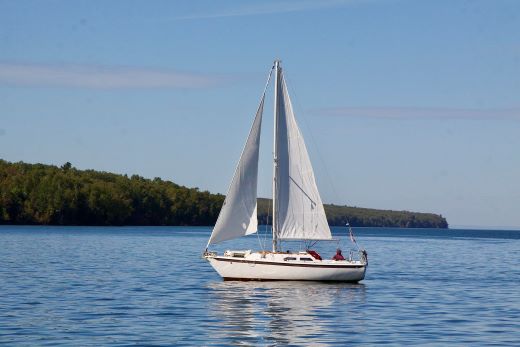
8 Types of Sails for Sailboats
As mentioned, you should carry multiple sails when sailing to prepare for various weather conditions. Here's a brief overview of the types of sails for sailboats:
1. Mainsails
The mainsail is the largest and most important sail. Therefore, it's probably the first sail to come to mind when you think of camping. Typically, it's situated directly behind the mast — connected to the boom — and uses wind energy to move the vessel. The mainsail plays a significant role in tacking and gybing, making it essential for any voyage.
Since the mainsail is a larger sail, it doesn't require wind to propel it forward. And the fact that it can be moved by moving the boom makes it uber-easy to operate.
Learn More About Sailing
2. Headsail
The headsail often accompanies the mainsail, though it is smaller in size. Regardless of your sailboat type, the headsail is positioned at the front of the mast – over the sailboat's bow.
Because headsails are small, they are helpful when navigating through windy conditions. Smaller sails catch less wind, preventing them from propelling your boat as strongly as larger sails. Additionally, headsails help lift, balance, and protect the vessel from inclement weather conditions.
While the term 'headsail' refers to any sail in front of the mast, the jib is the most common type of headsail. (And when a jib is so large that it overlaps the mast, it's called a genoa.)
Learn More About Sailboats
3. Genoa
The genoa is a large sail that attaches to the front of the forestay. (In this instance, it's similar to a headsail.) However, the genoa is larger than the headsail and overlaps the mainsail partially or completely to help the boat go faster.
Genoa sails are useful when sailing through light or medium wind. You can also use it when the wind comes directly from the rear. If you use a Genoa sail during high winds, you'll probably start sailing too quickly and put yourself and your boat at risk.
4. Spinnaker
The spinnaker is a large and whimsical (often colorful) sail. Spinnaker sails are usually symmetrical, allowing them to reach different points of sail. Generally, these are lighter sails and don't cover the mast like the genoa.
Because spinnaker sails are on the larger side, you have to be incredibly careful with them. Don't use them in rough conditions. Instead, save them for sailing in low winds and calm seas.
5. Gennaker
As the name suggests, the Gennaker sail combines a spinnaker and a Genoa sail. They are as large as the spinnaker, although they're not symmetrical.
They come in handy whenever the wind changes from a pure dead run to a reaching point of sail, as sailors can navigate various wind types with the same sail. It's still only meant for lighter and milder winds, but it's more versatile than the spinnaker and genoa.
6. Light Air Sails
Light air sails are useful in calmer conditions when the headsail and mainsail alone aren't cutting it. They include:
- Code Zero : A code zero sail is a gennaker sail ideal for sailing in light to mild winds. It's designed to create lift and boost boat speed whenever regular sails don't generate enough power. For that reason, many racers and cruisers use code zero sails to improve performance and gain control in various situations.
- Windseeker : This small, special sail is reserved for no wind or light wind. Essentially, it helps boats remain maneuverable in extremely calm conditions. And for that reason, it's valuable to long-distance sailors.
7. Storm Jib
Storm jibs can be used as a headsail whenever the weather is particularly rough and windy. Because it functions as a safety seal, it prevents boats from capsizing by reducing the sail area exposed to the wind. Therefore, it's a necessary sail for every sailor.
Read Next: Boating in Inclement Weather
During strong winds and storms, sailors can raise a trysail — a small, triangular sail near the boat's stern — for better control and stability. Generally, sailors do this whenever the mainsail becomes too large and challenging to maneuver.
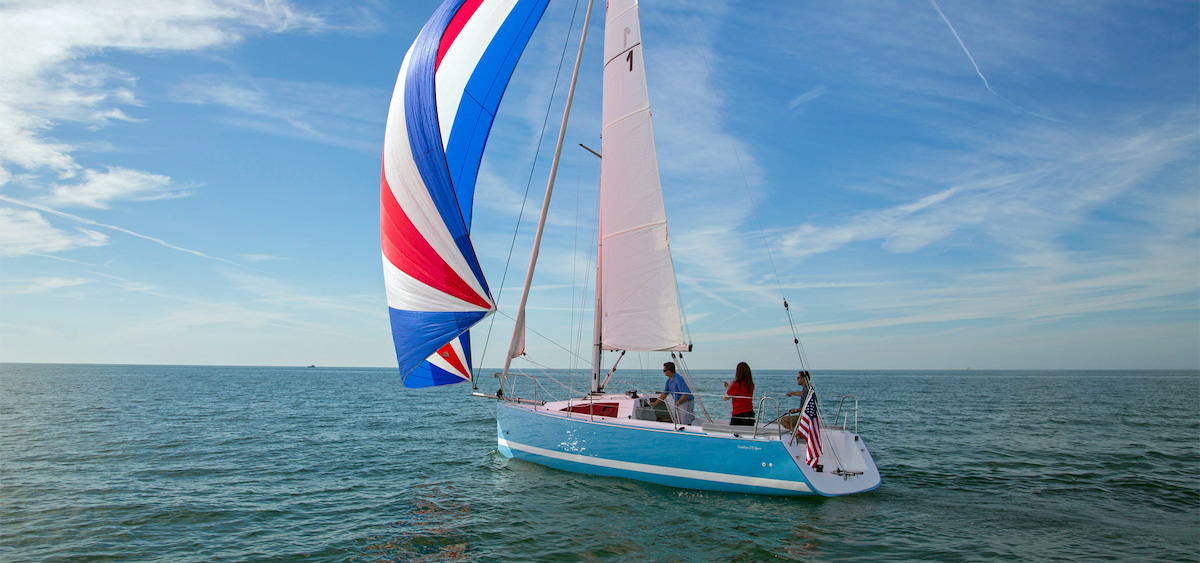
Join Our Newsletter!
Get community news, buying bargains, and how-to guides at your fingertips.
The different types of sails and their uses
Discover the different types of sails and their uses to optimize your sailing performance and enjoy the freedom and fulfillment of exploring the open sea.
The Different Types of Sails and Their Uses
Sailing is an incredible way to explore the world, spend quality time with family, and embrace the freedom of the open sea. As you embark on your sailing adventure, it’s essential to understand the different types of sails and their uses. This comprehensive guide will provide you with the knowledge you need to navigate your journey confidently.
Table of Contents
Introduction to sails, symmetrical spinnakers, asymmetrical spinnakers, sail materials and construction.
Sails are the driving force behind any sailing vessel, harnessing the power of the wind to propel the boat forward. They come in various shapes, sizes, and materials, each designed for specific sailing conditions and purposes. Understanding the different types of sails and their uses will help you make informed decisions when selecting sails for your boat and optimizing your sailing performance.
The mainsail is the primary sail on a sailing vessel and is typically hoisted on the aft side of the mast. It is a triangular sail with its leading edge (or luff) attached to the mast and its foot running along the boom. Mainsails are essential for providing the boat with forward propulsion and play a significant role in steering and balancing the vessel.
There are two primary types of mainsails: full-batten and partial-batten. Full-batten mainsails have horizontal battens that run the entire width of the sail, providing additional support and shape. Partial-batten mainsails have shorter battens that only extend partway across the sail. Full-batten mainsails tend to hold their shape better and last longer, while partial-batten mainsails are lighter and easier to handle.
Headsails are sails that are set forward of the mast and are used in conjunction with the mainsail to provide additional propulsion and balance. There are several types of headsails, each with its unique characteristics and uses.
A jib is a triangular sail that is set forward of the mast and is attached to the forestay, a wire that runs from the masthead to the bow of the boat. Jibs come in various sizes, with smaller jibs being more suitable for strong winds and larger jibs providing more power in light wind conditions. Jibs are essential for upwind sailing, as they help to direct the airflow around the mainsail, increasing its efficiency.
A genoa is a type of jib that is larger than a standard jib, extending past the mast and overlapping the mainsail. Genoas are designed to provide maximum sail area and power in light to moderate wind conditions. They are particularly useful for upwind sailing, as their large size helps to generate more lift and drive the boat forward. However, genoas can be more challenging to handle than smaller jibs, especially in strong winds or when tacking.
Spinnakers are large, lightweight sails designed for downwind sailing. They are typically set forward of the jib and are not attached to the forestay. Instead, they are held out by a pole called a spinnaker pole, which is attached to the mast and the sail’s clew (the lower aft corner of the sail). Spinnakers are used to catch the wind from behind, providing significant power and speed when sailing downwind.
A gennaker, also known as a cruising spinnaker or code zero, is a hybrid sail that combines the characteristics of a genoa and a spinnaker. Gennakers are designed for reaching and downwind sailing and are typically set on a furling system, making them easier to handle than traditional spinnakers. They provide more power than a genoa in light wind conditions and are more stable and easier to control than a spinnaker.
Downwind Sails
Downwind sails are designed specifically for sailing with the wind coming from behind the boat. These sails are typically larger and lighter than upwind sails, allowing them to catch more wind and generate more power. There are two main types of downwind sails: symmetrical spinnakers and asymmetrical spinnakers.
Symmetrical spinnakers are large, balloon-shaped sails that are designed for sailing directly downwind. They are symmetrical in shape, with the sail’s centerline running vertically down the middle of the sail. Symmetrical spinnakers are held out by a spinnaker pole, which is attached to the mast and the sail’s clew. This allows the sail to catch the wind from behind, providing maximum power and speed when sailing downwind.
Asymmetrical spinnakers, also known as gennakers or A-sails, are designed for reaching and downwind sailing at angles that are not directly downwind. They are asymmetrical in shape, with a longer luff (leading edge) and a shorter leech (trailing edge). Asymmetrical spinnakers are typically set on a furling system and do not require a spinnaker pole, making them easier to handle than symmetrical spinnakers. They provide more power and stability than a genoa in light wind conditions and are more versatile than a symmetrical spinnaker.
Storm Sails
Storm sails are small, heavy-duty sails designed for use in extreme weather conditions. They are used to replace the standard sails when the wind is too strong, providing better control and reducing the risk of damage to the boat and its rigging. There are two main types of storm sails: storm jibs and trysails.
A storm jib is a small, heavy-duty jib that is used in place of the standard jib in strong winds. It is typically set on the inner forestay, closer to the mast, providing better balance and control. Storm jibs are designed to withstand high wind loads and are made from durable materials, such as heavy-duty Dacron or laminate fabrics.
A trysail, also known as a storm trysail or storm mainsail, is a small, heavy-duty sail that is used in place of the standard mainsail in extreme weather conditions. It is typically set on a separate track on the mast, allowing it to be hoisted independently of the mainsail. Trysails are designed to provide better control and balance in strong winds and are made from durable materials, such as heavy-duty Dacron or laminate fabrics.
Sails are made from various materials, each with its unique characteristics and performance attributes. The most common sail materials include Dacron, laminate fabrics, and high-performance fibers, such as carbon and aramid.
Dacron is a durable, low-stretch polyester fabric that is widely used for cruising sails. It is relatively inexpensive and provides good performance in a wide range of conditions. Laminate fabrics are made by sandwiching layers of polyester or high-performance fibers between layers of Mylar film. These sails are lighter and more resistant to stretch than Dacron sails, providing better performance and shape retention. High-performance fibers, such as carbon and aramid, are used in racing sails and offer the highest levels of strength, durability, and performance.
Sail construction techniques also play a significant role in the performance and durability of a sail. Cross-cut sails are made from panels of fabric that are sewn together horizontally, following the natural lines of the fabric’s weave. This construction method is relatively simple and inexpensive but can result in a sail that is more prone to stretch and distortion. Radial-cut sails are made from panels of fabric that radiate out from the corners of the sail, distributing the loads more evenly and providing better shape retention and performance.
Understanding the different types of sails and their uses is essential for any sailor looking to optimize their sailing performance and enjoyment. By selecting the appropriate sails for your boat and the conditions you’ll be sailing in, you’ll be better prepared to navigate the open sea and embrace the freedom and fulfillment that comes from choosing an unconventional path.

Types of Sails: A Comprehensive Guide
In the enchanting world of sailboat dynamics, where the dance between wind and water takes center stage, the significance of sails cannot be overstated. Like the wings of a bird, these meticulously crafted sails unfurl to catch the slightest whisper of breeze, converting it into a powerful forward thrust that carries us through the vast expanse of the ocean. They are the very essence of a sailboat, the conduits through which dreams and aspirations set sail.
Join us on a captivating voyage as we unfurl the secrets of the myriad types of sails adorning the mastheads of sailboats across the globe. From the grandeur of the mainsail, proudly dominating the skyline, to the nimble headsails that steer with precision, and the enigmatic mizzensails that add an extra touch of finesse, we shall embark on a comprehensive exploration of the diverse array of sail types.
Different Types of Sails on a Sailboat: Why Use Different Sails at All?
Different sail types for different wind conditions.
Triangular sails, such as the mainsail and jib, are commonly used on modern sailboats to optimize performance when sailing upwind. The shape of these sails helps to create lift, which propels the boat forward even against the wind’s direction. The mainsail is attached to the mast at the front edge and a boom at the bottom. Jibs, on the other hand, are headsails that are attached to a stay near the bow of the boat.
Balloon sails, like spinnaker sails, are designed for downwind sailing and catching more wind to increase boat speed when sailing with the wind behind it. These types of sails have a large surface area that allows them to catch more wind than triangular sails. Spinnaker sails can come in different shapes depending on their intended use and can be flown from a spinnaker pole or directly from the bow.
Sail Plans: Different Combinations for Different Boats
Sail plans refer to how different types of sails are arranged and combined on a sailing craft. Sail plans can vary depending on specific design features and intended use of boats. For example, some boats may have multiple masts with several triangular-shaped sails attached while others may only have one mast with one triangular sail (mainsail) and one square sail (spinnaker). The combination of different types of sails can also affect how easy it is to handle a boat under certain conditions.
Understanding Sail Anatomy
Head, tack, foot, luff, leech, and clew. These are the different parts that make up a sail’s anatomy. But what exactly are they and why are they important? In this section, we’ll take a closer look at each part and how it contributes to the performance of a sailboat.

The Head: The Top of the Sail
Starting from the top, we have the head of the sail. This is where the halyard (the rope or wire used to hoist the sail) is attached. The head determines how high or low the sail sits on its mast. A higher head means more power but less control over the sail’s shape. Conversely, a lower head provides better control but less power.
The Tack: The Lower Front Corner of the Sail
Next is the tack which is found at the lower front corner of most sails. It’s where one end of a line called a “sheet” attaches to control how much wind enters through this corner of your sail. Adjusting your sheet will affect your boat’s speed and direction.
The Foot: The Bottom of the Sail
At the bottom edge of any sail lies its foot which helps determine its overall shape and size. Generally speaking, longer feet result in larger sails that provide more power while shorter feet result in smaller sails with better maneuverability.
The Luff: The Forward Edge of the Sail
The forward edge of any sail is called its luff which runs along its mast track or forestay depending on what type of rigging you have set up on your boat. It helps maintain proper airflow over your sails by keeping them from flapping around too much in high winds.
The Leech: The Back Edge of Your Sail
Opposite from your luff is your leech – or back edge – which helps create lift by allowing air to flow smoothly over your sail. A longer leech will result in a more powerful sail, while a shorter one will provide better control and maneuverability.
The Clew: The Bottom Back Corner of Your Sail
Lastly, we have the clew which is found at the bottom back corner of most sails. It’s where the other end of your sheet attaches to control how much wind enters through this corner of your sail. Adjusting your sheet here can affect how well you’re able to steer your boat.
Primary Sail Types
The main sail is attached to the main mast and boom and can be adjusted to match the wind conditions. Its main purpose is to keep the boat steady and under control by providing stability to the stern (back) of the vessel.
There are several variations of mainsails that sailors can choose from depending on their needs. One popular type of mainsail is an in-mast furling mainsail. This type of sail can be easily furled and unfurled by pulling a line, making it ideal for short-handed sailing or cruising. Another variation is a slab reefing mainsail, which has horizontal strips called battens that help maintain its shape. Finally, there is also a boom furling mainsail, which uses a roller system inside the boom to make it easier to handle.
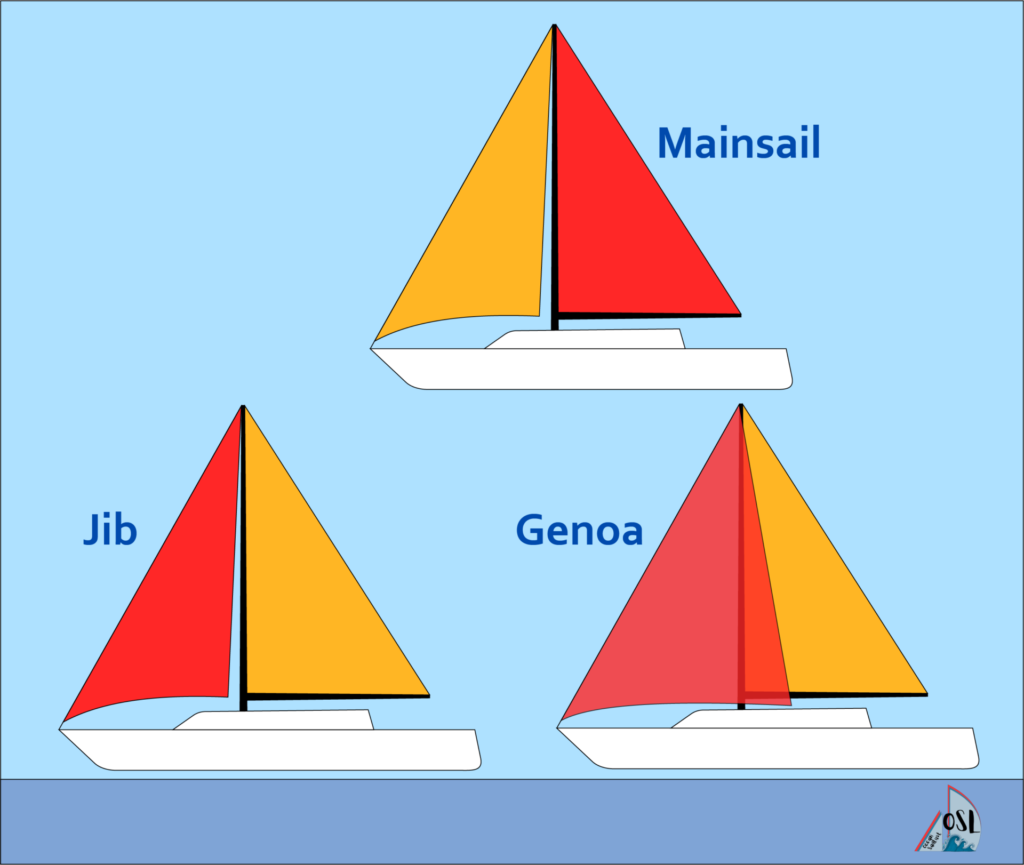
A headsail is any sail located forward of the mast on a sailing vessel. These sails are designed to work in conjunction with the main sail to provide optimal performance under varying wind conditions. There are several types of headsails available, each with its own unique characteristics and purposes.
One popular type of headsail is known as a genoa. This large foresail extends beyond the mast and overlaps with the main sail, providing additional power when sailing upwind or reaching across wind angles. Genoas come in various sizes ranging from 110% up to 150%, depending on how much overlap you want.
Another common type of headsail is called a jib. This smaller foresail does not overlap with the main sail but instead works in conjunction with it. The jib is typically used in higher wind conditions when a smaller sail area is needed to maintain control of the boat.
A staysail is a smaller sail located between the mast and the forestay. This type of headsail is typically used on larger boats to provide additional power when sailing upwind or reaching across wind angles. Staysails are often used in conjunction with other sails, such as a genoa or main sail.
Finally, there is also a mizzensail, which is located aft of the main mast on ketches and yawls. This sail provides additional power when sailing downwind or reaching across wind angles. Mizzensails come in various sizes and can be either fully battened or free-flying.
Lightwind Sails
Spinnaker sails are a type of downwind sail that can be used to increase boat speed when sailing in light winds. They are typically used in wind conditions below 10 knots, which are considered light air sails. Spinnakers come in two types: symmetrical and asymmetrical.

Symmetrical vs Asymmetrical Spinnaker
The symmetrical spinnaker is designed to sail directly downwind or with the wind coming from behind the boat. It is shaped like a balloon, with equal amounts of material on both sides of the sail. The sail is attached to a spinnaker pole, which extends out from the mast and holds the sail away from the boat.
Asymmetrical spinnakers, on the other hand, are designed for sailing at angles off the wind. They have an uneven shape, with more material on one side than the other. This design allows them to be flown without a spinnaker pole, making them easier to handle for smaller crews.
Another type of downwind sail is called a gennaker. Gennakers are similar to asymmetrical spinnakers but have a hybrid characteristic between a spinnaker and a genua. They are designed for reaching or running downwind at higher speeds than traditional cruising chutes or asymmetric spinnakers.
For those who prefer an even more user-friendly option than asymmetrical spinnakers or gennakers, parasailors might be what you’re looking for! A parasailor combines aspects of both a traditional spinnaker and a parachute into one easy-to-use package. The unique design of this sail makes it ideal for use in light winds when other sails may not perform well enough.
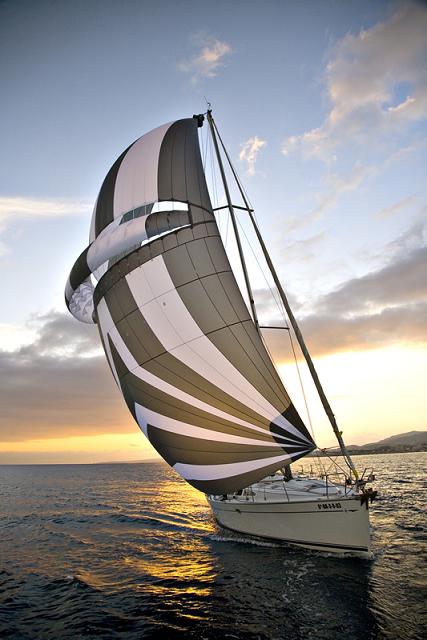
Finally, there’s another type of upwind/downwind sail called the code zero. Code zeros are designed to be used in light winds when sailing upwind, but they can also be used for reaching and running downwind. These sails have a flat shape that allows them to generate lift even in very light wind conditions.
Heavy Weather Sails
Heavy weather sailing is a challenging and potentially dangerous activity. The use of heavy weather sails, such as trysails, is crucial to ensure the safety of sailors and their vessels.
A trysail is a small triangular sail made of heavy-duty material, typically spinnaker cloth or other lightweight fabric. It is designed to be used in stormy weather conditions when winds are high and the seas are rough.
The role of a trysail is to provide an alternative source of propulsion when the main sail or jib cannot be used. In addition, it helps reduce the heeling effect on the vessel caused by strong winds. Trysails are rigged using a separate halyard and can be set up quickly when needed.
A trysail should be used in severe weather conditions when winds exceed 40 knots or more. It is recommended that sailors practice setting up their trysail before they need it so that they can do it quickly and efficiently in an emergency situation.

Another type of heavy weather sail that every sailor should have on board is a storm jib. This sail is typically much smaller than a regular jib and made from heavier materials such as Dacron or nylon. Its purpose is to provide additional stability during high wind speeds and rough seas.
The features of a storm jib include its size, shape, and weight distribution. It has a large luff (the leading edge) which allows it to be hoisted higher up on the rigging than other sails. This helps keep the boat stable during high-speed sailing in strong winds.
A storm jib should be used in extreme weather conditions where wind speeds exceed 50 knots or more. When using this sail, it is important to ensure that the halyard is properly tensioned and that the sail is sheeted in tightly. This will help prevent any unnecessary movement or fluttering of the sail.
Overview Common Sail Types
100% of mainsail
Light – High
100% of foretriangle
Moderate – High
triangular, overlapping
110% – 150% of foretriangle
Light – Moderate
60% – 80% of foretriangle
Close Reach – Broad Reach
Lightwind, Downwind
balloon shape, free flying
200% of mainsail (or even more)
Broad Reach, Running
parachute shape
100% of spinnaker
80% – 85% of spinnaker
Lightwind, Upwind
75% of spinnaker
30% – 60% of mainsail
Mainsail, heavy weather
17.5% of mainsail (or less)
Headsail, heavy weather
max. 65% of the hight of the foretriangle
Unconventional Sails
Wing sails are a type of sail design that is not commonly used in traditional sailboat designs. They are essentially vertical airfoils that generate lift and propulsion by directing the wind over the surface of the sail. Wing sails have become increasingly popular in modern sailing craft, particularly in high-performance racing boats.
One of the main advantages of wing sails is their ability to produce a significant amount of power with very little heeling force. This means that they can be used effectively in high-wind conditions without causing the boat to tip over. Additionally, wing sails are highly efficient at sailing upwind, which allows sailors to point higher into the wind than with other types of sails.
While wing sails may seem like a relatively new concept, they have actually been around for quite some time. The first recorded use of a wing sail was by German engineer Wolfgang Zimmermann in 1959. Since then, many different variations on the design have been developed and tested.

Kite sails are another unconventional type of sail that has gained popularity in recent years. Unlike traditional downwind sails such as spinnaker or parasailors, kite sails are flown from a line attached to the bow of the boat and do not require a mast or boom.
Sail Materials and Technology
Traditional sail materials.
Sails have been used for thousands of years to harness the power of the wind and propel boats across water. Traditional sail materials were flax, hemp, or cotton. These natural fibers were woven together to create a strong, yet flexible material that could withstand the harsh conditions at sea. However, as technology advanced and sailors began to demand more from their sails, new materials were developed.
Modern Sail Materials
Modern sailboats use synthetic materials such as polyester, nylon, or laminated fabrics for their sails. These materials are lightweight and incredibly strong, allowing sailors to achieve greater speeds with less effort. They are also more durable than traditional sail materials and can withstand prolonged exposure to sunlight and saltwater.
Popular Sail and Mast Configurations

The sloop rig is one of the most popular sail plans for modern sailboats. It features a single mast and one headsail, like a jib or genoa. The mainsail is typically triangular in shape and hoisted up the main mast using a backstay to support it. The jib or genoa is attached to the forestay that runs from the top of the mast to the bow of the boat.
Another popular sail plan is the cutter rig, which also features a single mast but has two headsails – an overlapping jib and a smaller staysail. The mainsail is still triangular in shape and hoisted up the main mast with a backstay for support.
Moving onto two-masted rigs, we have ketch rig, which features a main mast and a shorter mizzen mast located in front of the rudder. The mainsail is still triangular in shape and hoisted up the main mast with a backstay for support, while the mizzen sail is generally smaller and triangular or quadrilateral in shape.
Lastly, we have the yawl rig which is similar to the ketch rig but has its shorter mizzenmast located aft of the rudder. The mainsail is still triangular in shape and hoisted up the main mast with a backstay for support, while the mizzen sail is generally smaller and triangular or quadrilateral in shape.
Conclusion: Understanding the Different Types of Sails
Understanding the Different Types of Sails is crucial for any sailor who wants to optimize their performance and safety on the water. Whether you’re racing, cruising or simply enjoying a day out on your sailboat, having the right sails for the conditions can make all the difference.
Ultimately, understanding the different types of sails is essential for any sailor looking to improve their skills on the water. By selecting the right sail for your boat and conditions, you can optimize your performance while staying safe and comfortable during your time at sea.
So whether you’re a seasoned sailor or just starting out, take some time to explore the various types of sails available and find the ones that work best for you. With a little knowledge and experience under your belt, you’ll be well on your way to mastering this exciting sport!
Similar Posts
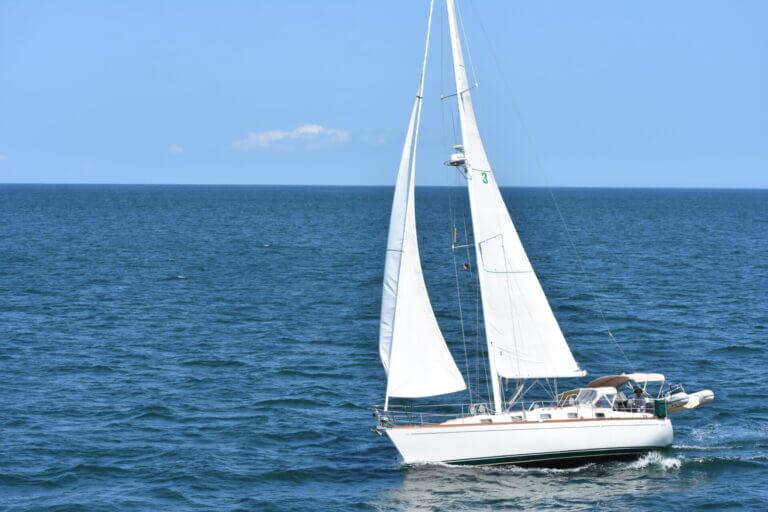
What is a Sloop? Definition, Types and History
A sloop is a type of sailboat that has a single mast and a fore-and-aft rig. Sloops are a type of sailboat that has been around for centuries. They are known for their versatility and ease of handling, making them popular among sailors of all skill levels. Sloops have a single mast and a fore-and-aft…

Basic Sailing Terminology: Sailboat Parts Explained
Sailing is a timeless activity that has captivated the hearts of adventurous souls for centuries. But, let’s face it, for beginners, sailing can be as intimidating as trying to navigate through a dark, labyrinthine maze with a blindfold on. The vast array of sailing terminology, sailboat parts and jargon can seem like a foreign language…

What is a Keel?: The Backbone of a Ship
As ships sail through tumultuous seas, their stability and maneuverability are tested to the fullest extent. The intricate design and engineering that go into a ship’s construction ensure that it can withstand the forces of nature and navigate through any challenging conditions. One of the most critical components of a ship’s design is the keel,…

How Does a Marine Toilet Work?
Have you ever wondered how a marine toilet works? If you’re planning to embark on a boating adventure or just curious about the mechanism of a marine toilet, this article is for you. Marine toilets work similarly to the ones on land with a bowl, a seat, and a flushing mechanism that uses water. However,…
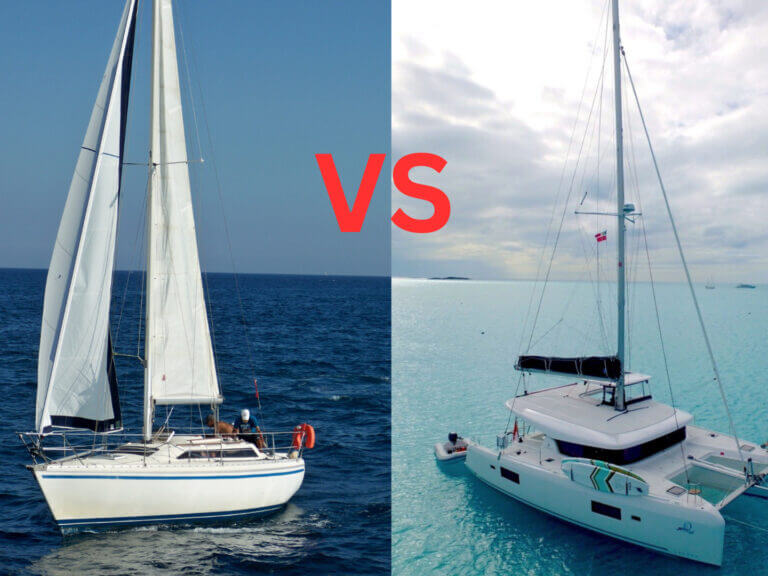
Monohulls vs. Catamarans: Which One is Best for You?
If you’re considering purchasing a sailboat, you might be wondering which type of vessel is best suited for your seafaring adventures. Fear not, for we’re here to help you weigh the differences between monohulls vs. catamarans to make an informed decision. Now, before we dive into the nitty-gritty details of hull design, sail handling, and…

Mainsail Furling Systems – Which one is right for you?
With the variety of options of mainsail furling systems available, including slab, in-boom, and in-mast systems, it can be challenging to determine which one best suits your needs. In this comprehensive guide, we will explore the pros and cons of each system, enabling you to make an informed decision that aligns with your sailing requirements….

Boat Sailor
Type of sails: a comprehensive guide to sails.
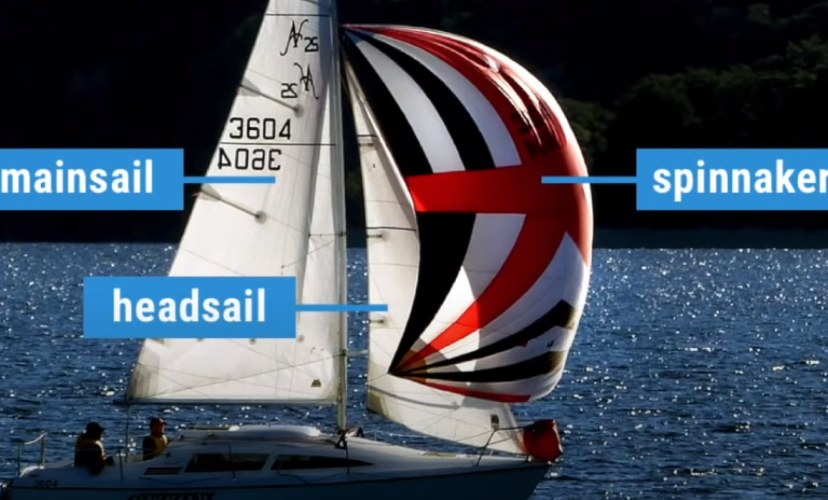
As an avid sailing enthusiast and advisor, I am excited to share a complete guide to different types of sails for sailboats. Choosing the right sail is crucial for optimizing sailing performance and ensuring safety in various weather conditions. In this article, we will explore the main type of sails, their advantages, and when to use them effectively. So let’s set sail and delve into the world of sails!
The Main Types of Sails
Mainsail: The Backbone of Sailing
The mainsail, being the largest and most essential sail on a sailboat, plays a central role in driving the vessel forward. It is a fore-and-aft rigged sail attached to the mast and the boom. Mainsails are incredibly versatile and suitable for various wind conditions, making them the go-to sail for most situations. They are easy to steer, even in light winds, making them ideal for relaxed cruising.
Headsail/Jib: Your Go-To Sail for Safety
The headsail, also known as a jib , is a smaller sail located forward of the mast. Its primary purpose is to maintain stability and balance the boat in strong winds. When the wind picks up, the mainsail can become overpowering, and that’s when the headsail steps in to ensure safe and controlled sailing. It’s like having a safety net during rough weather conditions.
Genoa: Power and Versatility Combined
The genoa is a type of headsail that offers more sail area and power compared to a standard jib. It’s perfect for boosting speed and maneuverability, especially in light winds. Genoas are incredibly versatile, making them an excellent choice for sailors who want to get the most out of their sailboat in various conditions.
Sailing Ship Rigs: A Historical Perspective
In the era of the “golden age of sail,” different sail plans were used on sailing vessels to optimize their performance and accommodate smaller crews.
Fore and Aft Rig
The fore-and-aft rig, consisting of sails aligned along the length of the boat, includes popular designs like schooners and sloops. These rigs required smaller crews and were well-suited for coastal and fishing trades.
Square topsail schooners with athwart sails were also prevalent during that time. They were used for cargo ships and long voyages, but their complex rigging required larger crews to handle the sails effectively.
The Golden Age of Sail
This period marked the peak of sailing ship technology and saw remarkable advancements in shipbuilding and sail design. It’s a fascinating chapter in the history of sailing that continues to inspire sailors to this day.
Type of Sails Names: Decoding the Terminology
Mainsail and Foresail
The mainsail, as mentioned earlier, is the principal sail that catches the wind to move the boat forward. Foresail is a general term that includes various sails positioned near the bow of the sailboat, such as the jib and genoa.
Genoa and Jib
The genoa and jib are both types of foresails. The genoa is larger and overlaps the mainsail, providing additional power and efficiency. The jib, on the other hand, is smaller and is used when the wind is stronger.
Staysail and Spinnaker
Staysails are triangular sails set between masts and stays, used to improve stability and balance. Spinnakers are large, balloon-shaped sails used for downwind sailing, providing an extra boost of speed.
Choosing the Right Sail for Different Conditions
Sailing in Light Winds
In light winds, the mainsail is your best friend. It’s highly efficient and capable of catching even the slightest breeze, propelling the boat forward smoothly.
Sailing in Strong Winds
When the wind picks up, it’s time to rely on the headsail or jib. These sails provide a reduced surface area, preventing the boat from becoming overpowered and ensuring a controlled sail.
Navigating Challenging Weather
Different weather conditions call for different sails. Understanding the intricacies of each sail and when to use them will help you navigate through challenging weather with ease.
Type of Sails Materials: Quality Matters
Traditional Canvas Sails
Traditional canvas sails, made of materials like cotton or linen, were commonly used in the past. While they offer a classic charm, their performance and durability have limitations compared to modern sail materials.
Modern Sail Materials
Today, sail manufacturers utilize advanced materials like Dacron, Mylar, and Kevlar. These materials offer superior strength, low stretch, and better shape retention, contributing to improved sailing performance.
Pros and Cons of Each Material
Understanding the pros and cons of different sail materials will help you make an informed decision when purchasing or maintaining your sails.
Understanding Sail Shapes and Configurations
The Science of Sail Shape
Sail shape is crucial for maximizing performance and efficiency. Properly trimmed sails allow you to sail efficiently, whether you’re sailing upwind or downwind.
Balancing Performance and Stability
Finding the right balance between performance and stability is essential. Adjusting sail shape and trim can significantly impact your sailing experience.
Fine-Tuning Sail Trim
Sail trim is an art form. Mastering the art of fine-tuning sail trim will make you a more skilled sailor and enhance your overall sailing experience.
The Evolution of Sail Designs
From Classic to Cutting-Edge
Sail design has come a long way. From classic traditional sails to modern, innovative designs, sailmaking has witnessed significant evolution.
How Technology Impacted Sail Design
Technological advancements have revolutionized sailmaking, resulting in more efficient, aerodynamic, and performance-oriented sails.
Innovation in Sailmaking
Sailmakers are continually exploring new materials and construction techniques to create sails that are lighter, stronger, and more efficient than ever before.
Sailing Techniques: Getting the Most Out of Your Sails
Tacking and Gybing
Tacking and gybing are essential sailing maneuvers used to change the direction of the boat and optimize the use of wind.
Maximizing Speed
To get the most out of your sails, understanding how to trim them properly and sail at optimal angles is crucial for achieving higher speeds.
Safety Precautions
Sailing is exhilarating, but safety should always be a top priority. Understanding safety procedures and precautions will ensure a safe and enjoyable sailing experience.
Maintaining and Storing Sails
Sail Care and Maintenance
Proper care and maintenance are essential to prolong the life of your sails and keep them in top condition.
Storing Sails Properly
When not in use, storing sails correctly can prevent damage and maintain their performance over time.
Extending the Lifespan of Sails
With proper care and attention, you can extend the lifespan of your sails, making them a worthy investment.
Sustainable Sailing: Eco-Friendly Sail Materials
The Impact of Traditional Sails on the Environment
Traditional sail materials, while charming, may have a more significant environmental impact compared to modern, eco-friendly alternatives.
Eco-Friendly Sail Options
Eco-conscious sailors can explore sustainable sail materials that minimize environmental harm without compromising performance.
Embracing Sustainable Practices
As sailors, we have a responsibility to protect the oceans and environment. Embracing sustainable practices in sailing is essential for the well-being of our planet.
As we conclude this comprehensive guide to different type of sails, I hope you now have a deeper understanding of the critical role sails play in sailing. Choosing the right sail and mastering sail techniques will elevate your sailing experience to new heights. Remember, sailing is an ever-evolving journey of learning and adventure.
Which sail is best for light winds?
The mainsail is the most suitable sail for light winds as it can efficiently catch even the slightest breeze and keep the boat moving smoothly.
What is the purpose of a genoa?
The genoa is a type of sails that provides additional power and versatility, making it an excellent choice for boosting speed and maneuverability in various wind conditions.
What sail material is most durable?
Modern sail materials like Dacron and Kevlar offer superior strength and durability compared to traditional canvas sails made of cotton or linen.
How do I maintain my sails?
Proper care and maintenance, including regular cleaning and inspection, will help prolong the life of your sails and ensure they perform optimally.
Are there eco-friendly sail options?
Yes, eco-conscious sailors can opt for sustainable sail materials that minimize environmental impact, contributing to a greener and more sustainable sailing experience.

Michael Thompson
Embarking on a lifelong love affair with the sea, I found solace and exhilaration in the art of sailing. From navigating treacherous waters to harnessing the wind's untamed power, my passion has evolved into a mission to inspire others. Join me on a voyage of discovery as we explore the vast horizons of sailing's timeless allure.
More to Explore

Spiridakos Sailing Cruises: An Unforgettable Adventure
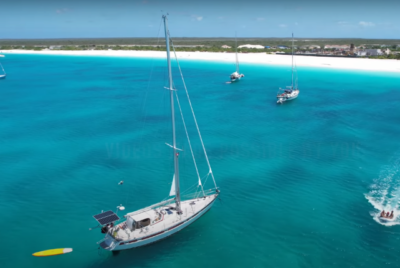
Sailing in the Caribbean
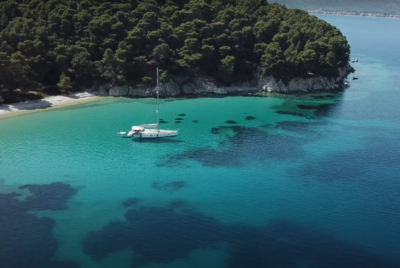
Sailing Greek Islands
Sail Types: A Comprehensive Guide to 8 Types of Sails
Sails are the driving force behind sailboats, harnessing wind power to propel a vessel across the water. For both novice and seasoned sailors, understanding the different types of sails is essential. Various sails serve specific purposes, depending on wind conditions, boat type, and sailing goals. In this comprehensive guide, we’ll explore eight key sail types, their functions, and the specs and costs associated with each.
1. Mainsail
The mainsail is the primary sail on most sailboats, mounted to the back of the mast and along the boom. It provides most of the boat’s power, especially when sailing upwind.
Function: The mainsail is crucial for both upwind and downwind sailing. Its size and shape allow for efficient wind capture, giving the boat forward momentum.
Material: Most modern mainsails are made of Dacron (polyester), but high-performance options might use laminate or Kevlar for added strength and durability.
Size: Varies based on boat size. A 30-foot sailboat may have a mainsail of around 250-300 square feet.
Price: A Dacron mainsail for a 30-foot boat typically costs $2,500 – $3,500. Performance materials can cost upwards of $5,000.
The jib is a smaller sail that is positioned in front of the mainsail, attached to the forestay (a wire or rod that runs from the bow to the mast).
Function: The jib complements the mainsail, improving maneuverability and speed, especially when sailing upwind.
Types of Jib:
- Working Jib – Smaller and used in strong winds.
- Genoa – A larger jib that overlaps the mainsail, providing more power in lighter winds.
Material: Like the mainsail, Dacron is the most common fabric, but high-performance boats may use laminate or Kevlar.
Size: A working jib on a 30-foot boat is around 200 square feet, while a genoa can be 400 square feet.
Price: Working jibs range from $1,000 to $2,500. Genoas are typically more expensive, costing between $2,500 – $4,500.
3. Spinnaker
Spinnakers are large, balloon-like sails designed for sailing downwind. They are often colorful and made from lightweight nylon.
Function: The spinnaker is used when sailing with the wind behind the boat. Its large surface area allows it to catch as much wind as possible for maximum speed.
Types of Spinnaker:
- Symmetric Spinnaker – Ideal for broad reaches and runs, requiring a spinnaker pole for stability.
- Asymmetric Spinnaker – More versatile, allowing for easier handling without a pole. Best for reaching across the wind.
Material: Spinnakers are typically made of nylon due to its light weight and flexibility.
Size: On a 30-foot boat, a spinnaker may range from 500 to 1,000 square feet, depending on the type.
Price: Symmetric spinnakers generally cost between $2,000 and $4,000, while asymmetric ones range from $3,000 to $6,000.
4. Gennaker
A gennaker combines elements of both the genoa and spinnaker, offering versatility for downwind and reaching conditions.
Function: It is primarily used for reaching (when the wind is coming from the side of the boat) and light downwind sailing, offering a balance between speed and ease of handling.
Material: Made from lightweight materials like nylon, similar to a spinnaker.
Size: On a 30-foot boat, a gennaker is usually around 600-800 square feet.
Price: A gennaker typically costs between $2,500 and $5,000, depending on size and material.
5. Storm Jib
The storm jib is a small, heavy-duty sail designed for use in severe weather conditions.
Function: When the wind becomes too strong for a normal jib, the storm jib provides the control needed to keep the boat safe. Its smaller size reduces the sail area exposed to high winds, preventing the boat from being overpowered.
Material: Storm jibs are made from strong, durable materials like heavy Dacron or reinforced laminate.
Size: A storm jib on a 30-foot boat might be around 75-100 square feet.
Price: Storm jibs cost between $1,000 and $2,000, depending on size and material.
6. Code Zero
The Code Zero is a light-wind sail that falls between a genoa and spinnaker in terms of function. It’s typically used in light upwind or close-reaching conditions.
Function: The Code Zero offers maximum sail area for light wind conditions, allowing the boat to maintain speed when the wind is light but not fully downwind.
Material: It is made from laminate or light Dacron, offering a balance between weight and durability.
Size: On a 30-foot boat, a Code Zero may range from 400 to 700 square feet.
Price: A Code Zero sail typically costs between $3,000 and $6,000.
A drifter is a light-wind sail that is used when the wind is too light for the jib or genoa. It’s similar to a spinnaker but is easier to handle.
Function: The drifter helps the boat maintain speed in very light winds, especially when sailing upwind or on a close reach.
Material: Like spinnakers, drifters are made from lightweight nylon .
Size: A drifter on a 30-foot boat may range from 400 to 600 square feet.
Price: Drifters generally cost between $2,500 and $4,000.
8. Wing-on-Wing (Downwind) Sail Setup
While not a separate sail type, this technique is used for sailing downwind by positioning the mainsail and jib on opposite sides of the boat, maximizing the sail area exposed to the wind.
Function: When sailing directly downwind, the wing-on-wing setup optimizes wind capture from both the mainsail and jib, improving speed.
Material: The same materials used for the mainsail and jib apply.
Size: Depends on the size of the mainsail and jib being used.
Price: No additional cost beyond the mainsail and jib, but some sailors invest in a whisker pole ($500 to $1,500) to hold the jib in place.
Understanding the different types of sails and their functions is crucial for maximizing your sailing experience. Whether you’re outfitting a new boat or upgrading your existing sails, choosing the right sails for your sailing style and conditions is key. From the versatile mainsail to specialized sails like the spinnaker or storm jib, each sail type serves a purpose in helping you harness the wind’s power. Keep in mind the price ranges and specifications when selecting sails for your boat to ensure you get the right sail for your needs, budget, and sailing environment.
Happy Boating!
Share Sail Types: A Comprehensive Guide to 8 Types of Sails with your friends and leave a comment below with your thoughts.
Read Fall Boating: 6 Reasons to Keep Boating into Autumn until we meet in the next article.
Similar Posts

Pontoon Windscreen: A Comprehensive Guide
Pontoon boats have become increasingly popular for recreational activities, thanks to their stability, spaciousness, and versatility. One essential accessory that enhances the boating experience is the pontoon windscreen. This guide will delve into everything you need to know about pontoon windscreens, from their benefits to pricing and specifications. What is a Pontoon Windscreen? A pontoon…

Triple Pontoon Boats for Sale: Buying Guide
Triple pontoon boats, also known as tritoons, have taken the boating world by storm. Offering a unique combination of luxury, performance, and stability, they’ve become a popular choice for families, recreational boaters, and even fishing enthusiasts. If you’re considering joining the tritoon revolution, this guide will equip you with the knowledge to navigate the world…

Northstar Pontoons: Setting Sail on Value Guide
In the world of pontoon boats, where luxury and price tags often go hand-in-hand, Northstar Pontoons stands out as a champion of affordability. But is a Northstar pontoon all about budget, or is there more to the story? Let’s dive in and explore what Northstar offers pontoon enthusiasts. Northstar’s Value Proposition Northstar’s core philosophy revolves…

Buying Used Lund Boats: Prices, Specs and Key Considerations
Lund Boats, renowned for their high-quality craftsmanship, durability, and versatility, have long been a favorite among fishing enthusiasts and recreational boaters. Whether you’re an angler looking for a reliable fishing vessel or a family in search of a multipurpose boat, a used Lund boat can be an excellent choice. In this guide, we’ll dive deep…

Are Avalon Pontoon Boat Good & Reliable Enough to Own?
Avalon pontoon boats shimmer on the horizon, their sleek lines and plush interiors promising sun-kissed days and carefree cruising. But before diving headfirst into ownership, let’s navigate the calm and choppy waters of reputation and reality, answering the crucial question: are Avalon pontoon boats good and reliable enough to own? Sunlit Shores of Avalon: Hidden…

Solar-Powered Battery Chargers for Boats: Guide
As boating enthusiasts increasingly seek eco-friendly and efficient power solutions, solar-powered battery chargers have become a popular choice. These chargers harness the sun’s energy to keep your boat’s batteries charged, providing a reliable and sustainable power source. In this comprehensive guide, we’ll explore the key aspects of solar-powered battery chargers for boats, including their benefits,…

The Different Types Of Sails And When To Use Them – Complete Guide

Sail forms an integral part of a sailboat. When you sail on the open water and observe other boats (in various sizes), you’d have noticed how each boat type has a specific model of sail. If you’re a beginner in boating, you must know that there are a ton of different sails and they each have their own purpose.
As a general setup, sailboats will use three common sails, including headsail, mainsail, and specialty sail. Due to the varying wind conditions and the model of the sailboat, there are many types of sails including jib, genoa, trysail, storm jib, code zero, gennaker, and spinnaker.
While that sounds like too many models of sails, you can easily differentiate between them and choose the ideal model based on your purpose. This article guides you on this aspect. Let’s begin!

Different Types of Sails & When To Use Them
1. mainsail.
Mainsail is by far the most widely spotted sail model, and it’s usually fixed to the boom and fitted behind the mast. This offers the highest mileage to your sailboat, thereby maximizing speed and performance.
You can use a mainsail if:
- You’re concerned about the performance
- You need to go faster and utilize all wind power
- You need to steer your boat irrespective of the wind’s status
- You’ve a large boat and can offer adequate space to this sail.
This mainsail displays a wide surface area to make the most out of the available wind condition. As a result, you can steer your boat quite easily. However, the downside is its size. It is very large and hard to store if you need to take it down for some reason.
Check out my other article all about maintaing sails!
2. Headsail
Similar to a mainsail, it’s very easy to spot a head sail. Just look at the bow of the boat and see if there is a sail. If you see one then yes that’s a headsail. Also called a jib or genoa, a headsail is smaller in size compared to a mainsail and attaches in front of the mast to the forestay. The Foresail will not have a boom for the clew of the sail to attach to. The clew will be attached to the foresails sheet. It can be used without the mainsail in certain conditions but for the most part the two sails are used together. The foresail is always forward of the main.
The headsail comes in many different forms such as a jib, genoa, spinnaker or storm jib. The most common headsail is a jib or genoa.
You can use a headsail if:
- Your sailboat is set up for it.
- You don’t want to use the mainsail at this time.
- Your mainsail is not usable.
The biggest advantage of a headsail is the option to protect yourself even if the wind turns unpredictable or wild. This all depends on the type of headsail you are using.
So, what are the different types of headsails? Let’s take a look!
As more boaters chose to use a headsail for their boats, the jib was introduced as one of its forms. The Jib is a form of headsail that is attached to a shackle present on the deck’s front region.
The Jib is a sail that does not go past the mast when it is raised and in use. If it goes past the mast then you probably have a genoa.
You can use a jib if:
- You are out for a normal day of sailing in moderate wind speeds
- You have a roller furling. Which is a sail that wraps up around itself.
Some weather conditions can make maneuvering harder or tighter than usual. As a result, it’s essential to use a jib in such cases. It functions well with boats containing a roller furling as the jib handles different positions and tackles the movement of the boat at ease.
2.2 Genoa
Just when you’ve got acquainted with the jib, genoa comes into the picture as a larger version of the jib. If you’re boating along a coastal region, the genoa sail is the one widely used and is attached to the front area of the deck as well.
Here’s a quick trick to find out if a boat has a genoa sail. This genoa is usually larger than a Jib. This means that the genoa effortlessly overlaps and extends itself beyond the mast, thereby covering the mainsail as well.
You should use a genoa sail if:
- You’re planning to sail in minimum wind conditions. Less wind means you need more sail.
- You find the wind to originate from the rear area.
- You own a large boat. Remember that genoa can partially or completely cover the mainsail too. Larger sails for larger boats!
While it’s great for sailing in regular conditions, there are downsides associated with it. A genoa can put you in a dangerous situation if you are sailing in high wind conditions and don’t have the ability to furl in the sail. Furling in the sail will reduce the area of the sail and catch less wind.
Genoas do come in many sizes as well such as 110% or 120%.
The next section of the sail list are ones that aren’t necessary but can be helpful in certain situations. Let’s look at specialty sails!
3. Specialty Sail
While headsails and mainsails are quite commonly used, there are also specialty sails in the market to address specific requirements. Some of the widely seen specialty sails are spinnakers, storm jibs, and code zeros.
3.1 Spinnakers
Spinnaker is a sail dedicated to downwind and is quite large. Think of a beautifully covered parachute.
It’s easy to spot spinnakers as they resemble kites or parachutes. However, it crosses the bow of the boat and isn’t attached to the forestay.
Unlike the genoa sail that covers the mast, a spinnaker fails to do so. The advantage of a spinnaker is the surface area. When the wind is light, the spinnaker can catch a lot more wind giving you more speed. The Spinnaker is usually fixed to three points – pole, halyard, and sheet.
You should use a spinnaker if:
- You have minimal wind on a run.
- You are trying to harness as much wind power as you can.
While it has a wide surface area, the downside is its inability to steer the boat during strong wind conditions. It can even put the passengers at risk when the wind is at high speeds.
Make sure you have experience before trying out the spinnaker.
3.2 Storm Jibs
Storm jib is another type of specialty sail meant exclusively for rough weather. It’s a tiny, triangular structure that helps during offshore racing or cruising. Just think of it as a smaller jib.
You should use a storm jib if:
- You’re going to sail in heavy weather conditions.
- You anticipate high wind speeds.
- You’re going to be in an offshore race and they are an approved sail type.
Note: In the case of an offshore racing requirement, it’s critical to take prior permission from the regulatory authority for using a storm jib.
3.3 Code Zeros
Code zero is another updated version of a spinnaker that’s meant to be a combination of genoa and gennaker sails. It resembles the look of a genoa but is a lot bigger.
You should use a code zero if:
- You’re looking for an overlapping flying headsail.
- You’re sailing only in light air conditions.
- You’re looking for an alternative to a Genoa.
Having said that, a code zero or a screecher does the job of a genoa with better efficiencies.
3.4 Trysail
Trysail is another type of specialty sail that’s tiny, triangular, and can be fixed right above a gooseneck on the sailboat.
The Trysail is less known in the market as most boaters go ahead with common mainsails and headsails. It’s essential to acknowledge trysail as a front-and-aft mainsail model. It offers excellent performance and contains a permanent pennant in it.
You should use a trysail if:
- You’re sailing in heavy weather conditions.
- You’re looking for a storm replacement.
- You are experienced with using them.
The quadrilateral sail in a trysail is usually turned and bent to a mast, and this helps in heading the vessel during windy conditions.
3.5 Gennakers
If you’ve been able to spot genoa and spinnaker in the past, identifying a gennaker is incredibly easy. A gennaker is a hybrid sail form that is small, slow, and requires no pole attached to the mast.
You should use a gennaker if:
- You’re looking for a smaller version of a spinnaker.
- You’ve no space to fix a pole to the mast.
- You require the sail to be easily manageable.
- You’re sailing in a region requiring minimum downwind levels.
Choosing a hybrid sail has a lot of benefits as it combines the usefulness of 2 sail models. However, being aware of their cons is critical to planning a safe sail.
As you begin using these sails, you can also look for better customizations. There are drifters, wind seekers, and other jib types that are meant to handle different wind conditions.
How Many Sails On A Sailboat ?
In general, a sailboat contains two sails. Two sails is the typical setup for the best performance of the boat during different wind conditions. It’s essential to pick your two sails based on your sailing plan.
Why Are There Two Sails On A Sailboat?
A sailboat uses two sails because the wind left over by the first sail is easily caught by the second sail. This helps in steering the sailboat to a better extent and gives the sailboat more power.
Final Thoughts
Sails are one of the major assets of a sailboat. From managing wind to maximizing the performance and longevity of a sailboat, the type of sails you use, plays a huge role. From the various sail types listed in this article, you can choose the best model that fits your sailing routine. Just make sure to remember to check and make sure they are the correct size for your vessel.
Make sure to plan ahead and have the right sails for your sailing weekend. Cheers!
Boatlifehq owner and author/editor of this article.
Recent Posts
How to Repair a Sailboat Hull: Step-by-Step Guide
Maintaining your sailboat's hull is crucial for ensuring its longevity and performance on the water. Hull damage can occur due to various reasons, such as collisions, grounding, or general wear and...
10 Steps For Anchoring Your Sailboat
Anchoring a sailboat is a fundamental skill every sailor must master. Proper anchoring ensures your boat remains secure, preventing it from drifting and potentially causing damage. Whether you're...

Most Popular Types of Sails on a Sailboat
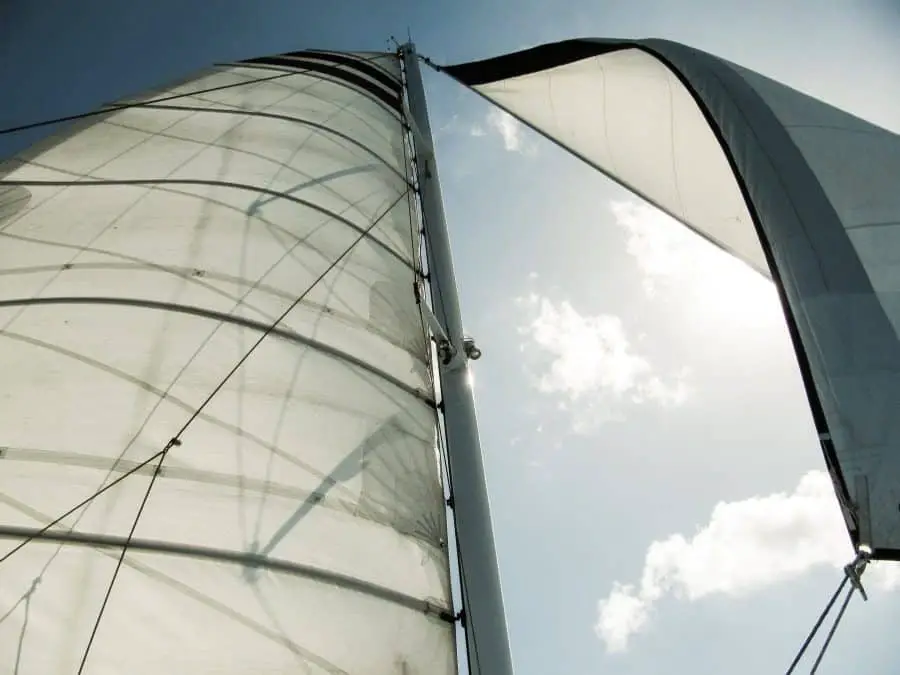
Learning about how there were different types of sails on sailboats for me was a bit strange at first. I thought something along the lines of “Don’t you just need to put some fabric on some polls and grab the wind?” Obviously, there’s far more to it than that.
So what are the most popular types of sails on sailboats? The mainsail, headsail (or jib), genoa, spinnaker, and gennaker are the most popular types of sails on sailboats. There are also a number of different configurations when considering the type of sail and mast in use including a sloop, fractional rig sloop, cutter, ketch, schooner, yawl, and cat.
Simply put, different sailboat sails serve different purposes when out on the water.
The sail is kind of like the “engine” of your sailboat (of course, sailboats can have actual engines) in that it’s the main source of forward propulsion.
So, it’s important to know when best to use either type of sail and why including the many different names of sails on a ship.
Types of Sails
There are a number of reasons why you’d want to use one sail over another, but the most important points to consider have to do with the point of sail you’re sailing in and the wind strength.
Maybe you need downwind sails, square sails, or a triangular sail. Maybe a unique sail shape, sail cloth, or sail area. With that in mind, let’s check out the different sail types!
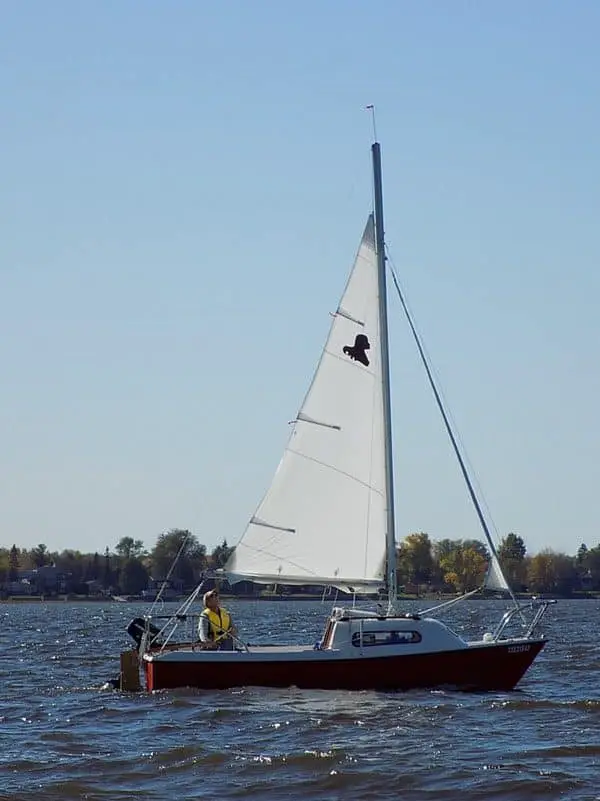
The mainsail is by far the most popular type of sail on sailboats and is often the first image that comes to mind when thinking about a sailboat.
Mainsails are found behind the mast and attached to the boom, which makes it a common part of the sailboat to keep an eye on as it takes up a lot of real estate on a boat with sails especially during a sail tack.
Mainsails are able to cover a lot of surface area with respect to incoming winds, especially since they’re attached to the boom.
The fact that they have a large surface area means they don’t require very strong winds to provide good forward propulsion on a sailboat.
Also, since the position of the mainsail can be easily configured thanks to the boom, all points of sail are achievable.
Headsail/Jib

The headsail (or jib) is probably the second most popular type of sail on sailboats since it usually accompanies the mainsail.
The headsail is always placed at the front of the mast and can cover a good amount of the bow of the sailboat. It’s also smaller than a mainsail, making it more portable and easy to work with.
Headsails aren’t as big as mainsails, therefore they have a smaller surface area which results in the fact that they’re not capable of catching as much wind as a mainsail.
This is an important point though since if the current wind is exceptionally strong and your mainsail has been trimmed as much as possible, being able to put away your mainsail and depend on your headsail alone is an excellent strategy to reduce speed.
When the wind is just too strong to keep your mainsail out, putting it away and using only your headsail is a great option.
You won’t be grabbing as much wind as with the mainsail and you’ll be able to have a much more enjoyable (and safer!) sailing experience.
One of the most picturesque sailing images one can conjure up is the one with a sailboat using a genoa sail (see the image above on the right).
A genoa is a type of large jib that’s attached to the front of the forestay just like a headsail.
One of the main differences with the genoa sail is that it’s bigger than the normal headsail and oftentimes extends behind the mast partially or completely covering the mainsail. It actually used to be called an “overlapping jib”.
Using a genoa sail means you have light to medium winds and your sailboat is more or less in a dead run point of sail (wind coming directly from the rear or sailing downwind).
Since the surface area of a genoa sail is so large, it’s important only to use it when winds are relatively low. Otherwise, you’ll be moving exceptionally fast resulting in a potentially risky situation.
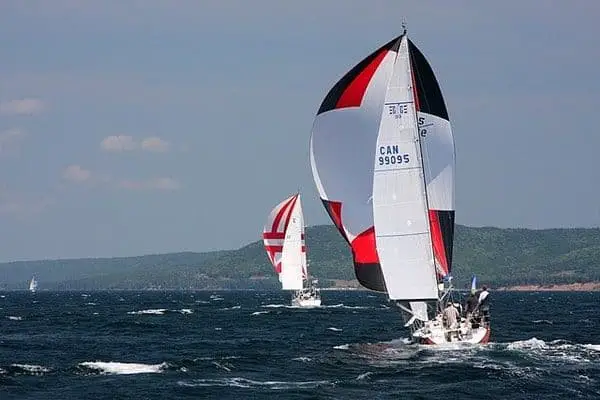
A spinnaker sail is a fun sail to use since it’s quite large, colorful, and can pick up a lot of wind.
Unlike a genoa sail, they’re often symmetrical making them more sensitive to the reaching points of sail and thus more appropriate for the running point of sail. They’re also lighter and have a “kite” kind of feel to them.
The reason they resemble a “kite” is not only that they’re generally lighter and more colorful than other types of jibs, but also they don’t cover the mast like a genoa sail.
Instead, they don’t attach to the forestay and stretch out toward and past the bow of a sailboat. Since they’re bigger than genoa sails, you want to be even more careful to only use them in relatively low and non-volatile wind environments.
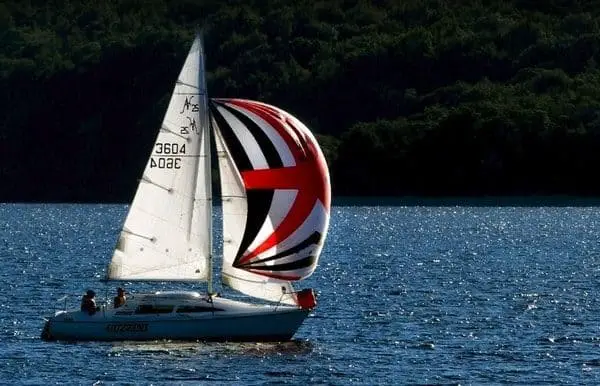
A gennaker sail is a more recent type of sail on sailboats since they were developed around 1990.
Gennakers are a cross between genoa and spinnaker sails (as the name might suggest), which are big like a spinnaker, aren’t as symmetric as a spinnaker, and aren’t attached to the forestay like a genoa sail or headsail.
The reason for the invention of the gennaker is that sailors wanted to take advantage of lighter winds without having to resort to using a spinnaker if the winds change from a pure dead run to more of a reaching point of sail.
All in all, the gennaker sail is able to bridge the performance gap between a genoa and spinnaker sail in terms of being able to take on a more flexible point of sail while taking advantage of relatively softer winds.
Popular Sail and Mast Configurations
Now that you’re familiar with the most popular types of sails on a sailboat, it’s good to get an idea of how these sail types relate to the configuration of a sailboat’s mast.
There are a huge number of combinations when it comes to sails and mast configurations, so I thought I’d lay out the most popular ones you’ll likely run into out on the water.
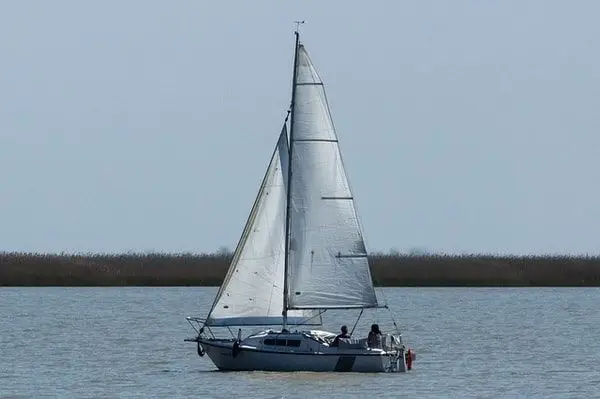
A sloop is the most common type of sail and mast configuration for sailboats. The sloop is the classic single mast, double sail setup.
The sails on a sloop consist of a mainsail and a headsail. The headsail can be different types of jibs, including the genoa, spinnaker, or gennaker sails. The headsail is connected to the forestay on the mast and runs all the way to the top of the mast.
Fractional Rig Sloop
Similar to a sloop, a fractional rig sloop has a single mast, double sail setup. The only difference, however, is that the forestay doesn’t reach the top of the mast, resulting in the headsail being restricted to a fractional amount of space a normal sloop would allow for.
This reduction of surface area for the headsail means that less wind can be captured and, thus, reduced sailboat speed.
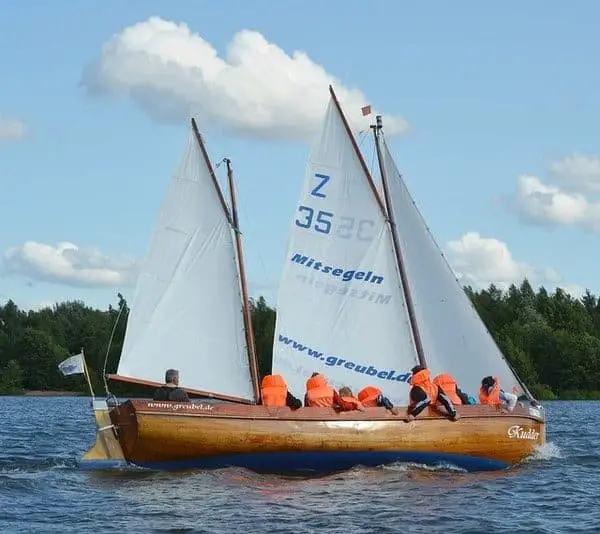
A cutter is an interesting setup since it’s just like the sloop and fractional rig sloop setup, but instead of one forestay it has two. With two forestays on the mast, cutters are able to house two headsails.
This can be a preferred setup because it allows for easy cruising due to it offering a diverse combination of points of sail for different strengths of wind.
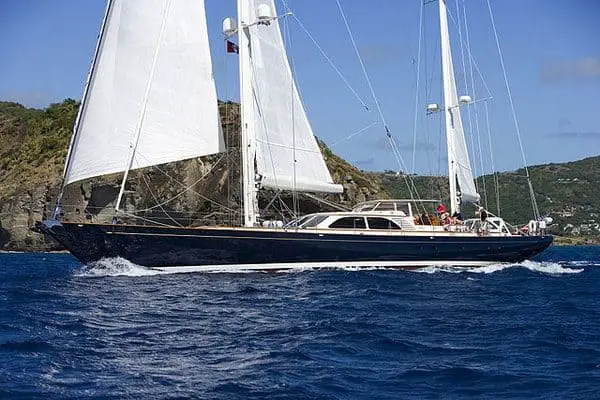
A ketch is a less common setup when compared to the previous setups since it has two masts.
Just like a sloop, it has a mast that allows for a mainsail and headsail with a full range forestay, but it also has a smaller sized mast between the mainmast and the stern of the sailboat.
This mast configuration was commonly used in Northern European freighter and fishing boats and is called the mizzen mast.
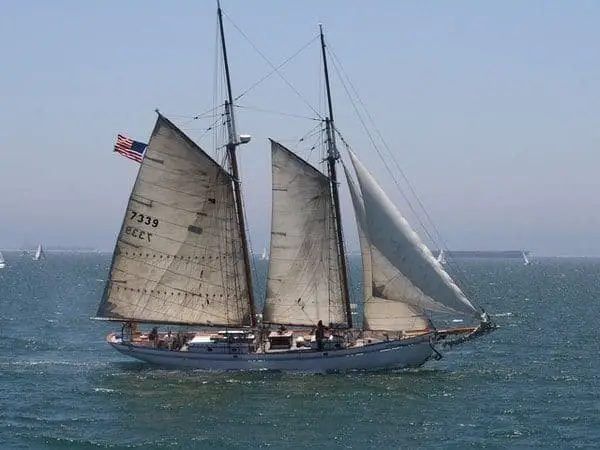
If you’ve ever seen Pirates of the Carribean, you’ll have seen almost nothing but schooners. A schooner is when a sailboat has two or more masts, similar to a ketch, while having a number of sails to manage.
The main differences between a ketch and a schooner are that a schooner’s aft mast (the rear mast) is taller than the forward mast and a schooner can have up to six masts some including a square sail or two. This makes names of sails on a schooner the fore and aft sail (or fore and aft rig).
A yawl is almost identical to a ketch with the only difference being that the mizzen mast is located directly behind the sailboat’s rudder post. In terms of a ketch vs yawl, the mizzen sail is also much smaller than the mizzen sail on a ketch due to its position on the sailboat.
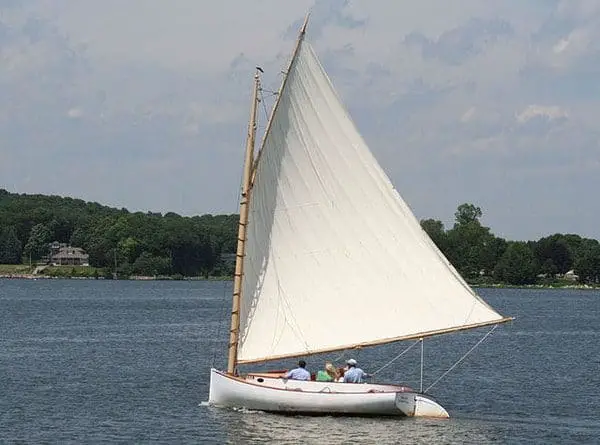
A cat has one mast and one sail with the mast being positioned at the bow of the sailboat. This mast configuration is most commonly found on smaller sailboats, especially dingy sailboats. These types of sailboats are colloquially called “catboats”.
Get the very best sailing stuff straight to your inbox
Nomadic sailing.
At Nomadic Sailing, we're all about helping the community learn all there is to know about sailing. From learning how to sail to popular and lesser-known destinations to essential sailing gear and more.
Quick Links
Business address.
1200 Fourth Street #1141 Key West, FL 33040 United States
Copyright © 2024 Nomadic Sailing. All rights reserved. Nomadic Sailing is a participant in the Amazon Services LLC Associates Program, an affiliate advertising program designed to provide a means to earn fees by linking to Amazon.com and affiliated sites.
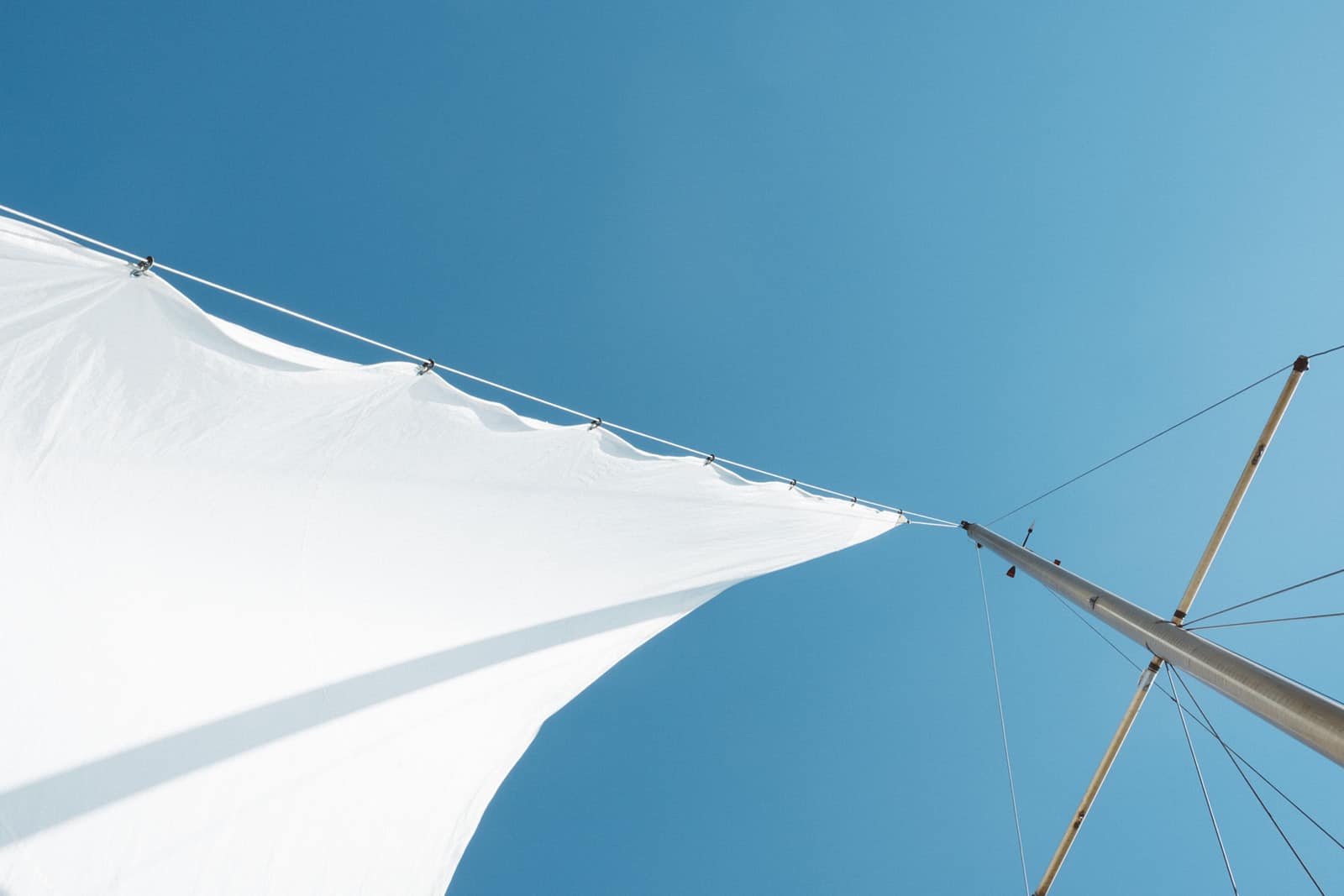
Names Of Sails on a Sailboat: What Are The Most Common Types Of Sails?
In this article, you are going to see more about the world of sailing.
There are different types of sails used in specific boats.
Check out some of the names of sails listed below to find out the most common sails names …
Drifter / Reacher Sail
Common types of sails.
This is the largest piece of the mast in a sailing vessel.
However, on a square vessel, it is the lowest on the main-mast.
The mast is responsible for the navigation of the boats from one end to the next.
Perhaps, it is safe to say that the speed of the bat will be determined by this piece of sail.
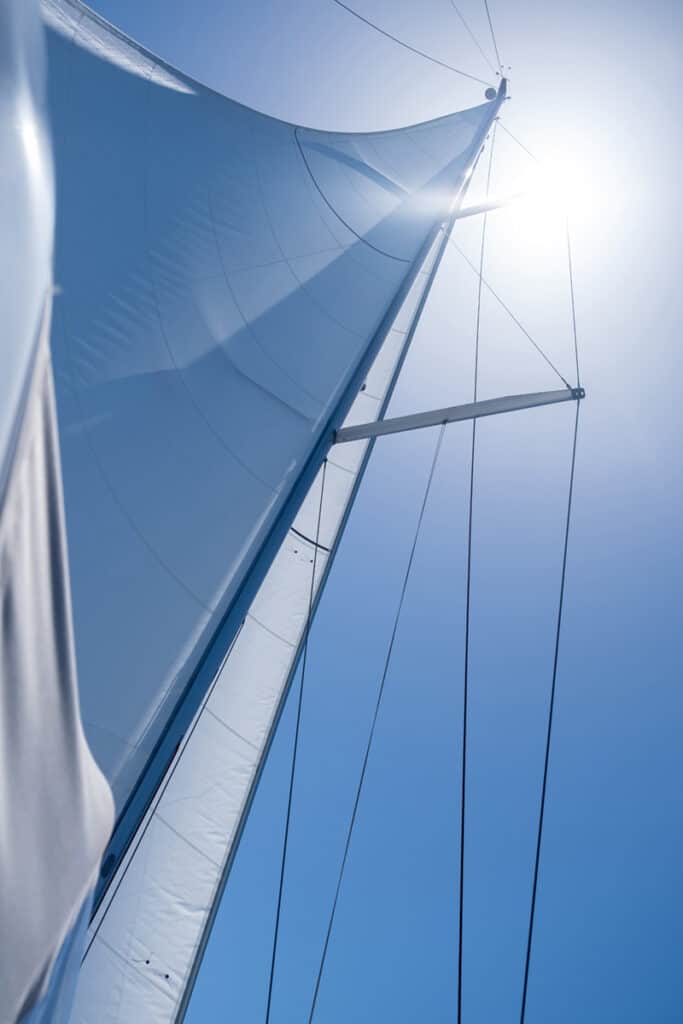
This type of sail is always triangular although, some of them always have four corners.
The triangular staysails that are used at the foremost position on the boat are called jibs.
In boats, these rigs help in tacking which will further help in preventing the lumbering up of the windward side.
Genoa is the largest jib that overlaps the mainsail.
It extends past the mast when you have a different view from the side.
The jib was originally given the name overlapping jib, which further changed to what you know it for today.
However, it is only fair to know in what types of boats the jib is well fitted to work.
You can find them in boats such as yawls and ketches.
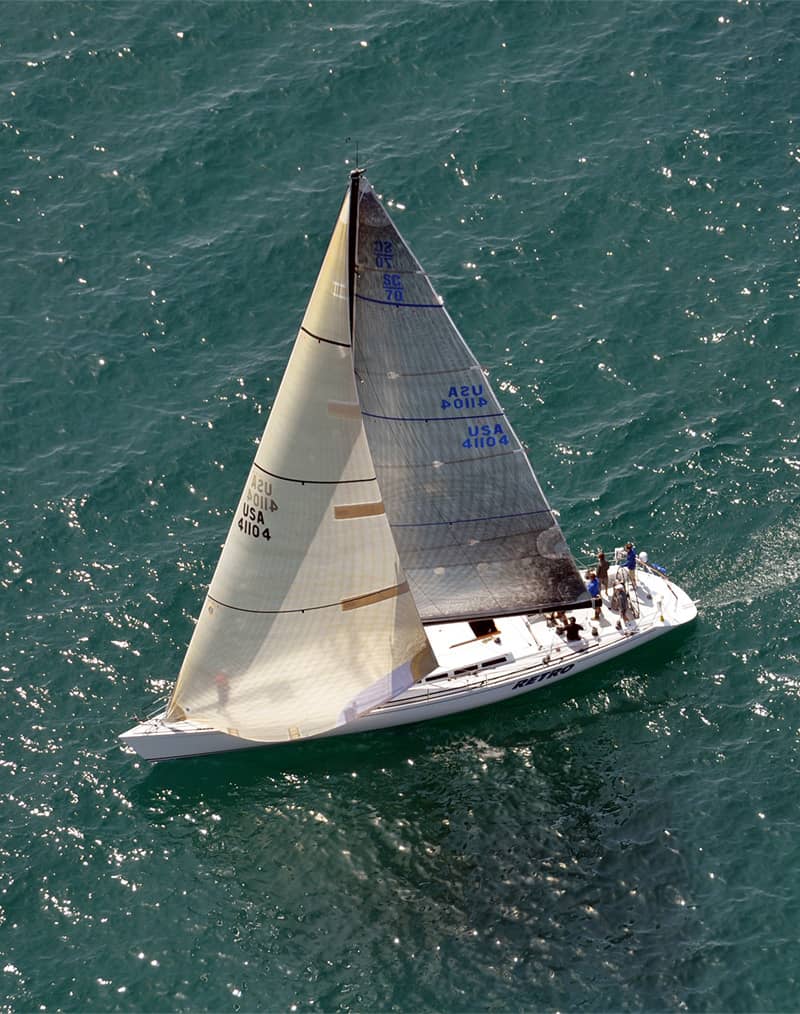
Spinnaker is a different type of sail due to the functions it performs on the movement of the boat.
It is designed for sailing off the wind from reaching the downwind.
As the boat is in motion, the spinnaker is filled up with wind creating a balloon like shape.
It has a construction that is purely made out of lightweight fabric like the nylon.
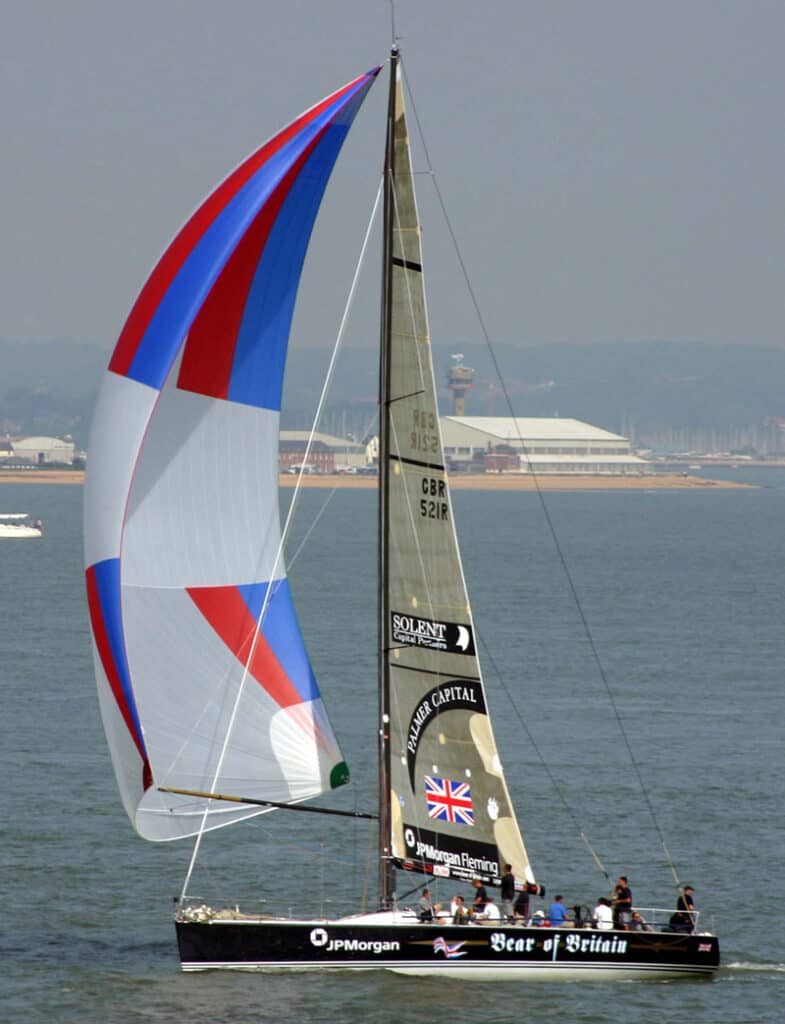
The Gennaker has recently been developed in the 90’s which a design showing that it is majorly, a crossover between Genoa and the spinnaker. Gennaker is rigged as the spinnaker but it’s tack is fastened to the hull.
The best thing about it is that it can obtain the optimum generation of lift within a short period of time.
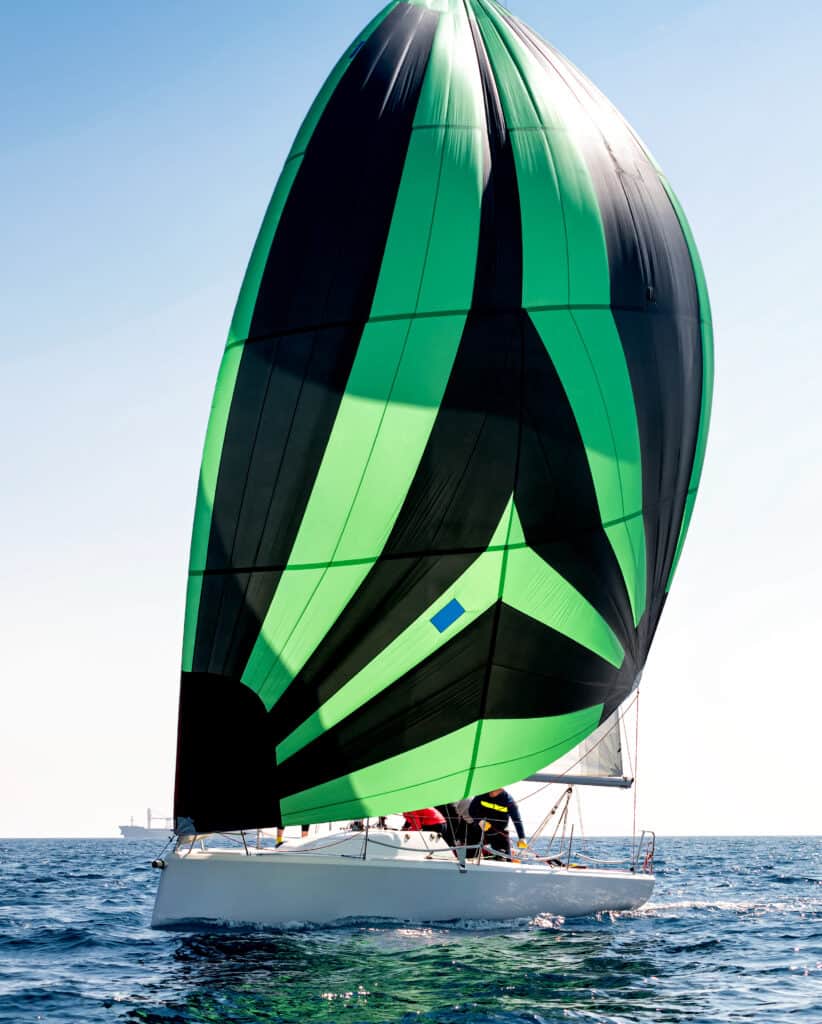
The drifter is a full draft lightweight made of nylon.
Drifters are designed with the ultimate purpose of cruising the sailors.
A drifter can make the work of a spinner much easier when cruising a spinmaker.
The best thing about drifters is that they come in different choices of colours and so you have the choice to mix and match.
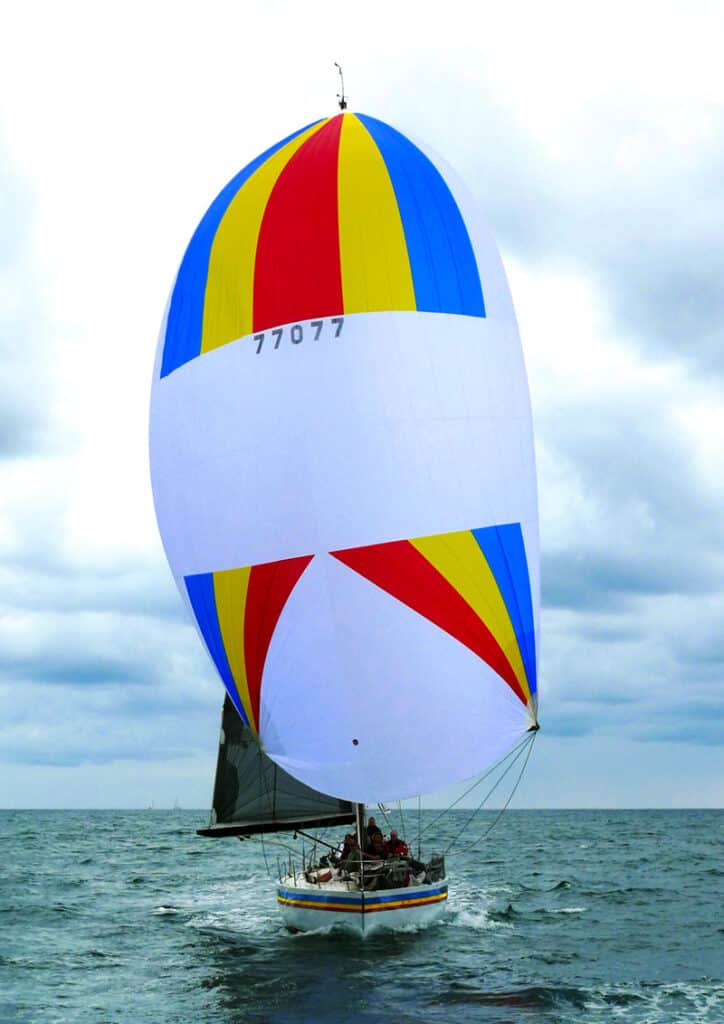
The most common types of sails are as follows:
- Drifter / Reacher
So, these are what you’ll find most commonly on boats.
Disclaimers
All product names, logos, and brands are property of their respective owners. All company, product and service names used in this website are for identification purposes only. Use of these names, logos, and brands does not imply endorsement.
It is our policy to make every effort to respect the copyrights of outside parties. If you believe that your copyright has been misused, please provide us with a message stating your position and we will endeavor to correct any misuse immediately.
Some of the links in this post are affiliate links. As an Amazon Associate, we earn from qualifying purchases. This means if you click on the link and purchase the item, we may receive an affiliate commission, at no extra cost to you. This helps us keep this website alive. Learn more here .

Hi, I’m Igor, Skipper of S/Y "The Hooker". A decade ago, I conquered my childhood dream: to be a sailing skipper, own a sailing yacht. Yes, it knocked dullness out of my urban life — Read more →
Leave a Reply Cancel Reply
Your email address will not be published. Required fields are marked *
Name *
Email *
Add Comment *
Save my name, email, and website in this browser for the next time I comment.
Post Comment
Related Posts
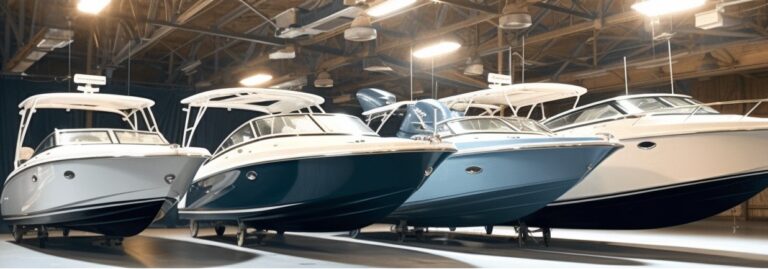
Which Type Of Hull Rides On Top Of The Water Rather Than Pushing The Water Aside?
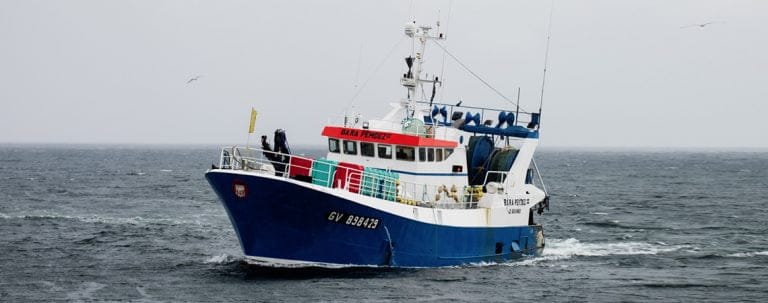
How Should You Pass a Fishing Boat
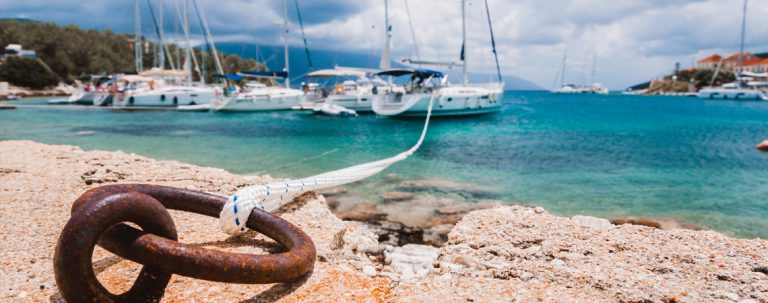
How to Beach a Boat & Best Boat Beach Anchors
Amazon Disclosure
DesperateSailors.com is a participant in the Amazon Services LLC Associates Program, an affiliate advertising program designed to provide a means for sites to earn advertising fees by advertising and linking to Amazon.com. As an Amazon Associate, we earn from qualifying purchases. Amazon and the Amazon logo are trademarks of Amazon.com, Inc., or its affiliates.
Please refer to our Privacy & Affiliate policy for more details.
Names of Sails on a Sailboat: A Comprehensive Guide
by Emma Sullivan | Jul 22, 2023 | Sailboat Racing

Short answer: Names of sails on a sailboat:
Sails on a sailboat are commonly referred to by various names, including the mainsail, jib, genoa, spinnaker, staysail, and mizzen. Each sail serves a specific purpose in harnessing wind power for propulsion.
Understanding the Basics: A Guide to the Names of Sails on a Sailboat
As you embark on your sailing adventure, it is crucial to familiarize yourself with the various parts and components of a sailboat. One essential element that plays a significant role in harnessing the wind’s power is sails. Sails can be compared to the engine of a vessel, propelling it forward gracefully through the water. To fully comprehend this integral aspect of sailing, we present this guide unraveling the names and purposes of different sails.
1. Mainsail: The mainsail is arguably one of the most vital sails on any sailboat. Positioned on the mast behind or beside it, this large triangular-shaped sail captures wind from straight ahead and turns it into forward momentum. Its position allows for effective control over direction due to its proximity to the centerline of the boat.
2. Headsail: Also known as foresail or jib, this sail is situated at the front (bow) part of most sailboats. Typically smaller in size than the mainsail, headsails come in several variants like genoa or jib/genaker. These versatile sails capture wind approaching from astern or slightly off-center, translating it into additional speed by working in conjunction with the mainsail.
3. Spinnaker: Known for its eye-catching colors and impressive size, spinnakers are designed specifically for downwind sailing when winds are coming directly from behind your vessel’s mainline heading toward 180 degrees opposite to your bow direction. As a powerful reaching sail, they help maximize speed while adding an aesthetic flair to your boat’s appearance.
4. Staysail: Often employed aboard larger vessels or heavier cruisers, staysails serve as useful additions in various wind conditions. Positioned between headstay and mast or bowsprit, these smaller triangular-shaped sails come into play during close-hauled points of sail when heightened maneuverability is required.
5. Storm Sails: No sailing guide would be complete without mentioning storm sails. As their name implies, they are specifically designed to withstand rough weather conditions and high winds usually experienced during storms. These small but mighty sails provide an essential means of maintaining control while keeping the rest of the boat safe.
6. Mizzen/Mizzen Staysail: Primarily found on ketches and yawls, mizzen refers to the third mast or sail positioned towards the rear of the vessel. This secondary mainsail can either be triangular or quadrilateral and plays a crucial role in balancing the boat’s overall sail plan.
Now that you have familiarized yourself with some primary sail terminology, it’s important to remember that customization options abound when it comes to your sailboat setup. Different boats will possess various combinations, modifications, and additions to improve performance in specific sailing conditions or personal preferences.
Armed with this knowledge, not only will you impress your fellow sailors with your understanding of proper nautical terminology, but you will also ensure a more successful sailing experience as you adapt to different wind angles and conditions. So next time you hit the open waters, take a moment to appreciate the beauty and intricacy behind those marvelous sails propelling you forward into exhilarating adventures ahead!
How to Identify and Navigate with Different Sail Names on a Sailboat
Sailboats are universally admired for their grace and elegance as they glide across the water, propelled solely by the power of the wind. With their towering masts and billowing sails, these vessels offer a unique experience for sailors both new and seasoned. However, for those unfamiliar with the various sail names used on sailboats, it can be a daunting task to understand how to identify and navigate with them effectively. In this blog post, we will delve into this fascinating world, providing you with detailed professional insights on how to decipher different sail names and make the most out of your sailing adventure.
Before delving into the specifics, it is essential to grasp the underlying principle behind different sail names. Sailboats typically employ multiple sails to harness the wind efficiently depending on its direction and strength. Each distinct type of sail possesses specific characteristics that enable sailors to navigate effectively in various conditions. By understanding these sails’ capabilities, you can optimize your boat’s performance regardless of whether you’re leisurely cruising or competing in regattas.
1. Mainsail: The mainsail is arguably the most recognizable sail on a sailboat as it is usually situated aft (at the back) of the mast. Its primary function is to provide propulsion and stability when sailing close-hauled or reaching (sailing at an angle to the wind). The mainsail predominately catches air from one side but can also incorporate battens (stiffeners) along its length if needed for additional rigidity.
2. Jib / Genoa: Located forward of the mast, near the bow section of a sailboat, jibs or genoas are smaller triangular-shaped sails that enable boats to catch crosswind efficiently when tacking (turning through or against the wind). These versatile sails drastically improve maneuverability by creating additional lift without sacrificing control over steering.
3. Spinnaker: The spinnaker is the flamboyant, brightly colored sail that often adds a touch of drama to sailboats gliding through the water. This sail is exclusively used when sailing downwind – with the wind coming from behind or abeam (sideways) – and excels in light to moderate winds. It provides significant boosting power by capturing the maximum amount of available air, propelling boats at thrilling speeds.
4. Storm Jib: As its name suggests, a storm jib comes into play during adverse weather conditions that require reduced sail area for safety purposes. Smaller in size than a regular jib, it enables sailors to maintain control and stability during high winds and rough seas, offering a secure option when facing challenging weather situations.
Now that we have familiarized ourselves with these different sail names let’s delve into some tips on how to navigate effectively using them:
– Close-hauled Sailing: To maximize your efficiency while sailing close-hauled (directly against the wind), it is crucial to trim your mainsail appropriately. By adjusting the sheet angle and tensioning both horizontally and vertically, you can attain the perfect balance between speed and power.
– Reaching / Broad Reach: When navigating at an angle to the wind on a reach or broad reach, deploying a powerful genoa or jib becomes essential as it helps generate additional lift while maintaining control over steering. Adjusting these sails’ position can optimize performance based on changing wind angles.
– Downwind Sailing: When sailing downwind, embracing the exhilarating use of a spinnaker can bring immense joy as your boat surges forward propelled by this colossal canvas of cloth. However, mastering spinnaker handling requires practice due to its sheer size and potential for accidental gybes (when your boom suddenly swings across).
– Stormy Weather Conditions: Prioritize safety above all else when facing severe storms by promptly replacing regular sails with storm jibs. These smaller, resilient sails are designed to withstand high winds and enable you to maintain control over your boat even in rough weather.
By familiarizing yourself with these sail names and their optimal usage, you can unlock your full sailing potential. Whether leisurely exploring serene waters or competing in exhilarating races, harnessing the power of different sails will elevate your experience on the open seas. So set sail, embrace the wind, and let the magic of sailboat navigation unfold before you!
Step-by-Step Explanation: Learning the Names of Sails on a Sailboat
Ahoy, fellow sailors and sailing enthusiasts! Today, we embark on a journey to demystify the world of sails. Whether you’re new to sailing or just looking to expand your nautical vocabulary, this step-by-step guide will leave you confident in conversing about sails with even the most seasoned sea dogs.
Step 1: The Mainsail – The Queen of the Sails
Let’s start with the grand dame of all sails – the mainsail. It is located at the back (aft) of the sailboat and is attached to the mast by halyards and controlled by multiple lines called sheets. The mainsail is typically triangular in shape and bears most of a sailboat’s propulsion force. As we unravel its intricacies, remember that understanding how it works sets the foundation for comprehending other sails.
Step 2: Discovering Headsails – Jib & Genoa
Now that we’ve gotten acquainted with our esteemed mainstay, let’s unfurl another essential player in our sail ensemble – headsails. Headsails are positioned nearer to the bow than the mainsail and come in two primary types: jibs and genoas.
The jib modestly complements our queen; it has a relatively small size and attaches directly to its own stay or forestay wire at its leading edge. Jibs aid maneuverability and provide additional power when combined with the mainsail for upwind sailing.
The genoa, on the other hand, deserves recognition as an exuberant cousin of jib sailedoes! It extends past half or more of a boat’s length – as big as it gets without entering spinnaker territory. Genoas are perfect for downwind voyages or when capturing every breath of wind necessary to propel us through light breezes.
Step 3: Welcome Aboard the Staysail
As we traverse our way toward the middle of the sailboat, we greet the humble yet mighty staysail. Positioned between the mainsail and mast, this triangular sail often resembles a smaller version of a jib. It is attached to its stay at the front and can be used in combination with other sails or flown alone when conditions call for it. Staysails offer enhanced stability during turbulent weather conditions, making them essential components of any sailor’s repertoire.
Step 4: The Mighty Spinnaker – Letting Creativity Soar!
Finally, let us reveal one of sailing’s showstoppers – the unruly and exhilarating spinnaker. This bold sail explores uncharted territories when it comes to design! Its exotic shape resembles a parachute, capturing every zephyr of wind from astern or to the side. While it requires expertise to master, once hoisted up using halyards and poles, it adds a touch of magic to any sailing voyage worthy of awe-inspiring photographs.
Step 5: Bonus Round: Auxiliary Sails & Specialty Sails
While we’ve acquainted ourselves with some main cast members, an honorable mention goes out to auxiliary sails that assist in specific situations. For instance, we have mizzens, gallants sails, or even flying jibs which are deployed on particular types of vessels or specialized racing yachts.
Conclusion:
Congratulations on navigating through this step-by-step learning experience about sail names on a sailboat! By understanding each component’s purpose – from the majestic mainsail to thrilling spinnakers – you’re now equipped with knowledge allowing you to converse confidently about all things sailing-related. So go forth and impress your fellow sailors with your newfound wit and wisdom as you embark on incredible voyages aboard magnificent sailboats!
Frequently Asked Questions about the Names of Sails on a Sailboat – Answered!
Introduction: The Names of Sails on a Sailboat – Unveiling the Mysteries
Have you ever found yourself staring out at the sea, watching sailboats glide gracefully through the waves and wondered about the intriguing names adorning their sails? If so, you’re not alone! Querying minds have pondered over these sail monikers for centuries. In this blog post, we aim to shed light on frequently asked questions surrounding the names of sails on a sailboat. Get ready to set sail into a world of nautical knowledge!
1. What is the Main Sail, and Why is it Called That?
The mainstay of every sailing vessel’s sail inventory is appropriately named the “main sail.” This massive piece of fabric catches the wind head-on, providing power and propulsion to move your boat forward. Its name originates from its primary nature – being central or “main” in size and function. So next time you spot an impressive main sail, remember that it plays a leading role in navigating the high seas!
2. A Jib Explained – What’s Behind its Strange Name?
Imagining sails fluttering with exotic names might evoke images of adventure and mystery. However, when it comes to jibs, there isn’t any secret code hidden within its title. The term “jib” simply references a smaller triangular-shaped foresail positioned forward of the mast. Don’t be fooled by its modest appearance; this nimble sail helps redirect airflow smoothly across other sails while enhancing maneuverability.
3. The Genoa – Is It All About Italian Flavor?
Ahoy there! Prepare to be transported to Italy as we explore one of sailing’s beloved companions – the genoa. Although synonymous with Italy’s picturesque coastlines and vibrant culture, this sail owes its name not to pasta or gondolas but rather an Italian seashore city called Genoa (Genova). This large jib-like headsail boasts significant surface area, amplifying a boat’s speed as if it were effortlessly dancing along the Italian Riviera.
4. What About Mainsail’s Smaller Cousin – The Mizzensail?
Brace yourselves, sailors! It’s time to delve into the world of lesser-known sails. Enter the mizzensail – a smaller sail located behind the mainmast and typically found on larger sailing vessels. This mysterious name originates from “mizzen,” which refers to a mast situated aft or nearer toward the stern of the vessel. While its name might sound peculiar, this auxiliary sail plays a crucial role in maintaining balance as it assists with steering and maneuvering capabilities.
5. Unveiling the Secrets Behind Spinnakers
Are you ready for a whirlwind adventure? Let’s set sail with one of sailing’s most captivating inventions – the spinnaker sail! This sizable, colorful parachute-like cousin of other sails is designed for downwind sailing exhilaration. With origins in both German and Dutch seafaring cultures, its name derives from “spinner,” meaning a spider hanging by its web or someone spinning something rapidly – reflecting both its expansive shape and speedy performance possibilities.
Conclusion: Sailboat Sails – Stories Unfolded!
As you gaze out at the majestic sight of sails fluttering in unison on a sailboat, don’t just admire their beauty; grasp their captivating stories too! From towering mainsails to spirited genoas and enigmatic spinnakers, these names now carry newfound meaning beyond their initial allure. So next time your curiosity is piqued by the names adorning these magnificent sails, remember our charming explanations that navigate through centuries of seafaring heritage!
Exploring the Significance and Functionality of Each Sail Name on a Sailboat
When it comes to sailing, each sail on a sailboat has its own significant role and functionality. These sails are carefully designed and strategically positioned to ensure optimal performance and control on the open water. In this blog post, we will take a closer look at the significance and functionality of each sail name on a sailboat, unraveling the intricate web of maritime engineering.
1. Mainsail: The mainsail, as the name suggests, is the primary sail on a sailboat. It is typically attached to the main mast vertically and plays a crucial role in steering and propulsion. Its size and shape can be adjusted using various rigging techniques to adapt to different wind conditions. A well-trimmed mainsail facilitates efficient forward movement through the wind.
2. Jib: Positioned towards the front of the boat, just ahead of the mast, is the jib. This triangular-shaped sail works in harmony with the mainsail, creating balance and stability by capturing air from both sides of the boat. The jib helps increase speed while reducing heeling (the leaning of a boat), allowing for better control in gusty winds.
3. Genoa: The genoa is similar to a jib but larger in size. It extends farther back along the mast, covering a larger area than a typical jib would. This primarily provides additional power when sailing downwind or reaching (sailing across/across/towards) off-wind directions.
4. Spinnaker: When it’s time to embrace pure downwind speed, there’s no friend like the spinnaker! This large balloon-shaped sail flies ahead of all other sails on light wind days or during downwind racing maneuvers such as gybing (changing direction). Its design allows it to capture maximum airflow from behind or adjacent to your course as you surf down waves and maintain momentum—a true adrenaline rush for any sailor!
5. Storm Sails: As seafarers, we must always be prepared for inclement weather. Storm sails, often made of heavy-duty and highly durable materials, are designed to withstand high winds and turbulent conditions. These small, compact sails are hoisted in place of the mainsail and jib to maintain control during storms or adverse weather situations.
6. Headsail/Roller-furling jib: Convenience comes into play with the headsail or roller-furling jib. This sail can be easily adjusted or furled (rolled) using a mechanical system integrated into the boat’s rigging. It allows for quick and efficient changes when transitioning between different wind strengths or directions without requiring significant crew effort.
Each sail on a sailboat holds its own significance in shaping the vessel’s performance, efficiency, and safety on the water. Understanding their functionality empowers sailors to make tactical decisions that maximize speed and minimize risk. From powering through headwinds with a well-trimmed mainsail to embracing spontaneity with a spinnaker on calm days, each sail name carries a purposeful role in the intricate dance between vessel and nature’s elements.
So next time you set foot on a sailboat, take notice of these sails’ names; they are far more than mere decorative pieces fluttering in the breeze – they are indispensable tools in the artistry of sailing!
Mastering the Language of Sailing: Unveiling the Secrets behind Names of Sails on a Sailboat
Welcome aboard, fellow sailing enthusiasts! Today, we embark on an exciting journey to unravel the secrets behind the names of sails on a sailboat. Sailing is not just a sport; it’s an art form that requires both skill and finesse. Much like language, sailing has its own unique vocabulary that speaks volumes about the majestic dance between wind and water. So, let’s set our sails high and dive into the nautical lexicon!
First, we encounter the mighty mainsail, often considered the backbone of any sailboat. This triangular masterpiece is attached to the mast at its luff or leading edge and stretches aft towards the stern. It holds immense power as it catches the wind head-on, propelling us forward like a bird in flight. Aptly named “mainsail” because it is indeed our main source of propulsion.
Next on our list is the genoa – a versatile and indispensable sail fit for open waters. Whether you’re cruising or racing, this large foresail takes center stage with its dominant presence in front of the mast. Its name derives from Genoa in Italy where sailors first began using this powerful headsail. Eager to embrace any challenge thrown its way, the genoa wraps itself around any adventure with unwavering determination.
Now, let’s tack towards lighter winds where we discover a hidden gem called the spinnaker. As gentle zephyrs caress your boat’s hull, this vibrant sail leaps to life like a rainbow unfurling in slow motion. Shaped like an enormous balloon with a mouth-watering variety of colors at its disposal, it adorns our vessel during downwind courses or when breeze gets too light for other sails to catch hold. The name “spinnaker” arises from its unique ability to spin outwards from regular racing sails; truly a breathtaking spectacle that turns heads everywhere we go.
Ahoy there! Look up towards your tallest mast and you might spot a triangular sail defying gravity – the topsail. Historically, this sail served as an additional square-rigged sail above the lower sails back in the days of tall ships. Nowadays, it has shrunk in size but gained prominence as a brilliant display of seamanship. The topsail is often hoisted to maximize performance and impress fellow sailors with its elegance.
As we dive deeper into nautical terminology, let’s not forget about some more technical names like the jib, staysail, and gennaker. The jib is a smaller foresail that complements the genoa in light winds or tight maneuvers – always ready to lend a helping hand. Meanwhile, the staysail thrives on multi-masted vessels or cutter rigs, hugging closely to stay taught against its supporting mast. Lastly, we have the gennaker – a lovely hybrid between genoa and spinnaker designed to power us through broad reaches with finesse.
Now that we’ve unveiled a few secrets behind the names of sails on a sailboat, may you feel empowered and enlightened as you navigate both language and sea with confidence. Remember: sailing is more than just harnessing nature’s elements; it’s about understanding their subtleties and speaking their language fluently.
So hoist your sails high and proudly proclaim yourself a master of this beautiful language of sailing! Happy adventuring out there on the vast blue horizon!
Recent Posts

- Sailboat Gear and Equipment
- Sailboat Lifestyle
- Sailboat Maintenance
- Sailboat Racing
- Sailboat Tips and Tricks
- Sailboat Types
- Sailing Adventures
- Sailing Destinations
- Sailing Safety
- Sailing Techniques

- Find A School
- Certifications
- North U Sail Trim
- Inside Sailing with Peter Isler
- Docking Made Easy
- Study Quizzes
- Bite-sized Lessons
- Fun Quizzes
- Sailing Challenge

Parts of a Sailboat – The Sails
By: Zeke Quezada, ASA Learn To Sail , Sailboats
It’s safe to say a sailboat is only as good as its sails when you consider that capturing the wind’s energy is the premise behind what sailors do to propel their boats in a forward direction. A good captain will trim those said sails to be as efficient as possible and the proper heading will help with overall performance, but the sail is the driving force of the boat.
Naturally, we should know the difference between the various sails and how they work.
These are the sails that you would find on a generic keelboat rigged as a sloop. It is, in fact, the common of sail plans and thus serves us well for this explanation of sails and their duties on a sailboat.
The Mainsail : It has its forward edge attached to the mast
The Headsail : This is a generic term that refers to any sail that sits forward of the mast. The most common is the Jib. When a jib is so large that it overlaps the mast it is called a genoa.

Parts of a Sail
- Luff -A sail’s forward edge. The luff of the mainsail is usually hoisted up and attached to the mast. The luff of the jib is attached to the forestay.
- Leech – The sail’s back edge.
- Foot – The bottom edge of the sail
- Tack – Between the luff and the foot is the tack. The tack is attached to the boat or a spar.
- Head – The corner at the top of the sail between the luff and the leech.
- Clew – The third triangle of a sail between the leech and the foot.
- Batten – Solid slats or rods to help maintain the desired airfoil shape.
Learning to Sail
- ASA 101: What You’ll Learn ASA 101 is your introduction to Basic Keelboat Sailboat and is your key to a lifetime of sailing.
- How To Sail Sailing a boat is part art and part skill but few activities offer such a variety of pleasures as sailing. Something special occurs when you cast off the lines and leave your cares at the dock.
- 7 Tips For The Beginning Sailor There are the obvious things you need when you go sailing, sunscreen, a hat, a windbreaker, non-skid shoes, and wind. However, what do you really need to be ready to head out on the water?
- How To Learn To Sail You won’t have to buy a boat or learn a new language or buy a new wardrobe to get a taste for sailing. You can dictate how much you want to experience.
- Learning To Sail Is Just The Beginning Sailing means different things to different people. At ASA we understand that learning to sail is just the beginning of a relationship with a lifestyle that is infectious. Where will sailing take you? We have a few ideas but how you view sailing is the most important.
- What Is Your Role on a Boat? What type of sailor are you and what role do you take on the boat? Your ASA sailing education will prepare you to be a skipper on a sailing vessel and with that comes the responsibility of keeping your crew safe and ensuring the safety of the vessel you are sailing.
Related Posts:

- Learn To Sail
- Mobile Apps
- Online Courses
- Upcoming Courses
- Sailor Resources
- ASA Log Book
- Bite Sized Lessons
- Knots Made Easy
- Catamaran Challenge
- Sailing Vacations
- Sailing Cruises
- Charter Resources
- International Proficiency Certificate
- Find A Charter
- All Articles
- Sailing Tips
- Sailing Terms
- Destinations
- Environmental
- Initiatives
- Instructor Resources
- Become An Instructor
- Become An ASA School
- Member / Instructor Login
- Affiliate Login

Types of Sailboats: A Complete Guide

Learning the different types of sailboats can help you identify vessels and choose the right boat.
In this article, we'll cover the most common kinds of sailboats, their origins, and what they're used for. We'll also go over the strengths and weaknesses of each design, along with when they're most useful.
The most common kind of sailboat is the sloop, as it's simple to operate and versatile. Other common sailboat types include the schooner, cutter, cat, ketch, schooner, catamaran, and trimaran. Other sailboat variations include pocket cruisers, motorsailers, displacement, and shoal-draft vessels.
The information found in this article is sourced from boat reference guides, including A Field Guide to Sailboats of North America by Richard M. Sherwood and trusted sources in the sailing community.
Table of contents
Distinguishing Types of Sailboats
In this article, we'll distinguish sailboats by traits such as their hull type, rig, and general configuration. Some sailboats share multiple characteristics with other boats but fall into a completely different category. For example, a sailboat with a Bermuda rig, a large engine, and a pilothouse could technically be called a sloop, but it's more likely a motorsailer.
When discerning sailboat type, the first most obvious place to look is the hull. If it has only one hull, you can immediately eliminate the trimaran and the catamaran. If it has two or more hulls, it's certainly not a typical monohull vessel.
The next trait to consider is the rig. You can tell a lot about a sailboat based on its rig, including what it's designed to be used for. For example, a long and slender sailboat with a tall triangular rig is likely designed for speed or racing, whereas a wide vessel with a complex gaff rig is probably built for offshore cruising.
Other factors that determine boat type include hull shape, overall length, cabin size, sail plan, and displacement. Hull material also plays a role, but every major type of sailboat has been built in both wood and fiberglass at some point.
Sailboat vs. Motorsailer
Most sailboats have motors, but most motorized sailboats are not motorsailers. A motorsailer is a specific kind of sailboat designed to run efficiently under sail and power, and sometimes both.
Most sailboats have an auxiliary engine, though these power plants are designed primarily for maneuvering. These vessels cannot achieve reasonable speed or fuel-efficiency. Motorsailers can operate like a powerboat.
Motorsailers provide great flexibility on short runs. They're great family boats, and they're popular in coastal communities with heavy boat traffic. However, these features come at a cost. Motorsailers aren't the fastest or most efficient powerboats, and they're also not the most agile sailboats. That said, they make an excellent general-purpose sailing craft.
Monohull vs. Multi-hull: Which is Better?
Multihull sailboats are increasingly popular, thanks to advances and lightweight materials, and sailboat design. But are they better than traditional sailboats? Monohulls are easier to maintain and less expensive, and they offer better interior layouts. Multihulls are more stable and comfortable, and they're significantly easier to control. Multihull sailboats also have a speed advantage.
Monohull Sailboats
A monohull sailboat is a traditionally-shaped vessel with a single hull. The vast majority of consumer sailboats are monohulls, as they're inexpensive to produce and easy to handle. Monohull sailboats are proven and easy to maintain, though they lack the initial stability and motion comfort of multi-hull vessels.
Monohull sailboats have a much greater rig variety than multi-hull sailboats. The vast majority of multihull sailboats have a single mast, whereas multi-masted vessels such as yawls and schooners are always monohulls. Some multi-hull sailboats have side-by-side masts, but these are the exception.
Catamaran Sailboats
The second most common sailboat configuration is the catamaran. A catamaran is a multihull sailboat that has two symmetrical hulls placed side-by-side and connected with a deck. This basic design has been used for hundreds of years, and it experienced a big resurgence in the fiberglass boat era.
Catamarans are fast, efficient, and comfortable. They don't heel very much, as this design has excellent initial stability. The primary drawback of the catamaran is below decks. The cabin of a catamaran is split between both hulls, which often leaves less space for the galley, head, and living areas.
Trimaran Sailboats
Trimarans are multi-hull sailboats similar to catamarans. Trimarans have three hulls arranged side-by-side. The profile of a trimaran is often indistinguishable from a catamaran.
Trimarans are increasingly popular, as they're faster than catamarans and monohulls and considerably easier to control. Trimarans suffer from the same spatial limitations as catamarans. The addition of an extra hull adds additional space, which is one reason why these multi-hull vessels are some of the best-selling sailboats on the market today.
Sailboat Rig Types
Rigging is another way to distinguish sailboat types. The rig of a sailboat refers to it's mast and sail configuration. Here are the most common types of sailboat rigs and what they're used for.
Sloops are the most common type of sailboat on the water today. A sloop is a simple single-mast rig that usually incorporates a tall triangular mainsail and headsail. The sloop rig is easy to control, fun to sail, and versatile. Sloops are common on racing sailboats as they can sail quite close to the wind. These maneuverable sailboats also have excellent windward performance.
The sloop rig is popular because it works well in almost any situation. That said, other more complex rigs offer finer control and superior performance for some hull types. Additionally, sloops spread their entire sail area over just to canvases, which is less flexible than multi-masted rigs. The sloop is ideal for general-purpose sailing, and it's proven itself inland and offshore.
Sloop Features:
- Most popular sailboat rig
- Single mast
- One mainsail and headsail
- Typically Bermuda-rigged
- Easy to handle
- Great windward performance
- Less precise control
- Easier to capsize
- Requires a tall mast
Suitable Uses:
- Offshore cruising
- Coastal cruising
Cat (Catboat)
The cat (or catboat) is a single-masted sailboat with a large, single mainsail. Catboats have a thick forward mast, no headsail, and an exceptionally long boom. These vessels are typically gaff-rigged, as this four-edged rig offers greater sail area with a shorter mast. Catboats were popular workboats in New England around the turn of the century, and they have a large following today.
Catboats are typically short and wide, which provides excellent stability in rough coastal conditions. They're hardy and seaworthy vessels, but they're slow and not ideal for offshore use. Catboats are simple and easy to control, as they only have a single gaff sail. Catboats are easy to spot thanks to their forward-mounted mast and enormous mainsail.
Catboat Features:
- Far forward-mounted single mast
- Large four-sided gaff sail
- Short and wide with a large cockpit
- Usually between 20 and 30 feet in length
- Excellent workboats
- Tough and useful design
- Great for fishing
- Large cockpit and cabin
- Not ideal for offshore sailing
- Single sail offers less precise control
- Slow compared to other rigs
- Inland cruising
At first glance, a cutter is difficult to distinguish from a sloop. Both vessels have a single mast located in roughly the same position, but the sail plan is dramatically different. The cutter uses two headsails and often incorporates a large spar that extends from the bow (called a bowsprit).
The additional headsail is called a staysail. A sloop only carries one headsail, which is typically a jib. Cutter headsails have a lower center of gravity which provides superior performance in rough weather. It's more difficult to capsize a cutter, and they offer more precise control than a sloop. Cutters have more complex rigging, which is a disadvantage for some people.
Cutter Features:
- Two headsails
- Long bowsprit
- Similar to sloop
- Gaff or Bermuda-rigged
- Fast and efficient
- Offers precise control
- Superior rough-weather performance
- More complex than the sloop rig
- Harder to handle than simpler rigs
Perhaps the most majestic type of sailboat rig, the schooner is a multi-masted vessel with plenty of history and rugged seaworthiness. The schooner is typically gaff-rigged with short masts and multiple sails. Schooners are fast and powerful vessels with a complex rig. These sailboats have excellent offshore handling characteristics.
Schooners have a minimum of two masts, but some have three or more. The aftermost large sail is the mainsail, and the nearly identical forward sail is called the foresail. Schooners can have one or more headsail, which includes a cutter-style staysail. Some schooners have an additional smaller sale aft of the mainsail called the mizzen.
Schooner Features:
- At least two masts
- Usually gaff-rigged
- One or more headsails
- Excellent offshore handling
- Precise control
- Numerous sail options (headsails, topsails, mizzen)
- Fast and powerful
- Complex and labor-intensive rig
- Difficult to adjust rig single-handed
- Offshore fishing
Picture a ketch as a sloop or a cutter with an extra mast behind the mainsail. These vessels are seaworthy, powerful, excellent for offshore cruising. A ketch is similar to a yawl, except its larger mizzen doesn't hang off the stern. The ketch is either gaff or Bermuda-rigged.
Ketch-rigged sailboats have smaller sails, and thus, shorter masts. This makes them more durable and controllable in rough weather. The mizzen can help the boat steer itself, which is advantageous on offshore voyages. A ketch is likely slower than a sloop or a cutter, which means you aren't likely to find one winning a race.
Ketch Features:
- Headsail (or headsails), mainsail, and mizzen
- Mizzen doesn't extend past the rudder post
- Good offshore handling
- Controllable and mild
- Shorter and stronger masts
- Easy self-steering
- Slower than sloops and cutters
- Less common on the used market
A dinghy is a general term for a small sailboat of fewer than 28 feet overall. Dinghys are often dual-power boats, which means they usually have oars or a small outboard in addition to a sail. These small boats are open-top and only suitable for cruising in protected waters. Many larger sailboats have a deployable dinghy on board to get to shore when at anchor.
Dinghy Features:
- One or two people maximum capacity
- Easy to sail
- Works with oars, sails, or an outboard
- Great auxiliary boat
- Small and exposed
- Not suitable for offshore use
- Going from anchor to shore
- Protected recreational sailing (lakes, rivers, and harbors)
Best Sailboat Type for Stability
Stability is a factor that varies widely between sailboat types. There are different types of stability, and some sailors prefer one over another. For initial stability, the trimaran wins with little contest. This is because these vessels have a very high beam-to-length ratio, which makes them much less prone to rolling. Next up is the catamaran, which enjoys the same benefit from a wide beam but lacks the additional support of a center hull section.
It's clear that in most conditions, multihull vessels have the greatest stability. But what about in rough weather? And what about capsizing? Multihull sailboats are impossible to right after a knockdown. This is where full-keel monohull sailboats excel.
Traditional vessels with deep displacement keels are the safest and most stable in rough weather. The shape, depth, and weight of their keels keep them from knocking over and rolling excessively. In many cases, these sailboats will suffer a dismasting long before a knockdown. The primary disadvantage of deep-keeled sailboats is their tendency to heel excessively. This characteristic isn't hazardous, though it can make novice sailors nervous and reduce cabin comfort while underway.
Best Sailboat Type for Offshore Cruising
The best sailboat type for offshore cruising is the schooner. These graceful aid robust vessels have proven themselves over centuries as durable and capable vessels. They typically use deep displacement keels, which makes them stable in rough weather and easy to keep on course.
That said, the full answer isn't quite so simple. Modern multihull designs are an attractive option, and they have also proven to be strong and safe designs. Multihull sailboats are an increasingly popular option for offshore sailors, and they offer comfort that was previously unknown in the sailing community.
Many sailors cross oceans in basic Bermuda-rigged monohulls and take full advantage of a fin-keel design speed. At the end of the day, the best offshore cruising sailboat is whatever you are comfortable handling and living aboard. There are physical limits to all sailboat designs, though almost any vessel can make it across an ocean if piloted by a competent skipper and crew.
Best Sailboat Type for Racing The modern lightweight Bermuda-rigged sailboat is the king of the regatta. When designed with the right kind of hull, these vessels are some of the fastest sailboats ever developed. Many boats constructed between the 1970s and today incorporate these design features due to their favorable coastal and inland handling characteristics. Even small sailboats, such as the Cal 20 and the Catalina 22, benefit from this design. These boats are renowned for their speed and handling characteristics.
Related Articles
Daniel Wade
I've personally had thousands of questions about sailing and sailboats over the years. As I learn and experience sailing, and the community, I share the answers that work and make sense to me, here on Life of Sailing.
by this author
Learn About Sailboats
Most Recent

What Does "Sailing By The Lee" Mean?
October 3, 2023

The Best Sailing Schools And Programs: Reviews & Ratings
September 26, 2023
Important Legal Info
Lifeofsailing.com is a participant in the Amazon Services LLC Associates Program, an affiliate advertising program designed to provide a means for sites to earn advertising fees by advertising and linking to Amazon. This site also participates in other affiliate programs and is compensated for referring traffic and business to these companies.
Similar Posts

Affordable Sailboats You Can Build at Home
September 13, 2023

Best Small Sailboat Ornaments
September 12, 2023

Discover the Magic of Hydrofoil Sailboats
December 11, 2023
Popular Posts

Best Liveaboard Catamaran Sailboats
December 28, 2023

Can a Novice Sail Around the World?
Elizabeth O'Malley
June 15, 2022

4 Best Electric Outboard Motors

How Long Did It Take The Vikings To Sail To England?

10 Best Sailboat Brands (And Why)
December 20, 2023

7 Best Places To Liveaboard A Sailboat
Get the best sailing content.
Top Rated Posts
© 2024 Life of Sailing Email: [email protected] Address: 11816 Inwood Rd #3024 Dallas, TX 75244 Disclaimer Privacy Policy
NASA spacecraft captures 1st photo of its giant solar sail while tumbling in space
NASA's testing a solar sail system in space, and the spacecraft that brought the tech there has snapped a photo.

On April 23, NASA launched a solar sail protype to orbit around our planet — a piece of technology that could very well revolutionize the way we think about spacecraft propulsion. Then, on Aug. 29, the agency confirmed this sail successfully unfurled itself in outer space. Yet, we still didn't have official photographic evidence of this for some time.
Now, as of Sept. 5, we indeed do. NASA has released the first image of the open solar sail, formally called the Advanced Composite Solar Sail System, and stated that the spacecraft from which the sail was released will continue to send back more footage and data as time goes on.
The image itself may seem a little confusing to make heads or tails of, and that's due in part to the fact that the spacecraft has been slowly tumbling in space. The tumble is happening because, as NASA explains in a statement , the spacecraft didn't undergo any attitude control post-deployment. This behavior is therefore expected, the team says. Operators will implement attitude control and stabilize the spacecraft after collecting enough data to paint a picture of how the sail and the composite booms holding it together are doing. Hopefully, we'll get some easier-to-decode images after stability is achieved. But, in the meantime, let's talk about what we can actually see in this image.
As NASA says in the statement, it's important to first remember there are four wide-angle cameras in the center of the spacecraft anchoring the sail.
Near the bottom of the image, one camera view shows the "reflective sail quadrants supported by composite booms" while at the top of the photo, we can see the back surface of one of the craft's solar panels. Most spacecraft are lined with solar panels because that's how they power themselves up: with sunlight.
"The five sets of markings on the booms close to the spacecraft are reference markers to indicate full extension of the sail," the statement says. "The booms are mounted at right angles, and the solar panel is rectangular, but appear distorted because of the wide-angle camera field of view."
Related: Widespread solar storm struck spacecraft near the sun, Earth and Mars in quick succession
Sign up for the Live Science daily newsletter now
Get the world’s most fascinating discoveries delivered straight to your inbox.

The success so far of this mission is pretty awesome because solar sail technology is an incredibly impressive concept both in practice and in theory. Basically, it takes advantage of how photons, which are light particles, have the ability to impart pressure on an object despite being massless.
A solar sail looks like a flat sheet of material (not unlike a normal sail) and it can get quite large. In the case of NASA's Advanced Composite Solar Sail System, the sail is pretty much a square half the size of a tennis court at approximately 860 square feet (80 square meters). Most importantly, these sails can hypothetically be attached to spacecraft of any sort while sunlight particles beat down on their material.
Thus, like a sailboat on Earth is a vehicle propelled by the pressure of wind hitting its sail, a solar-sail-craft in space is one propelled by the pressure of sunlight hitting its sail. Not only would this mean a solar-sailing spacecraft can cut down on fuel necessities, but, theoretically, it should be able to reach very high speeds because it can attain fuel-less acceleration on an indefinite timescale.
— Elon Musk said he's 'definitely going to be dead' before humans go to Mars — and you probably will be too
— SpaceX Falcon 9 rocket grounded for 2nd time in 2 months following explosive landing failure
— Chinese rocket breaks apart after megaconstellation launch, creating cloud of space junk
However, the story can't reach such an epic finale without chapter one — and that's sort of where we are. Well, maybe chapter two or three because this new solar sail system isn't the first to be launched. The Japanese spacecraft Ikaros is responsible for the first successful solar sail deployment in 2010, and there have been a handful of other solar-sailing adventure attempts since then.
Still, the Advanced Composite Solar Sail System will make its mark in propulsion history. The next step for the team (after stabilizing the spacecraft and analyzing its flight dynamics) is to begin maneuvering the spacecraft in orbit. Meanwhile, you can try spotting the sail for yourself, in a fun turn of events. Ironically, the spacecraft's unstable trajectory right now makes it nice and shiny for anyone hoping to catch a glimpse it zooming across the night sky.
Originally posted on Space.com .
Monisha Ravisetti is Space.com's Astronomy Editor. She covers black holes, star explosions, gravitational waves, exoplanet discoveries and other enigmas hidden across the fabric of space and time. Previously, she was a science writer at CNET, and before that, reported for The Academic Times. Prior to becoming a writer, she was an immunology researcher at Weill Cornell Medical Center in New York. She graduated from New York University in 2018 with a B.A. in philosophy, physics and chemistry. She spends too much time playing online chess. Her favorite planet is Earth.
Watch Live: Boeing Starliner is about to return to Earth without its crew
NASA's newly unfurled solar sail has started 'tumbling' end-over-end in orbit, surprising observations show
What??? James Webb telescope finds giant question mark in space
Most Popular
- 2 'Microbes of death' can reveal when a frozen body died, forensic scientists explain
- 3 16,000-year-old skeleton, crystals and stone tools discovered in Malaysian caves
- 4 Astronaut watches a meteor explode over Earth in a bright green fireball in stunning video from ISS
- 5 Infamous 'Wow! signal' that hinted at aliens may actually be an exceptionally rare cosmic event
- Milano Cortina 2026
- Brisbane 2032
- Olympic Refuge Foundation
- Olympic Games
- Olympic Channel
- Let's Move
Meet the cyclors: Why Olympic cyclists and rowers like Hamish Bond are competing in sailing's America's Cup
Technology advances and rule changes for the 37th America's Cup in Barcelona resulted in a mass recruitment of power athletes and Olympic gold medallists. Here's why.
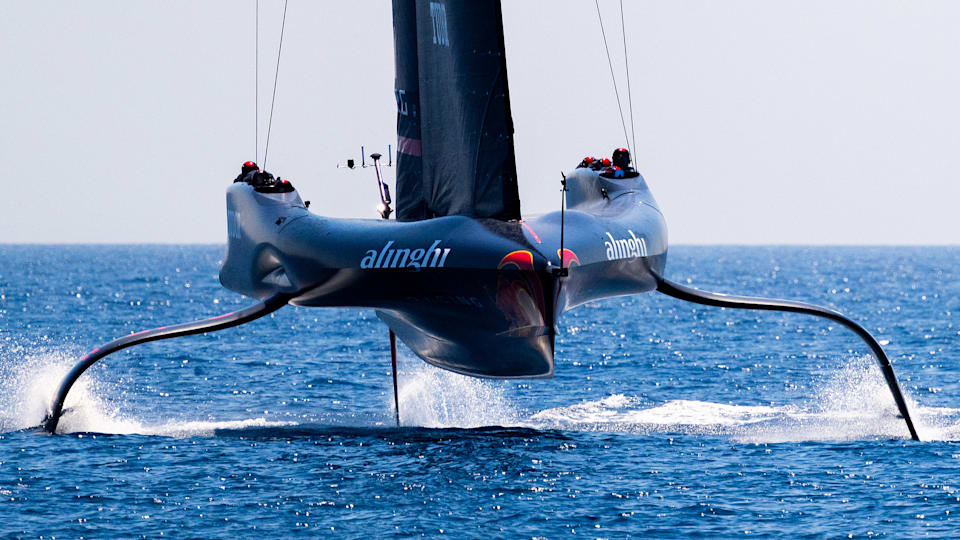
(2024 Getty Images)
The 37th America’s Cup in Barcelona has a distinctly Olympic look.
While sailing Olympic medallists are once again dotted throughout the teams, crews for the sport's oldest competition this year also feature several Olympic cycling and rowing stars, like Simon van Velthooven and Hamish Bond .
They are known as cyclors, given the job of powering the sails, masts, and winches, with their explosive raw strength.
- Olympic rowing champion Hamish Bond joins Team New Zealand for America's Cup
- Hamish Bond retires from rowing, leaving a sparkling Olympic legacy
The development of sailing cyclors
The cyclor’s job used to be done by sailors using arm-powered grinders.
But in 2017, the innovative New Zealand crew spotted an opportunity to gain an advantage over their rivals. Knowing that legs produce more power than arms, they recruited Olympic cyclist Van Velthooven, who won keirin bronze at London 2012, to help power their boat using a static pedalling system.
It was a huge success with the Kiwis sealing victory in Bermuda thanks to a reported 30% increase in watts produced by their cyclors .
That technology was outlawed in 2021, but a rule change for the 2024 edition meant that cyclors were allowed back in the boats.
A recruitment drive for Olympic athletes who don’t suffer from seasickness ensued with triple Olympic rowing champion and cycling national time trial champion Hamish Bond joining his nation’s team.
Elsewhere, former cycliing pursuit world champion Ashton Lambie is peddling for the American Magic crew, and the nature of the work has had a dramatic effect on his appearance.
"Even by cycling standards I was a fairly big guy, I am moderately well known for having big legs and they've gotten bigger since I've come here," Lambie told BBC Sport.
"During my racing career I was probably between 70 and 74kg, and now I've gained over 10kg. Most of it is muscle, and I've also gained watts. It's been a really big change.
America's Cup: The Formular 1 of the sea
The America’s Cup yachts operate at the intersection between physical prowess and advanced technology. As such, cyclors can track their progress on a screen below the deck showing their data.
While some teams positioned their cyclors upright, others have them lying flat in an attempt to maximise their watt output.
Given how much technology and investment is put into the America’s Cup boats, it’s easy to see why it is known as the Formula 1 of the sea.
It therefore also makes sense that the INEOS Britannia team, led by sailing Olympic champions Ben Ainslie and Dylan Fletcher , share their UK base with the Mercedes F1 team and utilise that expertise.
Interestingly, the Brits prefer Olympic rowers to power their boat, like Rio 2016 gold medal-winning Matt Gotrel, Olympic silver medallist Harry Leask , Matt Rossiter and Ryan Todhunter.
The onboard support crew features several more sailing Olympic champions in Giles Scott as Head of Sailing, and Australia's Iain Jensen as Trimmer Support, while Spain’s Xabi Fernandez is a coach.
Competing in the America’s Cup has made Thery Schir come full circle.
After attending a sailing school on the banks of Lake Geneva, he discovered a love for cycling. He competed at Rio 2016 and Tokyo 2020 on two wheels for Switzerland before transitioning back to become a cyclor for the Swiss Alinghi Red Bull Racing team in the America's Cup.
As an experienced Olympic athlete, he found many similarities between the two sports.
“It actually didn’t differ that much in terms of physical performance. I would say you try to be an endurance athlete but still with a strong capacity to deliver a high power output,” he told Sail World.
“The biggest difference for me was to gain weight and power. For a normal cyclist, it’s usually not very good, but for a cyclor it’s good to be heavy. The main difference is that on a road bike you have to carry your own weight. On the boat, it’s all about pure power. Nothing relative to your body weight.”
To add an extra layer of complexity to maintaining weight as a cyclor, athletes can lose up to three litres of water on a gruelling race day, that seperate the sport from anything he has experienced previously as an Olympian.
“The heat management will be a key component of the performance on the boat. For a 30-minute race you really need to control your hydration from the morning to the evening to make sure you’re not running out of energy. So, ice jackets, ice socks and cold baths after sailing!”
Crews are competing in the Louis Vuitton Cup from 29 August to 7 October, to battle for a place in the 37th America's Cup Match, which takes place from 12 to 27 October.
Related content
Hamish bond retires from rowing leaving a sparkling olympic legacy, new zealand name rugby 7s star sarah hirini and rowing champion hamish bond as flag bearers, olympic rowing champion hamish bond joins team new zealand for america's cup campaign, ainslie wants america’s cup glory ‘for queen and country’, sailing star ainslie brings home gold number four | london 2012.
Cookies on GOV.UK
We use some essential cookies to make this website work.
We’d like to set additional cookies to understand how you use GOV.UK, remember your settings and improve government services.
We also use cookies set by other sites to help us deliver content from their services.
You have accepted additional cookies. You can change your cookie settings at any time.
You have rejected additional cookies. You can change your cookie settings at any time.
Fall overboard from sail training vessel Pelican of London with loss of 1 life
Location: Sharpness, England.
Accident Investigation Report 10/2024
Read our marine accident investigation report, which includes what happened, subsequent actions taken and recommendations:
MAIB investigation report 10-2024: Pelican of London

At 2308 on 2 October 2023, the volunteer relief cook on Pelican of London fell from the top of the vessel’s gangway into the flooded drydock while under the influence of alcohol. His absence was not noted until the next morning and a search was started. In the early afternoon of 3 October 2023, police divers recovered the relief cook’s body to the dockside where he was declared deceased.
Safety issues
the gangway did not provide a safe means of access to Pelican of London
on board training and risk assessments did not mitigate the risk of a fall from the gangway
the relief cook was above the legal limit for duty on board Pelican of London and the drug and alcohol policy did not specify parameters for crew returning on board from recreational time ashore
Recommendations
The vessel owners, Seas Your Future, were recommended (2024/130, 2024/131 and 2024/132) to review and amend: its policy and training for the rigging and approval of the gangway when used; the risk assessment procedure; and the fleet policy and procedure for dealing with drugs and/or alcohol.
Related publications
A safety flyer to the shipping industry was produced with this report, signposting guidance on how to safely rig a gangway.
MAIB report 4/2018: Constant Friend
MAIB report 5/2018: Illustris
Updates to this page
Is this page useful.
- Yes this page is useful
- No this page is not useful
Help us improve GOV.UK
Don’t include personal or financial information like your National Insurance number or credit card details.
To help us improve GOV.UK, we’d like to know more about your visit today. Please fill in this survey (opens in a new tab) .
Sailing Boston Harbor with — and without — my father
Nothing used to terrify me more than being on those waters. now, i’m out there every chance i get. i only wish i could tell dad all about it..

More than five decades ago, a young humpback whale that had wandered into Boston Harbor delighted boaters and onlookers from shore. But my only memory of the juvenile cetacean is my dad urging me from the cockpit of Jalda, our 16-foot plastic tub of a sailboat, to come up and have a look. Back then, though, I rarely strayed from the fiberglass seat at the tiny cabin table, and instead of clambering up to get a glimpse of the whale, I stayed below, my hand glued to the wooden handle my dad had screwed into the bulkhead for me.
Everything about the harbor petrified me: the stiff wind that pushed Jalda into a precipitous heel; the wakes from passing power boats that made her pitch and roll uncontrollably; the gargantuan tankers rumbling angrily past; the jets screaming overhead as they careened toward Logan; and the horrifying night my dad ran us aground off Lovells Island and fired off flares in vain as his young family shivered in fear. Everything was big and loud and frightening, and, as far as I was concerned, that whale was no different.

Lately, a baby humpback has been splashing around the harbor , but now I’m one of the eager boaters craning my neck to get a better look — from the cockpit of a 37-foot sailboat I skipper every day I can. I didn’t just conquer my fear of sailing; I became a fanatic. I’ve sailed across the Atlantic twice and up and down the East Coast several times. But Boston Harbor is my favorite place on the planet. The things that used to scare me stiff — the winds, the waves, the passing ships — are now part of the fun of taking guests out. I regale them with our mishaps of yore, drawing on my dad’s meticulously detailed and delightfully self-effacing logbook (the Coast Guard couldn’t see those flares we fired off that night off Lovells Island because it happened to be July Fourth!).
And I smile at those jets roaring overhead. I imagine passengers from far-off lands getting their first glimpse of my harbor, which is also the last glimpse my father, Al Filipov, got as his plane lifted into the sky on Sept. 11, 2001 . I used to despise Boston Harbor and kinda resent my dad for subjecting me to it. Now I can’t get enough, and I can’t thank him enough. It’d sure be nice to tell him.
David Filipov is a retired Boston Globe editor and reporter. He holds a 50-ton captain’s license, sails in Boston in the summer, and has crewed or skippered boats in the Indian, North Atlantic, and South Atlantic oceans.
- Today's news
- Reviews and deals
- Climate change
- 2024 election
- Newsletters
- Fall allergies
- Health news
- Mental health
- Sexual health
- Family health
- So mini ways
- Unapologetically
- Buying guides
Entertainment
- How to Watch
- My watchlist
- Stock market
- Biden economy
- Personal finance
- Stocks: most active
- Stocks: gainers
- Stocks: losers
- Trending tickers
- World indices
- US Treasury bonds
- Top mutual funds
- Highest open interest
- Highest implied volatility
- Currency converter
- Basic materials
- Communication services
- Consumer cyclical
- Consumer defensive
- Financial services
- Industrials
- Real estate
- Mutual funds
- Credit cards
- Balance transfer cards
- Cash back cards
- Rewards cards
- Travel cards
- Online checking
- High-yield savings
- Money market
- Home equity loan
- Personal loans
- Student loans
- Options pit
- Fantasy football
- Pro Pick 'Em
- College Pick 'Em
- Fantasy baseball
- Fantasy hockey
- Fantasy basketball
- Download the app
- Daily fantasy
- Scores and schedules
- GameChannel
- World Baseball Classic
- Premier League
- CONCACAF League
- Champions League
- Motorsports
- Horse racing
New on Yahoo
- Privacy Dashboard
NASA's newly unfurled solar sail has started 'tumbling' end-over-end in orbit, surprising observations show
When you buy through links on our articles, Future and its syndication partners may earn a commission.
A NASA spacecraft that recently unfurled a state-of-the-art solar sail in Earth orbit is "tumbling or wobbling" through space as it circles our planet, new observations show. NASA representatives told Live Science that the unusual motion was expected but did not explain exactly what is happening.
The Advanced Composite Solar Sail System (ACS3) mission aims to test the efficacy of a new type of solar sail — a device potentially capable of propelling spaceships to faster-than-currently-available speeds using radiation pressure exerted by sunlight. Researchers hope that this type of technology could one day help propel humans to the edge of the solar system and beyond.
The ACS3 spacecraft consists of a roughly 860-square-foot (80 square meters) foil sail that, until recently, was tightly folded up within a microwave oven-size satellite, known as a CubeSat. The sail deploys from the small box using a novel series of folding booms, which are made from a new composite material that is 75% lighter and more resistant to solar radiation than the frames used in previous solar sails deployed by Russia, Japan, NASA and other private companies.
ACS3 was successfully launched into space on April 23 on board a Rocket Labs Electron Rocket that lifted off from the private company's launch pad in New Zealand. The CubeSat was positioned in a low-Earth orbit around 600 miles (965 kilometers) above our planet's surface, where it remained until scientists carried out the necessary preparations for the sail to be deployed.
The ACS3 team first attempted to unfurl the sail on Aug. 26 but abandoned the roughly 25-minute-long procedure after an "onboard power monitor detected higher-than-expected motor currents," Gizmodo previously reported . After addressing the issue, the sail was fully unfurled on Aug. 29, according to a statement from mission scientists at NASA's Ames Research Center in Silicon Valley, California.
Related: 'Catastrophic' SpaceX Starship explosion tore a hole in the atmosphere last year in 1st-of-its-kind event, Russian scientists reveal
Initial photos of the spacecraft from Earth — including a timelapse image of the sail streaking across the night sky above the Netherlands, taken by multidisciplinary scientist Marco Langbroek — confirmed that the sail had properly deployed. But soon after, observers began to notice something unusual.
On Sunday (Sept. 1), Langbroek, who is currently a lecturer in space situational awareness at the Delft University of Technology in the Netherlands, shared video footage of ACS3 repeatedly dimming and brightening as it passed over a satellite tracking station near Leiden. In an associated blog post , the researcher explained that the object went from being as bright as some of the brightest stars in the sky to being barely visible.
A video of the solar sail dramatically brightening over a 30-second period on Sept. 1 was also posted on X by user "mickeywzk."
The changes in brightness "indicates [the spacecraft] is now slowly tumbling or wobbling, on a timespan of minutes," Langbroek told Live Science in an email on Monday (Sept. 2). The spacecraft's orbital eccentricity, or path around our planet, has also shifted slightly since Aug. 30, which could potentially be linked to the tumbling motion, he added.
Staff at satellite-tracking company s2a systems also noticed an inconsistency in a light curve of ACS3 captured from a telescope at the company's base in Switzerland on Aug. 29, which showed the spacecraft performing a possible "slow rotation." However, at this early stage, there was not enough evidence to fully support the wobbling hypothesis.
"We cannot directly confirm Dr. Langbroek's observations, but consider his conclusion to be quite plausible," s2a systems managing director Roger Spinner told Live Science in an email on Tuesday (Sept. 3).
On Wednesday (Sept. 4), NASA representatives confirmed to Live Science that the spacecraft is indeed spinning. "The spacecraft is currently tumbling as part of a planned sail deployment sequence," Jasmine Hopkins, a public affairs specialist for NASA's Space Technology Mission Directorate, told Live Science via email.
NASA representatives didn't reveal any additional information about the tumbling motion or deployment sequence. However, Hopkins did note that the spacecraft's attitude control system (ACS) — a device controlling the orientation of a spacecraft relative to an inertial frame of reference — is currently offline.
RELATED STORIES
— SpaceX Falcon 9 rocket grounded for 2nd time in 2 months following explosive landing failure
— Chinese rocket breaks apart after megaconstellation launch, creating cloud of space junk
— 20 satellites fall from sky after catastrophic SpaceX rocket failure
The ACS will be reengaged when the mission team is "satisfied with the tensioning of the sail," Hopkins added. But there was no indication of when this could be.
The solar sail could be visible to the naked eye as it passes across the night sky over the next few weeks — depending on how bright it is at the time.
If you want to try and see it for yourself, you can find a full list of potentially visible passes over the next 10 days on heavens-above.com (click the "all" button to see the list).
Recommended Stories
More than 20% of older adults have used pot in the past year. why over-50s are curious about cannabis..
Most people 50 and older who use cannabis do so at least once a month, saying it helps them sleep and eases pain, a new survey found.
Polaris Dawn astronauts successfully perform the first commercial spacewalk
Polaris Dawn astronauts Jared Isaacman and Sarah Gillis have successfully exited the confines of their Crew Dragon vehicle to perform the first ever commercial spacewalk on September 12.
iFixit wants to fix the soldering iron
iFixit has made a smart soldering iron to improve everyone's repair work.
Meta and the Mental Health Coalition launch a data-sharing program to reduce violating suicidal content
The program aims to limit violating self-harm and suicidal content across social media platforms.
'Three Women' star Blair Underwood used humor to make intimate scenes comfortable: 'I had to laugh'
"I always wanted to work with you. I just didn't think I'd be naked while we're doing it," a guest actor told Underwood on the set of the Starz limited series.
2025 Dodge Durango SRT Hellcat Hammerhead is a low-key kitty
2025 Dodge Durango SRT Hellcat Hammerhead is the latest special edition model for the last run of high-output Durangos.
Analysts still can't agree whether Tesla is a car company or not: Morning Brief
Tesla makes cars. But is it a car company? Its valuation says no, and CEO Elon Musk's big plans make it a complicated — but important — question.
CD rates today, September 12, 2024 (top APY reaches 5.09% APY)
If you’re on the hunt for today’s best CD rates, we’ve narrowed down some of the top offers. Learn more about CD rates today and how to open an account.
2024 MTV VMAs highlights: Katy Perry delivers epic performance, Chappell Roan and Sabrina Carpenter win big and 'my boyfriend, Travis'
Taylor Swift walked away the night's big winner, while newcomers Chappell Roan and Sabrina Carpenter proved their stars are on the rise.
Lucid midsize SUV teased with estimated power at under $50K
Lucid teases its more affordable midsize SUV along with estimates on power and pricing. Its new motor could also end up in Air and Gravity.
How to watch 'The Ariel Helwani Show' live from Las Vegas on Friday, Sept. 13
Ariel Helwani will launch the new era of his show live from The Yahoo Sportsbook at The Venetian on Friday afternoon.
These bestselling home products have 10,000+ five-star ratings for a reason
From a luxurious microfiber sheet set to a velvet convertible couch, this is the gear that's worth your dough, shoppers say.
Brewers stand-out in the NL Central, Cubs' disappointing season so far | Baseball Bar-B-Cast
Jordan Shusterman and guest host Curt Hogg discuss the Brewers' success in 2024, Jackson Chourio’s impressive rookie season, the Cubs being a disappointment so far and whether the Braves or Mets will make the postseason.
Deshaun Watson 'strongly denies' new allegations of sexual assault in civil lawsuit
Rusty Hardin, Deshaun Watson's attorney, said "we don't intend to conduct our defense in the media."
Adobe previews AI video tools that arrive later this year
On Wednesday, Adobe premiered Firefly AI video generation tools that will arrive in beta later this year. Like many things related to AI, the examples are equal parts mesmerizing and terrifying as the company slowly integrates tools built to automate much of the creative work its prized user base is paid for today.
2025 Bentley Flying Spur Speed is one quick and luxurious PHEV
This is the 2025 Bentley Flying Spur Speed, which Bentley is labeling the fourth generation of this model
Housing inflation the 'only real standout surprise' of August CPI report
The latest Consumer Price Index report released Wednesday showed that housing inflation still isn't easing.
What is a health savings account (HSA)?
A health savings account is designed to help people on high-deductible healthcare plans pay for medical expenses. However, there are important health savings account rules to keep in mind, and not everyone qualifies to open an HSA. Learn more.
Junkyard Gem: 1994 Ford Tempo 4-door sedan
A 1994 Ford Tempo GL sedan, found in a Colorado wrecking yard.
This dryer vent cleaner clears out a terrifying amount of lint — on sale for $10
Buildup and clogs can leave you with smelly, damp clothes, or worse — a house fire. Safeguard against both with this No. 1 bestselling kit.
Guide to Understanding Sail Rig Types (with Pictures)
There are a lot of different sail rig types and it can be difficult to remember what's what. So I've come up with a system. Let me explain it in this article.
What are the different types of sail rig? The sail rig is determined by the number of masts and the layout and shape of sails. Most modern ships are fore-and-aft rigged, while old ships are square-rigged. Rigs with one mast are sloops and cutters. Ketches, yawls, brigs, and schooners have two masts. Barques have three masts. Rigs can contain up to seven masts.
'Yeah, that's a gaff brig, and that a Bermuda cutter' - If you don't know what this means (neither did I) and want to know what to call a two-masted ship with a square-rigged mainsail, this article is definitely for you.
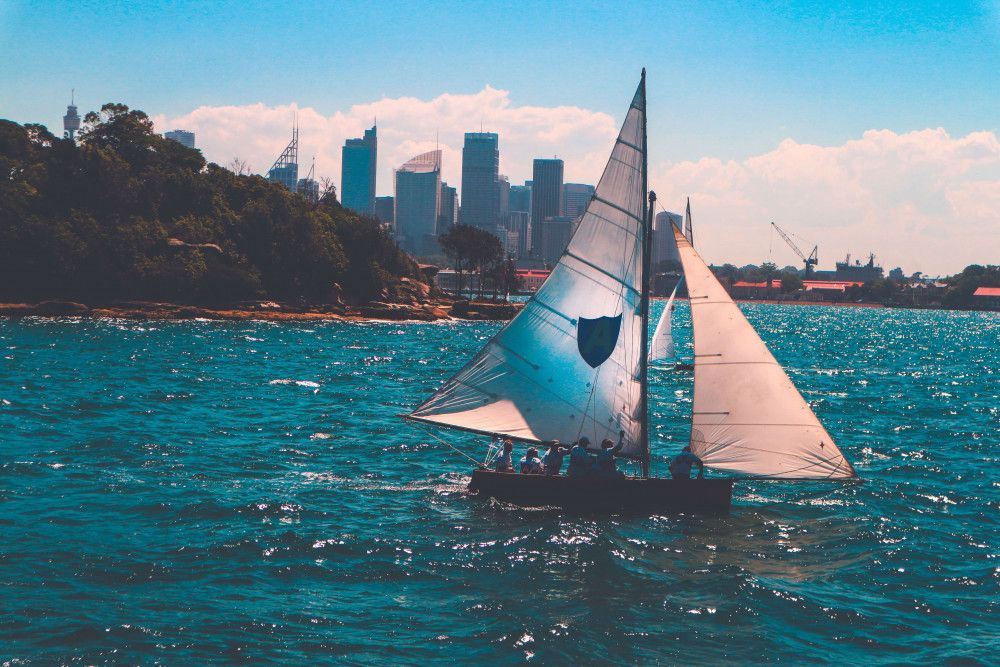
On this page:
More info on sail rig types, mast configurations and rig types, rigs with one mast, rigs with two masts, rigs with three masts, related questions.
This article is part 2 of my series on sails and rig types. Part 1 is all about the different types of sails. If you want to know everything there is to know about sails once and for all, I really recommend you read it. It gives a good overview of sail types and is easy to understand.
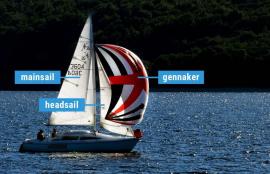
The Ultimate Guide to Sail Types and Rigs (with Pictures)
First of all, what is a sail rig? A sail rig is the way in which the sails are attached to the mast(s). In other words, it's the setup or configuration of the sailboat. The rig consists of the sail and mast hardware. The sail rig and sail type are both part of the sail plan. We usually use the sail rig type to refer to the type of boat.
Let's start by taking a look at the most commonly used modern sail rigs. Don't worry if you don't exactly understand what's going on. At the end of this article, you'll understand everything about rig types.
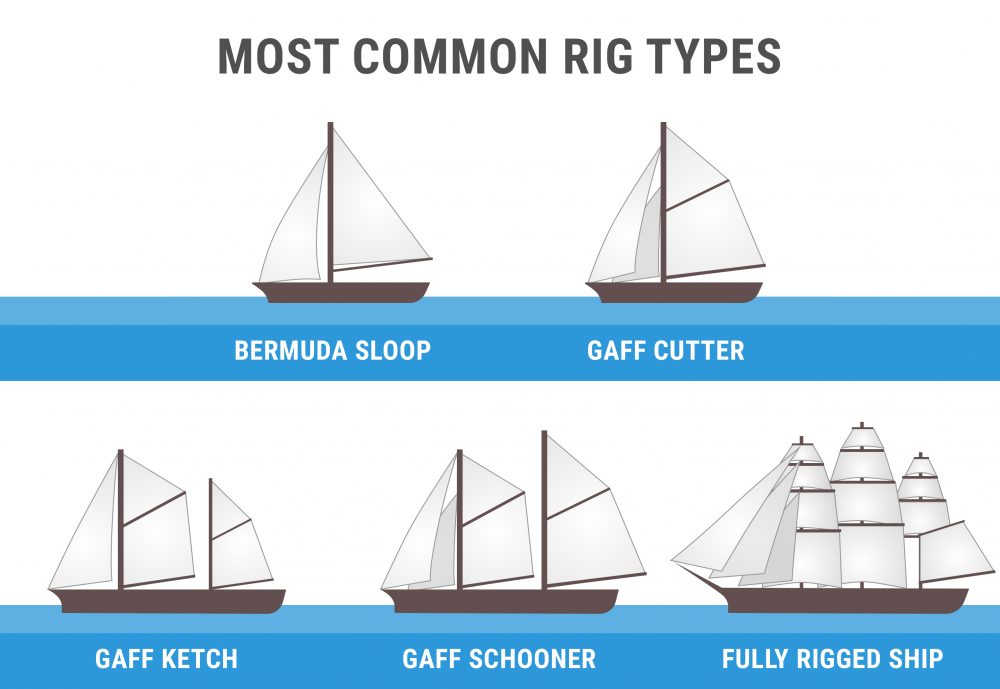
The sail rig and sail plan are often used interchangeably. When we talk of the sail rig we usually mean the sail plan . Although they are not quite the same. A sail plan is the set of drawings by the naval architect that shows the different combinations of sails and how they are set up for different weather conditions. For example a light air sail plan, storm sail plan, and the working sail plan (which is used most of the time).
So let's take a look at the three things that make up the sail plan.
The 3 things that make up the sail plan
I want to do a quick recap of my previous article. A sail plan is made up of:
- Mast configuration - refers to the number of masts and where they are placed
- Sail type - refers to the sail shape and functionality
- Rig type - refers to the way these sails are set up on your boat
I'll explore the most common rig types in detail later in this post. I've also added pictures to learn to recognize them more easily. ( Click here to skip to the section with pictures ).
How to recognize the sail plan?
So how do you know what kind of boat you're dealing with? If you want to determine what the rig type of a boat is, you need to look at these three things:
- Check the number of masts, and how they are set up.
- You look at the type of sails used (the shape of the sails, how many there are, and what functionality they have).
- And you have to determine the rig type, which means the way the sails are set up.
Below I'll explain each of these factors in more detail.
The most common rig types on sailboats
To give you an idea of the most-used sail rigs, I'll quickly summarize some sail plans below and mention the three things that make up their sail plan.
- Bermuda sloop - one mast, one mainsail, one headsail, fore-and-aft rigged
- Gaff cutter - one mast, one mainsail, two staysails, fore-and-aft rigged
- Gaff schooner - two-masted (foremast), two mainsails, staysails, fore-and-aft rigged
- Gaff ketch - two-masted (mizzen), two mainsails, staysails, fore-and-aft rigged
- Full-rigged ship or tall ship - three or more masts, mainsail on each mast, staysails, square-rigged
The first word is the shape and rigging of the mainsail. So this is the way the sail is attached to the mast. I'll go into this later on. The second word refers to the mast setup and amount of sails used.
Most sailboats are Bermuda sloops. Gaff-rigged sails are mostly found on older, classic boats. Square-rigged sails are generally not used anymore.
But first I want to discuss the three factors that make up the sail plan in more detail.
Ways to rig sails
There are basically two ways to rig sails:
- From side to side, called Square-rigged sails - the classic pirate sails
- From front to back, called Fore-and-aft rigged sails - the modern sail rig
Almost all boats are fore-and-aft rigged nowadays.
Square sails are good for running downwind, but they're pretty useless when you're on an upwind tack. These sails were used on Viking longships, for example. Their boats were quicker downwind than the boats with fore-and-aft rigged sails, but they didn't handle as well.
The Arabs first used fore-and-aft rigged sails, making them quicker in difficult wind conditions.
Quick recap from part 1: the reason most boats are fore-and-aft rigged today is the increased maneuverability of this configuration. A square-rigged ship is only good for downwind runs, but a fore-and-aft rigged ship can sail close to the wind, using the lift to move forward.
The way the sails are attached to the mast determines the shape of the sail. The square-rigged sails are always attached the same way to the mast. The fore-and-aft rig, however, has a lot of variations.
The three main sail rigs are:
- Bermuda rig - most used - has a three-sided (triangular) mainsail
- Gaff rig - has a four-sided mainsail, the head of the mainsail is guided by a gaff
- Lateen rig - has a three-sided (triangular) mainsail on a long yard
The Bermuda is the most used, the gaff is a bit old-fashioned, and the lateen rig is outdated (about a thousand years). Lateen rigs were used by the Moors. The Bermuda rig is actually based on the Lateen rig (the Dutch got inspired by the Moors).

Other rig types that are not very common anymore are:
- Junk rig - has horizontal battens to control the sail
- Settee rig - Lateen with the front corner cut off
- Crabclaw rig
Mast configuration
Okay, we know the shape of the mainsail. Now it's time to take a look at the mast configuration. The first thing is the number of masts:
- one-masted boats
- two-masted boats
- three-masted boats
- four masts or up
- full or ship-rigged boats - also called 'ships' or 'tall ships'
I've briefly mentioned the one and two mast configurations in part 1 of this article. In this part, I'll also go over the three-masted configurations, and the tall ships as well.
A boat with one mast has a straightforward configuration because there's just one mast. You can choose to carry more sails or less, but that's about it.
A boat with two masts or more gets interesting. When you add a mast, it means you have to decide where to put the extra mast: in front, or in back of the mainmast. You can also choose whether or not the extra mast will carry an extra mainsail. The placement and size of the extra mast are important in determining what kind of boat we're dealing with. So you start by locating the largest mast, which is always the mainmast.
From front to back: the first mast is called the foremast. The middle mast is called the mainmast. And the rear mast is called the mizzenmast.

What is the mizzenmast? The mizzenmast is the aft-most (rear) mast on a sailboat with three or more masts or the mast behind the mainmast on a boat with two masts. The mizzenmast carries the mizzen sail. On a two-masted boat, the mizzenmast is always (slightly) smaller than the mainmast. What is the purpose of the mizzen sail? The mizzen sail provides more sail area and flexibility in sail plan. It can be used as a big wind rudder, helping the sailor to have more control over the stern of the ship. It pushes the stern away from the wind and forces the bow in the opposite way. This may help to bring the bow into the wind when at anchor.
I always look at the number of masts first, because this is the easiest to spot. So to make this stuff more easy to understand, I've divided up the rig types based on the number of masts below.
Why would you want more masts and sail anyways?
Good question. The biggest advantage of two masts compared to one (let's say a ketch compared to a sloop), is that it allows you to use multiple smaller sails to get the same sail area. It also allows for shorter masts.
This means you reduce the stress on the rigging and the masts, which makes the ketch rig safer and less prone to wear and tear. It also doesn't capsize as quickly. So there are a couple of real advantages of a ketch rig over a sloop rig.
In the case of one mast, we look at the number of sails it carries.
Boats with one mast can have either one sail, two sails, or three or more sails.
Most single-masted boats are sloops, which means one mast with two sails (mainsail + headsail). The extra sail increases maneuverability. The mainsail gives you control over the stern, while the headsail gives you control over the bow.
Sailor tip: you steer a boat using its sails, not using its rudder.
The one-masted rigs are:
- Cat - one mast, one sail
- Sloop - one mast, two sails
- Cutter - one mast, three or more sails
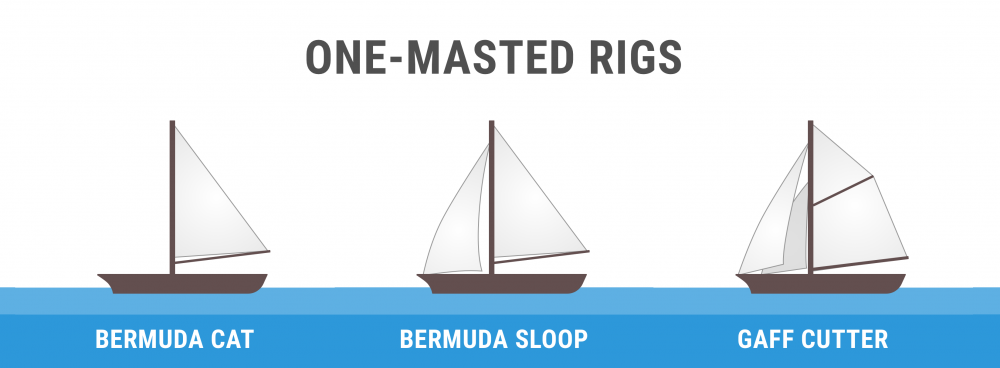
The cat is the simplest sail plan and has one mast with one sail. It's easy to handle alone, so it's very popular as a fishing boat. Most (very) small sailboats are catboats, like the Sunfish, and many Laser varieties. But it has a limited sail area and doesn't give you the control and options you have with more sails.
The most common sail plan is the sloop. It has one mast and two sails: the main and headsail. Most sloops have a Bermuda mainsail. It's one of the best racing rigs because it's able to sail very close to the wind (also called 'weatherly'). It's one of the fastest rig types for upwind sailing.
It's a simple sail plan that allows for high performance, and you can sail it short-handed. That's why most sailboats you see today are (Bermuda) sloops.
This rig is also called the Marconi rig, and it was developed by a Dutch Bermudian (or a Bermudian Dutchman) - someone from Holland who lived on Bermuda.
A cutter has three or more sails. Usually, the sail plan looks a lot like the sloop, but it has three headsails instead of one. Naval cutters can carry up to 6 sails.
Cutters have larger sail area, so they are better in light air. The partition of the sail area into more smaller sails give you more control in heavier winds as well. Cutters are considered better for bluewater sailing than sloops (although sloops will do fine also). But the additional sails just give you a bit more to play with.
Two-masted boats can have an extra mast in front or behind the mainmast. If the extra mast is behind (aft of) the mainmast, it's called a mizzenmast . If it's in front of the mainmast, it's called a foremast .
If you look at a boat with two masts and it has a foremast, it's most likely either a schooner or a brig. It's easy to recognize a foremast: the foremast is smaller than the aft mast.
If the aft mast is smaller than the front mast, it is a sail plan with a mizzenmast. That means the extra mast has been placed at the back of the boat. In this case, the front mast isn't the foremast, but the mainmast. Boats with two masts that have a mizzenmast are most likely a yawl or ketch.
The two-masted rigs are:
- Lugger - two masts (mizzen), with lugsail (a cross between gaff rig and lateen rig) on both masts
- Yawl - two masts (mizzen), fore-and-aft rigged on both masts. Main mast is much taller than mizzen. Mizzen without a mainsail.
- Ketch - two masts (mizzen), fore-and-aft rigged on both masts. Main mast with only slightly smaller mizzen. Mizzen has mainsail.
- Schooner - two masts (foremast), generally gaff rig on both masts. Main mast with only slightly smaller foremast. Sometimes build with three masts, up to seven in the age of sail.
- Bilander - two masts (foremast). Has a lateen-rigged mainsail and square-rigged sails on the foremast and topsails.
- Brig - two masts (foremast), partially square-rigged. The main mast carries small lateen-rigged sail.

The yawl has two masts that are fore-and-aft rigged and a mizzenmast. The mizzenmast is much shorter than the mainmast, and it doesn't carry a mainsail. The mizzenmast is located aft of the rudder and is mainly used to increase helm balance.
A ketch has two masts that are fore-and-aft rigged. The extra mast is a mizzenmast. It's nearly as tall as the mainmast and carries a mainsail. Usually, the mainsails of the ketch are gaff-rigged, but there are Bermuda-rigged ketches too. The mizzenmast is located in front of the rudder instead of aft, as on the yawl.
The function of the ketch's mizzen sail is different from that of the yawl. It's actually used to drive the boat forward, and the mizzen sail, together with the headsail, are sufficient to sail the ketch. The mizzen sail on a yawl can't really drive the boat forward.
Schooners have two masts that are fore-and-aft rigged. The extra mast is a foremast which is generally smaller than the mainmast, but it does carry a mainsail. Schooners are also built with a lot more masts, up to seven (not anymore). The schooner's mainsails are generally gaff-rigged.
The schooner is easy to sail but not very fast. It handles easier than a sloop, except for upwind, and it's only because of better technology that sloops are now more popular than the schooner.
The brig has two masts. The foremast is always square-rigged. The mainmast can be square-rigged or is partially square-rigged. Some brigs carry a lateen mainsail on the mainmast, with square-rigged topsails.
Some variations on the brig are:
Brigantine - two masts (foremast), partially square-rigged. Mainmast carries no square-rigged mainsail.
Hermaphrodite brig - also called half brig or schooner brig. Has two masts (foremast), partially square-rigged. Mainmast carries a gaff rig mainsail and topsail, making it half schooner.
Three-masted boats are mostly barques or schooners. Sometimes sail plans with two masts are used with more masts.
The three-masted rigs are:
- Barque - three masts, fore, and mainmast are square-rigged, the mizzenmast is usually gaff-rigged. All masts carry mainsail.
- Barquentine - three masts, foremast is square-rigged, the main and mizzenmast are fore-and-aft rigged. Also called the schooner barque.
- Polacca - three masts, foremast is square-rigged, the main and mizzenmast are lateen-rigged.
- Xebec - three masts, all masts are lateen-rigged.

A barque has three or four masts. The fore and mainmast are square-rigged, and the mizzen fore-and-aft, usually gaff-rigged. Carries a mainsail on each mast, but the mainsail shape differs per mast (square or gaff). Barques were built with up to five masts. Four-masted barques were quite common.
Barques were a good alternative to full-rigged ships because they require a lot fewer sailors. But they were also slower. Very popular rig for ocean crossings, so a great rig for merchants who travel long distances and don't want 30 - 50 sailors to run their ship.
Barquentine
The barquentine usually has three masts. The foremast is square-rigged and the main and mizzenmast fore-and-aft. The rear masts are usually gaff-rigged.
Faster than a barque or a schooner, but the performance is worse than both.
The polacca or polacre rig has three masts with a square-rigged foremast. The main and mizzenmast are lateen-rigged. Beautiful boat to see. Polacca literally means 'Polish' (it's Italian). It was a popular rig type in the Mediterranean in the 17th century. It looks like the xebec, which has three lateen-rigged masts.
Fun fact: polaccas were used by a Dutch sailor-turned-Turkish-pirate (called Murat Reis).
The xebec is a Mediterranean trading ship with three masts. All masts are lateen-rigged. I couldn't find any surviving xebecs, only models and paintings. So I guess this rig is outdated a long time.
A boat with three or more masts that all carry square-rigged sails is called a ship, a tall ship, or a full-rigged ship. So it's at this point that we start calling boats 'ships'. It has nothing to do with size but with the type of rigging.
More sails mean less stress on all of them. These ships use a lot of sails to distribute the forces, which reduces the stress on the rigging and the masts. Square sails mean double the sail area in comparison to triangular sails.
They are quite fast for their size, and they could outrun most sloops and schooners (schooners were relatively a lot heavier). The reason is that tall ships could be a lot longer than sloops, giving them a lot of extra hull speed. Sloops couldn't be as large because there weren't strong enough materials available. Try making a single triangular sail with a sail area of over 500 sq. ft. from linen.
So a lot of smaller sails made sense. You could have a large ship with a good maximum hull speed, without your sails ripping apart with every gust of wind.
But you need A LOT of sailors to sail a tall ship: about 30 sailors in total to ie. reef down sails and operate the ship. That's really a lot.
Tall ships are used nowadays for racing, with the popular tall ship races traveling the world. Every four years I go and check them out when they are at Harlingen (which is very close to where I live).
Check out the amazing ships in this video of the tall ship races last year near my hometown. (The event was organized by friends of mine).
What is the difference between a schooner and a sloop? A schooner has two masts, whereas the sloop only has one. The schooner carries more sails, with a mainsail on both masts. Also, sloops are usually Bermuda-rigged, whereas schooners are usually gaff-rigged. Most schooners also carry one or two additional headsails, in contrast to the single jib of the sloop.
What do you call a two-masted sailboat? A two-masted sailboat is most likely a yawl, ketch, schooner, or brig. To determine which one it is you have to locate the mainmast (the tallest). At the rear: schooner or brig. In front: yawl or ketch. Brigs have a square-rigged foremast, schooners don't. Ketches carry a mainsail on the rear mast; yawls don't.
What is a sloop rig? A sloop rig is a sailboat with one mast and two sails: a mainsail and headsail. It's a simple sail plan that handles well and offers good upwind performance. The sloop rig can be sailed shorthanded and is able to sail very close to the wind, making it very popular. Most recreational sailboats use a sloop rig.
What is the difference between a ketch and a yawl? The most important difference between a ketch and a yawl are the position and height of the mizzenmast. The mizzenmast on a yawl is located aft of the rudder, is shorter than the mainmast and doesn't carry a mainsail. On a ketch, it's nearly as long as the mainmast and carries a mainsail.

There are a wonderful lots of DIY changeability shows on the cable airwaves these days.
Rick the rigger
There are SO many errors on this site it really should be taken down.
First major mistake is to say you are no longer afraid of the sea.
One that truly gets up my nose is the term ‘fully’ rigged ship. It’s a FULL rigged ship!! Your mast names are the wrong way round and just because there may be 3 it doesn’t automatically mean the one in the middle is the main.
I could go on and totally destroy your over inflated but fragile ego but I won’t. All I will say is go learn a lot more before posting.
Shawn Buckles
Thanks for your feedback. If you like to point out anything more specific, please let me know and I will update the articles. I’ve changed fully-rigged to full-rigged ship - which is a typo on my part. I try to be as concise as I can, but, obviously, we all make mistakes every now and then. The great thing about the internet is that we can learn from each other and update our knowledge together.
If you want to write yourself and share your knowledge, please consider applying as a writer for my blog by clicking on the top banner.
Thanks, Shawn
Well, I feel that I’ve learned a bit from this. The information is clear and well laid out. Is it accurate? I can’t see anything at odds with the little I knew before, except that I understood a xebec has a square rigged centre mainmast, such as the Pelican ( https://www.adventureundersail.com/ )
Hi, Shawn, You forgot (failed) to mention another type of rig? The oldest type of rig known and still functions today JUNK RIG!
Why are so many of the comments here negative. I think it is wonderful to share knowledge and learn together. I knew a little about the subject (I’m an Aubrey-Maturin fan!) but still found this clarified some things for me. I can’t comment therefore on the accuracy of the article, but it seems clear to me that the spirit of the author is positive. We owe you some more bonhomme I suggest Shawn.
As they say in the Navy: “BZ” - for a good article.
Been reading S.M. Stirling and wanted to understand the ship types he references. Thank you, very helpful.
This site is an awesome starting point for anyone who would like to get an overview of the subject. I am gratefull to Shawn for sharing - Thanks & Kudos to you! If the negative reviewers want to get a deeper technical knowledge that is accurate to the n-th then go study the appropriate material. Contribute rather than destroy another’s good work. Well done Shawn. Great job!
Good stuff Shawn - very helpful. As a novice, it’s too confusing to figure out in bits and pieces. Thanks for laying it out.
First of all I have to say that Rick ‘the rigger’ is obviously the one with the “over inflated but fragile ego” and I laughed when you suggested he share his knowledge on your blog, well played!
As for the content it’s great, hope to read more soon!
Alec Lowenthal
Shawn, I have a painting of a Spanish vessel, two masted, with. Lateen sails on both masts and a jib. The mainsail is ahead of the main mast (fore) and the other is aft of the mizzen mast. Would this be what you call lugger rig? I have not seen a similar picture. Thanks, Alec.
Thank you for your article I found easy to read and understand, and more importantly remember, which emphasises the well written.. Pity about the negative comments, but love your proactive responses!
This vessel, “SEBASTIAN” out of Garrucha, Almería, España, was painted by Gustave Gillman in 1899.
Sorry, picture not accepted!
Thank you for a very informative article. I sail a bit and am always looking for more knowledge. I like the way you put forth your info and I feel if you can’t say anything positive, then that person should have their own blog or keep their opinions to their-self. I will be looking for more from you. I salute your way of dealing with negative comments.
Thank you for a great intro to sailing boats! I searched different sailboats because I use old sails tp make bags and wanted to learn the difference. Way more than I ever expected. Thanks for all the work put in to teach the rest of us.
Your description of a cutter is lacking, and your illustrations of “cutters” are actually cutter-rigged sloops. On a true cutter, the mast is moved further aft (with more than 40% of the ship forward of the mast). A sloop uses tension in the backstay to tension the luff of the foresail. The cutter can’t do this.
Also, a bermuda-rigged ketch will have a line running from the top of the mainmast to the top of the mizzenmast.
wow great guide to rig types! thanks
Interesting guide, however I am confused about the description of the brig. You say the main mast on a brig can have a lateen sail, but in your picture it looks like a gaff sail to me. How is it a lateen sail?
Hi Shawn, thank you for taking the time to share this information. It is clear and very helpful. I am new to sailing and thinking of buying my own blue water yacht. The information you have supplied is very useful. I still am seeking more information on performance and safety. Please keep up the good work. Best Regards
mickey fanelli
I’m starting to repair a model sailboat used in the lake I have three masts that have long been broken off and the sails need replacement. So my question is there a special relationship between the three masts I do have reminents of where the masts should go. they all broke off the boat along with the sails I can figure out where they go because of the old glue marks but it makes no sense. or does it really matter on a model thank you mickey
Cool, total novice here. I have learnt a lot. Thanks for sharing - the diagrams along with the text make it really easy to understand, especially for a beginner who hasn’t even stepped on a sailing boat.
Daryl Beatt
Thank you. Cleared up quite a few things for me. For example, I was familiar with the names “Xebecs” and “Polaccas” from recent reading about the Barbary War. I had gathered that the two Barbary types were better suited to sailing in the Med, but perhaps they were less able to be adaptable to military uses,(but one might assume that would be ok if one plans to board and fight, as opposed to fight a running gun duel). Specifically, the strangely one sided August 1, 1801 battle between the USS Enterprise under Lt. John Sterett and the Polacca cruiser Tripoli under Admiral Rais Mahomet Rous. On paper both ships seemed nearly equal in size, guns and crew, but pictures of the battle are confusing. While the Enterprise is usually rendered as the familiar schooner, the polacca Tripoli has been pictured in radically different ways. Thus the Wikipedia picture by Hoff in 1878 used to illustrate the Battle shows a Brig design for Tripoli, indicating 77 years later, polaccas were no longer common.
Lee Christiansen
I am curious as to what you would call a modern race boat with a fractional jib,not equipped for full masthead hoist? Thanks Lee
Thanks Guy: The information and pictures really eliminate a lot of the mystery of the terminology and the meanings. Also appreciate the insight of the handling idiosyncrasies “hand” (staff) requirements to manage a vessel for one that has not been on the water much. I long to spend significant time afloat, but have concern about the ability to handle a vessel due to advancing age. The Significant Other prefers to sit (in AC comfort)and be entertained by parties of cruise line employees. Thanks again for the information.
Gordon Smith
Your discussion made no mention of the galleon, a vessel with either square-rigged Fore and Main masts and a shorter lateen-rigged Mizzen, or, on larger galleons, square-rigged Fore and Main masts, with a lateen-rigged Mizzen and a lateen-rigged Bonaventure mast, both shorter than either the Fore or Main masts. Also, it was not uncommon for a galleon to hoist a square-rigged bowsprit topsail in addition to the usual square-rigged spritsail.
Leave a comment
You may also like.
What's that sail for? Generally, I don't know. So I've come up with a system. I'll explain you everything there is to know about sails and rigs in this article.

17 Sailboat Types Explained: How To Recognize Them

Different Types of Sailing and Racing Explained
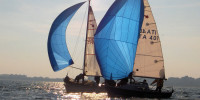
How Are Sail Numbers Assigned? (And how to pick yours)

COMMENTS
Leech: Back edge of the sail. Tack: The lower front corner of the sail. Clew: The bottom back corner of the sail. Foot: Bottom of the sail. There are two sail shapes, the fore-and-aft rigged sails, and square-rigged sails. Nowadays, fore-and-aft sails are more popular, have better performance and maneuverability.
In front of the main mast is called a foremast. The 5 most common two-masted rigs are: Lugger - two masts (mizzen), with lugsail (cross between gaff rig and lateen rig) on both masts. Yawl - two masts (mizzen), fore-and-aft rigged on both masts. Main mast much taller than mizzen. Mizzen without mainsail.
Sloop. A sloop is by far the most popular configuration. It features a single mast, double sail (the mainsail and the headsail), and mast configuration. The headsail is located from the forestay on the mast to the top of it. The type of headsail used can also vary from a genoa, a spinnaker, or a gennaker sail.
A sloop-rigged sailboat typically features a mainsail, a headsail, and an additional light-wind sail, such as a spinnaker or Gennaker. The mainsail is rigged aft of the mast, while the headsail is attached to the forestay. The two most commonly used headsails are the Genoa and Jib. The sails are vital parts of a sailboat since you obviously ...
Especially since some of these terms date back to prehistoric times and are kept around for the sole purpose of elitism. So to help you navigate this world for which you often need a dictionary, here is one. These are sail names explained for beginners. Here are the 15 most common sails: Mainsail. Foresail.
5. Gennaker. As the name suggests, the Gennaker sail combines a spinnaker and a Genoa sail. They are as large as the spinnaker, although they're not symmetrical. They come in handy whenever the wind changes from a pure dead run to a reaching point of sail, as sailors can navigate various wind types with the same sail.
Mainsails are essential for providing the boat with forward propulsion and play a significant role in steering and balancing the vessel. There are two primary types of mainsails: full-batten and partial-batten. Full-batten mainsails have horizontal battens that run the entire width of the sail, providing additional support and shape.
Spinnaker sails are a type of downwind sail that can be used to increase boat speed when sailing in light winds. They are typically used in wind conditions below 10 knots, which are considered light air sails. Spinnakers come in two types: symmetrical and asymmetrical. Author: Ken Heaton CC BY-SA-4..
Type of Sails Names: Decoding the Terminology. Mainsail and Foresail. The mainsail, as mentioned earlier, is the principal sail that catches the wind to move the boat forward. Foresail is a general term that includes various sails positioned near the bow of the sailboat, such as the jib and genoa. Genoa and Jib.
A sail, which is a large piece of fabric that is attached to a long pole called the mast, uses the wind to pull a sailboat across the water. It has various parts, such as the head, tack, clew, luff, leech, foot, mainsail, jib, and batten. These components determine the shape and efficiency of the sail.
Material: Most modern mainsails are made of Dacron (polyester), but high-performance options might use laminate or Kevlar for added strength and durability. Size: Varies based on boat size. A 30-foot sailboat may have a mainsail of around 250-300 square feet. Price: A Dacron mainsail for a 30-foot boat typically costs $2,500 - $3,500. Performance materials can cost upwards of $5,000.
As a general setup, sailboats will use three common sails, including headsail, mainsail, and specialty sail. Due to the varying wind conditions and the model of the sailboat, there are many types of sails including jib, genoa, trysail, storm jib, code zero, gennaker, and spinnaker. While that sounds like too many models of sails, you can easily ...
The mainsail, headsail (or jib), genoa, spinnaker, and gennaker are the most popular types of sails on sailboats. There are also a number of different configurations when considering the type of sail and mast in use including a sloop, fractional rig sloop, cutter, ketch, schooner, yawl, and cat. Simply put, different sailboat sails serve ...
https://improvesailing.com/sails - If you want to learn the different sail types for sailboats, this video is for you. I've done a ton of research to learn ...
Spinnaker is a different type of sail due to the functions it performs on the movement of the boat. It is designed for sailing off the wind from reaching the downwind. As the boat is in motion, the spinnaker is filled up with wind creating a balloon like shape. It has a construction that is purely made out of lightweight fabric like the nylon.
Bermuda Rig - Also known as a Marconi rig, this is the typical configuration of most modern sailboats. It has been used since the 17th century and remains one of the most efficient types of rigs. The rig revolves around setting a triangular sail aft of the mast with the head raised to the top of the mast.
Short answer: Names of sails on a sailboat: Sails on a sailboat are commonly referred to by various names, including the mainsail, jib, genoa, spinnaker, staysail, and mizzen. Each sail serves a specific purpose in harnessing wind power for propulsion. Understanding the Basics: A Guide to the Names of Sails on a SailboatUnderstanding the Basics:
June 17, 2024. Sailboats are powered by sails using the force of the wind. They are also referred to as sailing dinghies, boats, and yachts, depending on their size. Sailboats range in size, from lightweight dinghies like the Optimist dinghy (7'9") all the way up to mega yachts over 200 feet long. The length is often abbreviated as LOA (length ...
Leech - The sail's back edge. Foot - The bottom edge of the sail. Tack - Between the luff and the foot is the tack. The tack is attached to the boat or a spar. Head - The corner at the top of the sail between the luff and the leech. Clew - The third triangle of a sail between the leech and the foot. Batten - Solid slats or rods to ...
The most common kind of sailboat is the sloop, as it's simple to operate and versatile. Other common sailboat types include the schooner, cutter, cat, ketch, schooner, catamaran, and trimaran. Other sailboat variations include pocket cruisers, motorsailers, displacement, and shoal-draft vessels. The information found in this article is sourced ...
Sailboat Rig Options. A sailing vessel's rig refers to its configuration of masts, sails, and rigging. Different names are applied to different rig configurations. Examples of rigs include the schooner rig, cutter rig, and junk rig, among others. Rigs can generally be categorized as "fore-and-aft," "square," or a combination of both.
NASA's testing a solar sail system in space, and the spacecraft that brought the tech there has snapped a photo. On April 23, NASA launched a solar sail protype to orbit around our planet — a ...
The mast is the long, standing pole holding the sails. It is typically placed just off-center of a sailboat (a little bit to the front) and gives the sailboat its characteristic shape. The mast is crucial for any sailboat: without a mast, any sailboat would become just a regular boat. The Sails. I think this segment speaks mostly for itself.
At 410 feet bow to stern and with a beam of 56 feet, Koru is the largest sailing yacht in the world. Some might argue the title should go to the 468-foot Sailing Yacht A.But that quirky, Philippe ...
The 37th America's Cup in Barcelona has a distinctly Olympic look.. While sailing Olympic medallists are once again dotted throughout the teams, crews for the sport's oldest competition this year also feature several Olympic cycling and rowing stars, like Simon van Velthooven and Hamish Bond.. They are known as cyclors, given the job of powering the sails, masts, and winches, with their ...
Summary. At 2308 on 2 October 2023, the volunteer relief cook on Pelican of London fell from the top of the vessel's gangway into the flooded drydock while under the influence of alcohol.
Jalda, the Filipov family's 16-foot sailboat, docked at Hough's Neck, in Quincy, circa 1969. From left, the author, his brother Jeff, mother Loretta, and brother Allan.
The ACS3 team first attempted to unfurl the sail on Aug. 26 but abandoned the roughly 25-minute-long procedure after an "onboard power monitor detected higher-than-expected motor currents ...
Sail. $350.00. Co-created with fashion designer Jerry Lorenzo of Fear of God, the Nike Air Fear of God basketball shoes merge proven performance attributes with the sport and street-style of luxury streetwear. Part of Lorenzo's Air Fear of God collection, the Air FOG1 is game-ready with a suede and mesh upper, Zoom Air cushioning and multiple ...
The fore-and-aft rig, however, has a lot of variations. The three main sail rigs are: Bermuda rig - most used - has a three-sided (triangular) mainsail. Gaff rig - has a four-sided mainsail, the head of the mainsail is guided by a gaff. Lateen rig - has a three-sided (triangular) mainsail on a long yard.